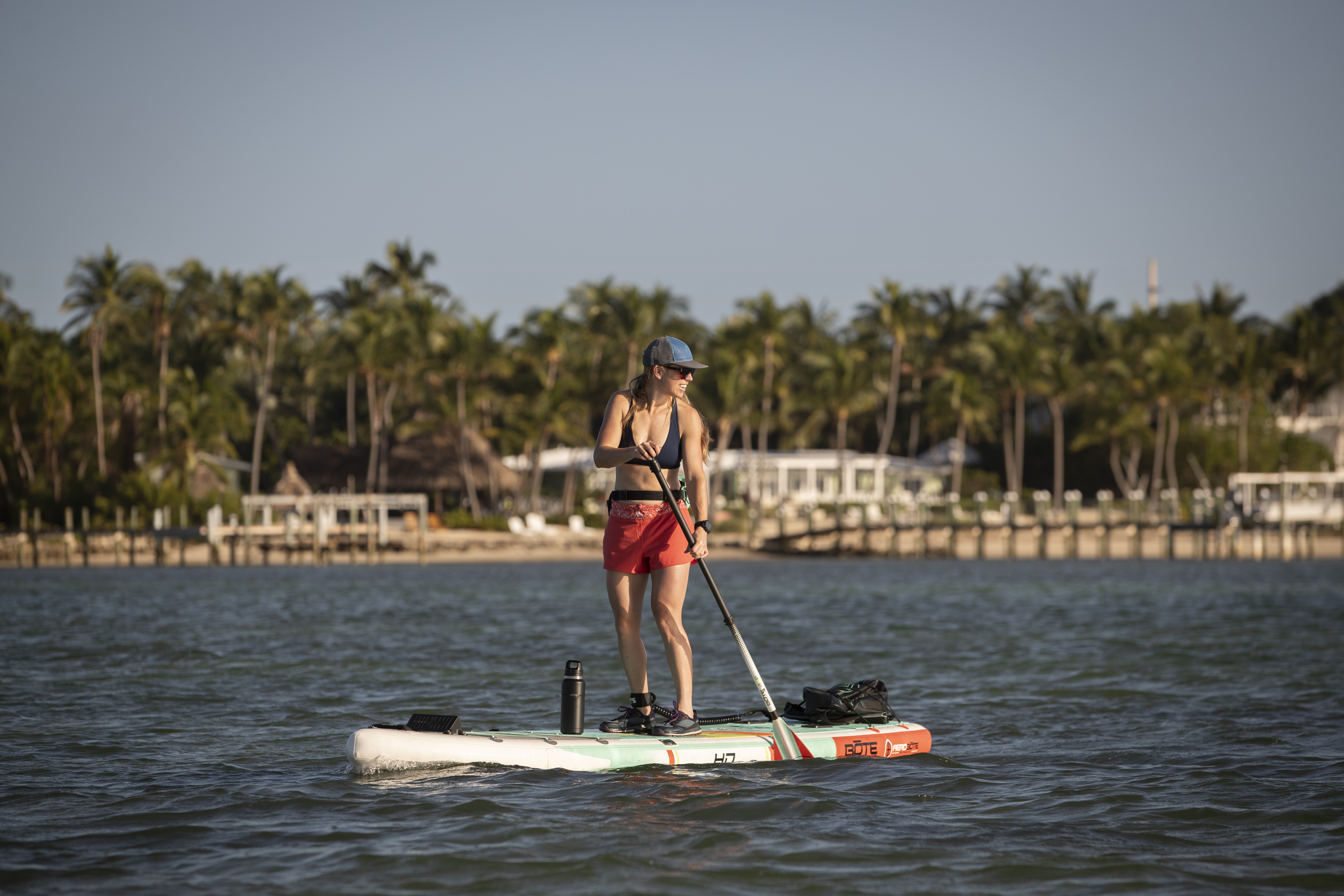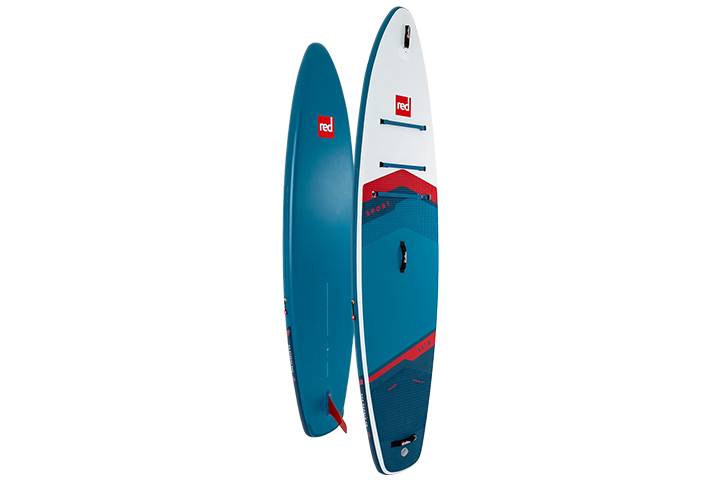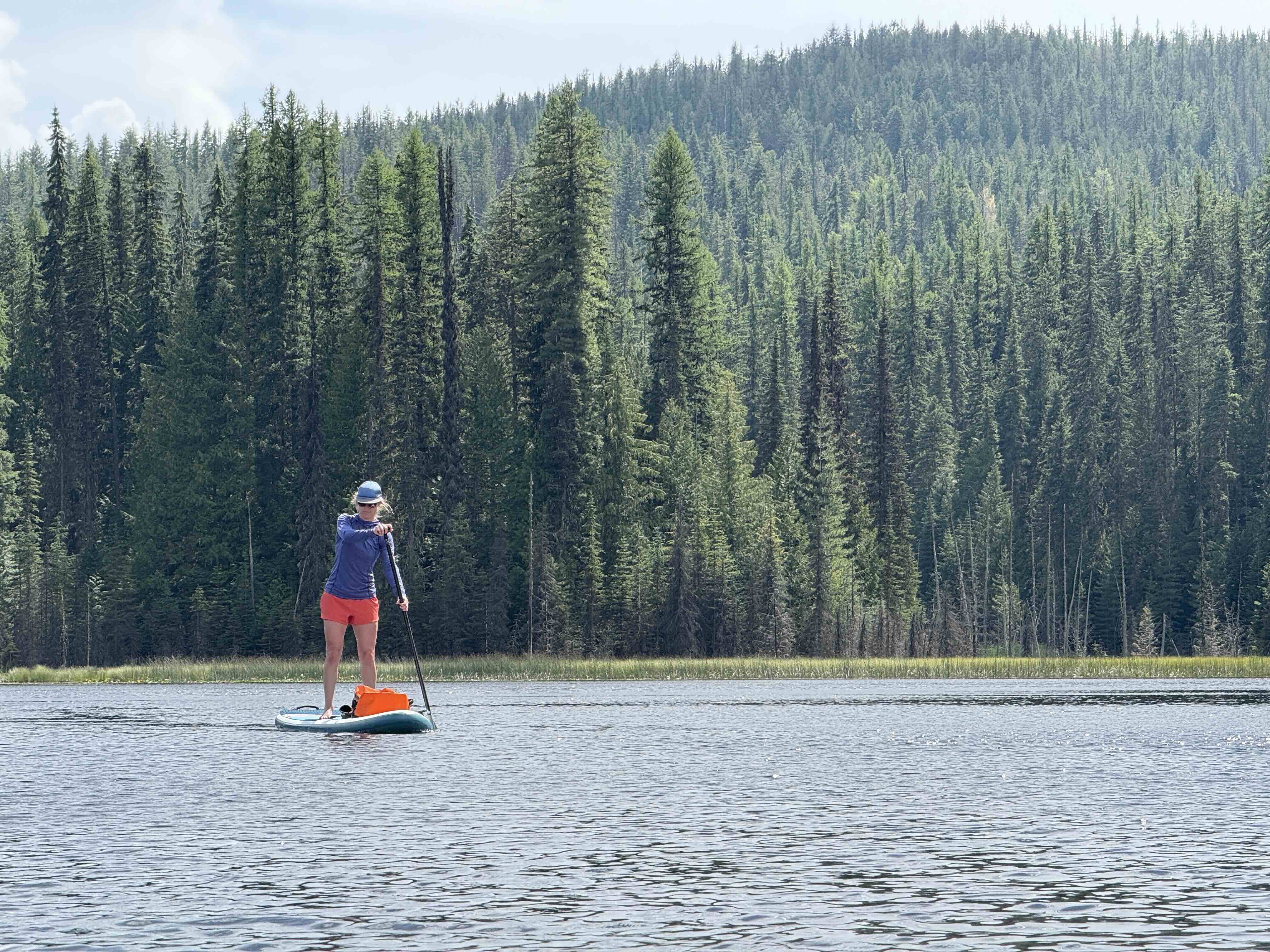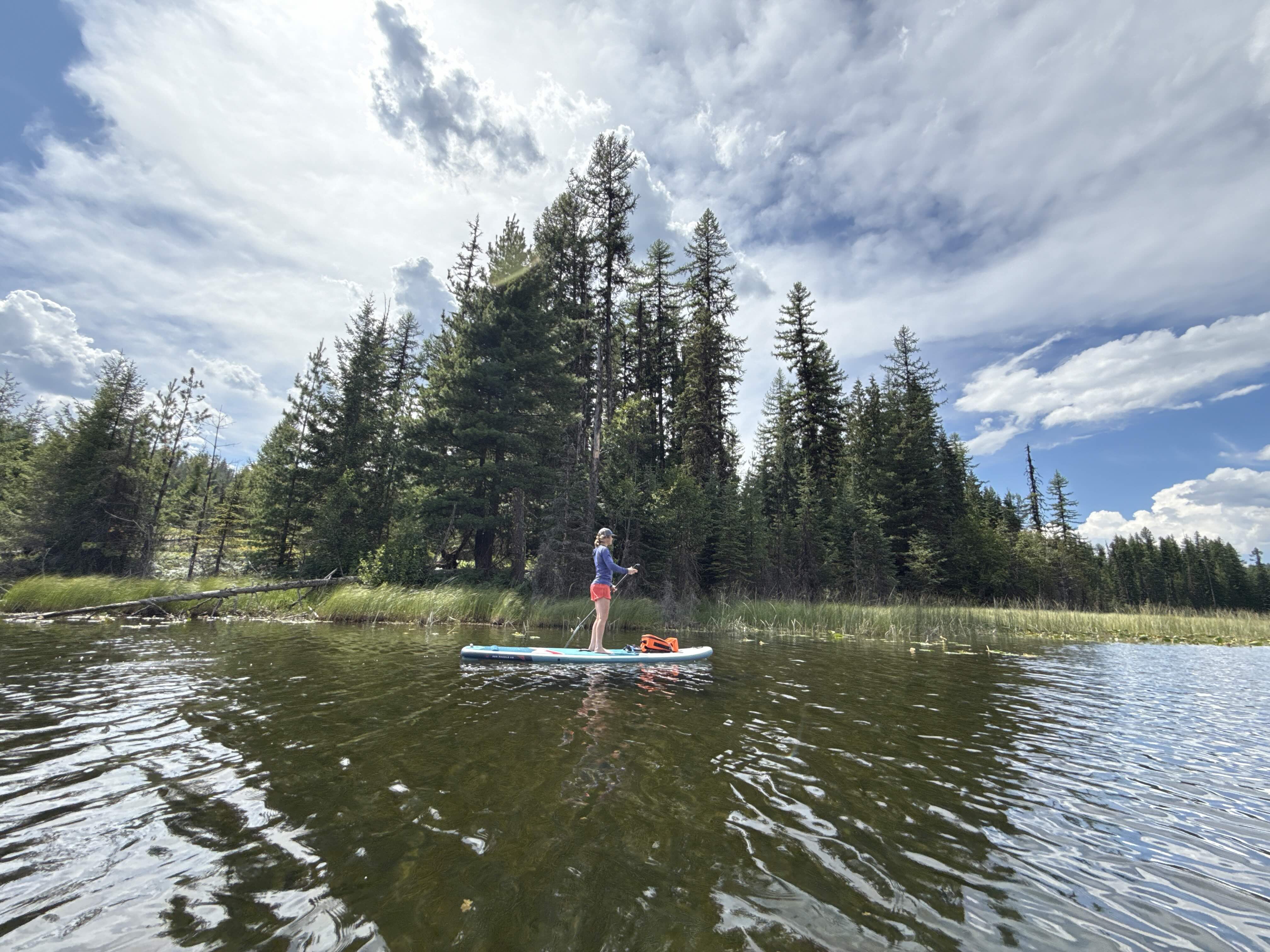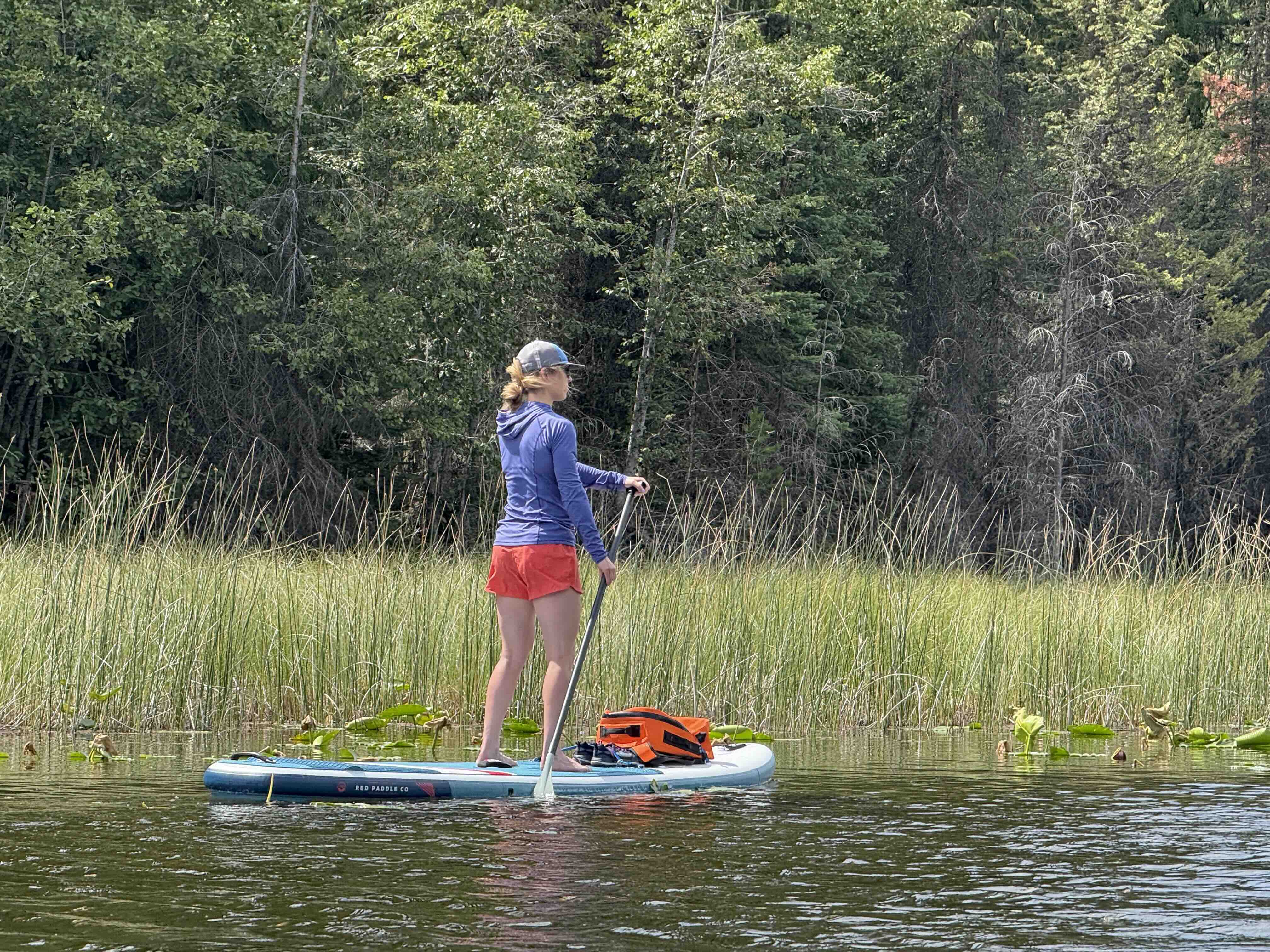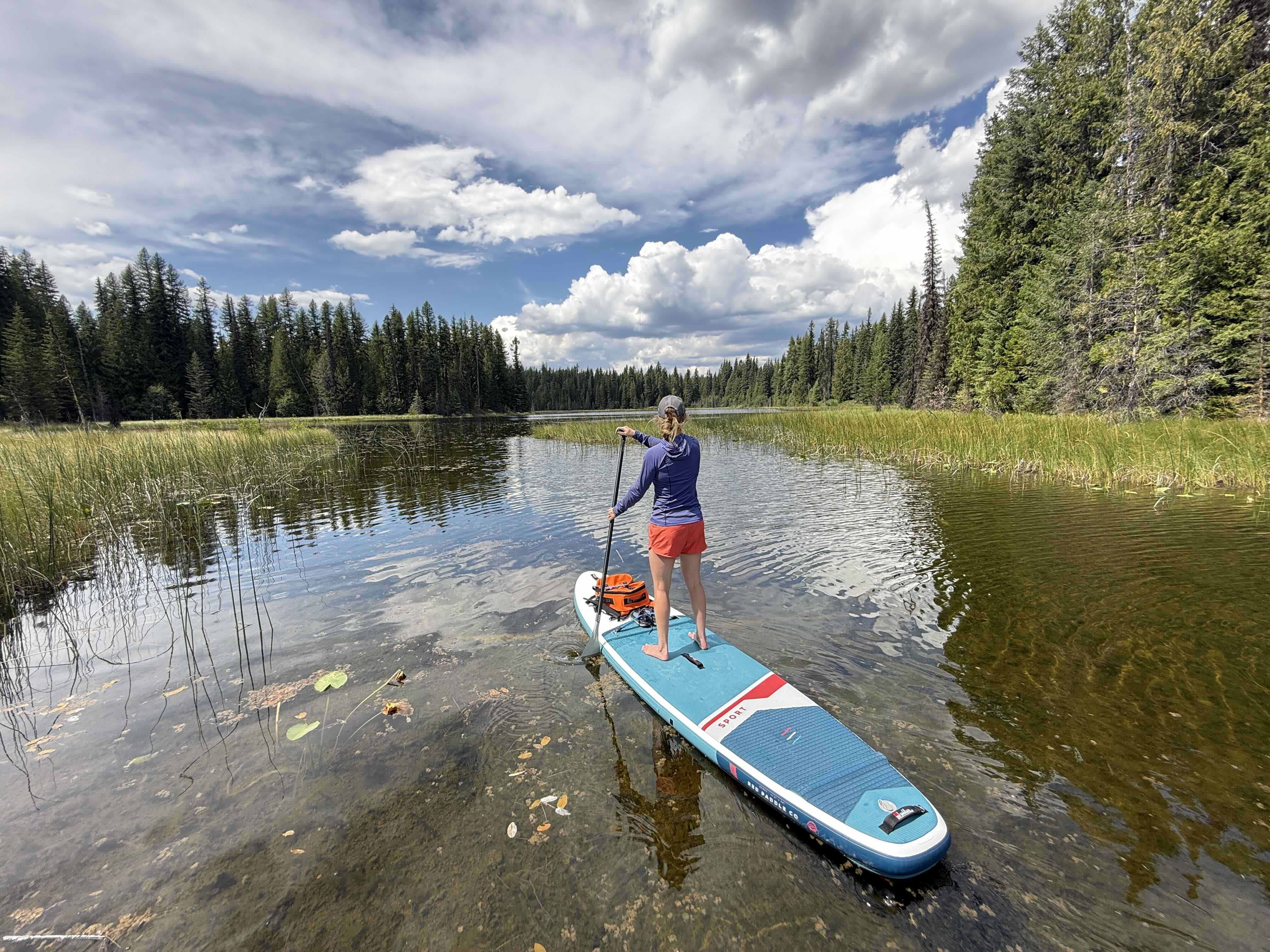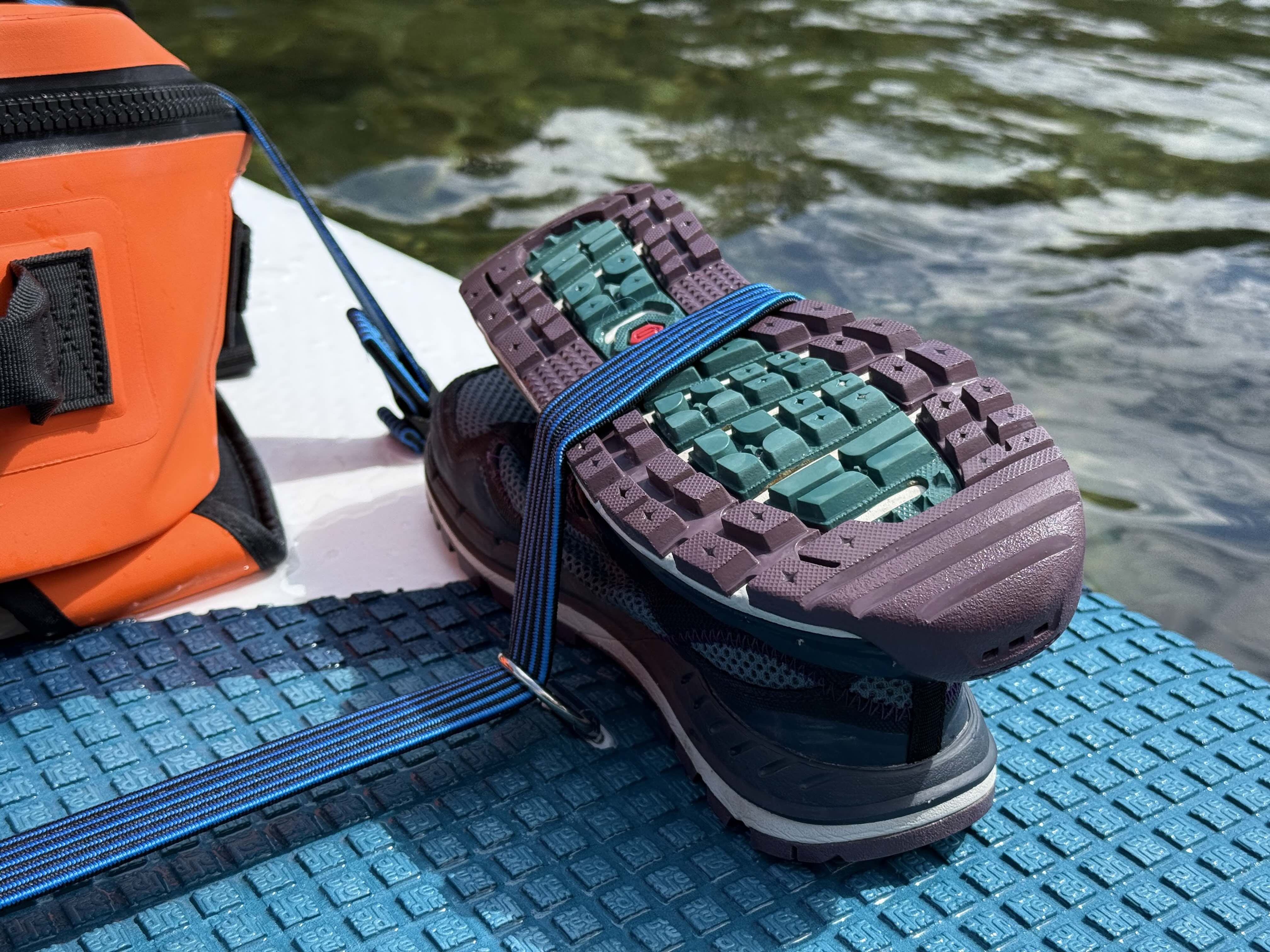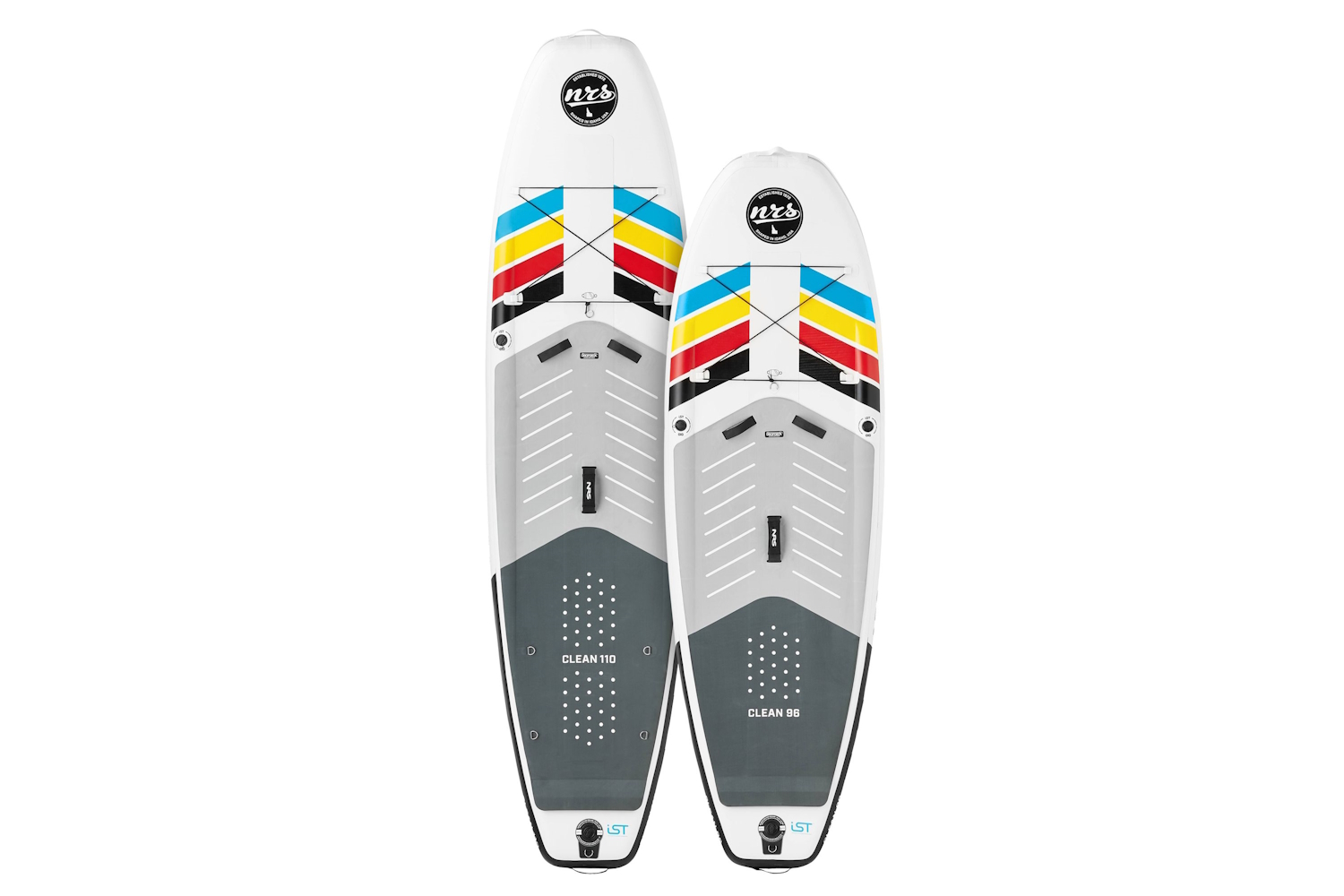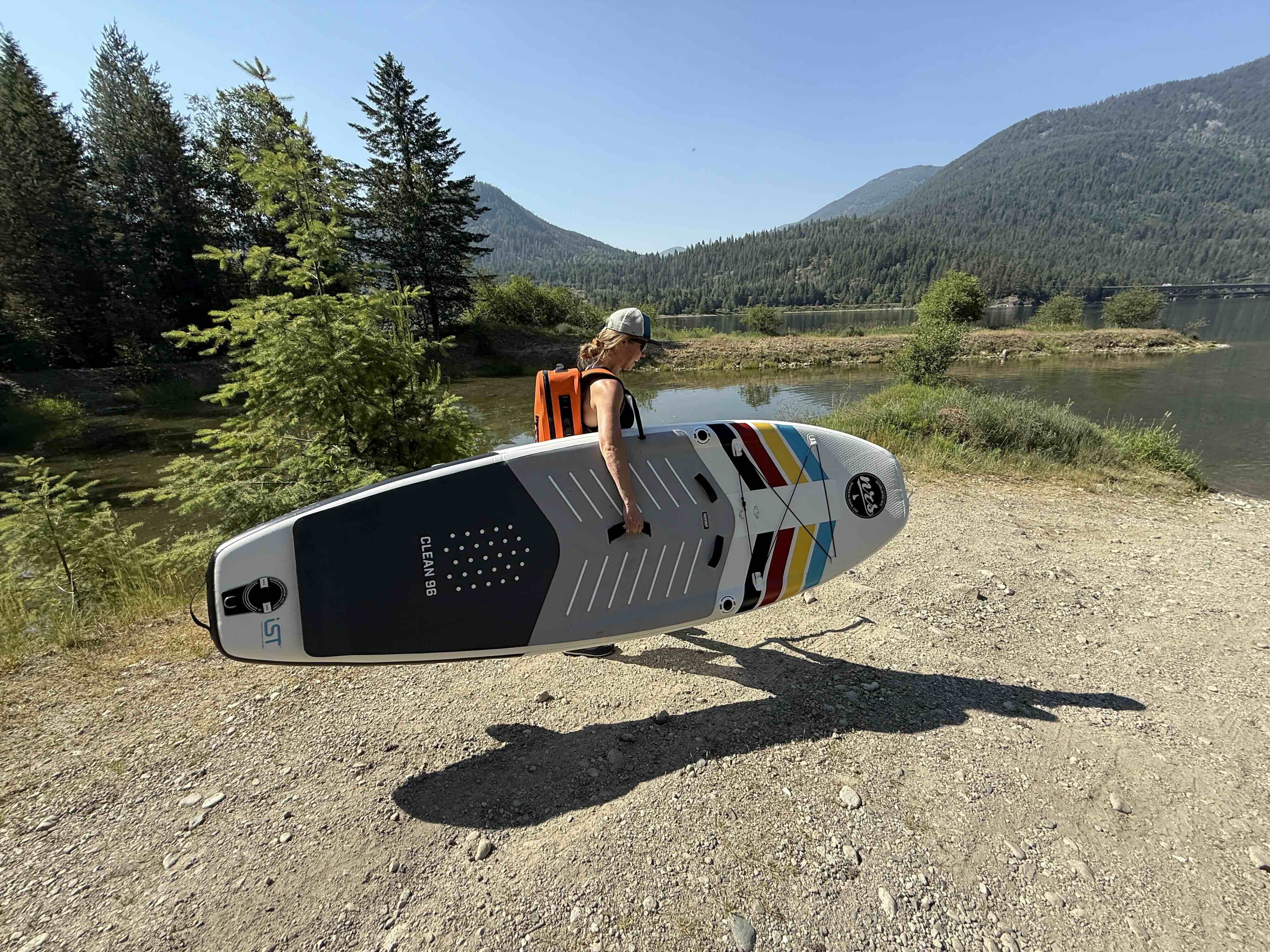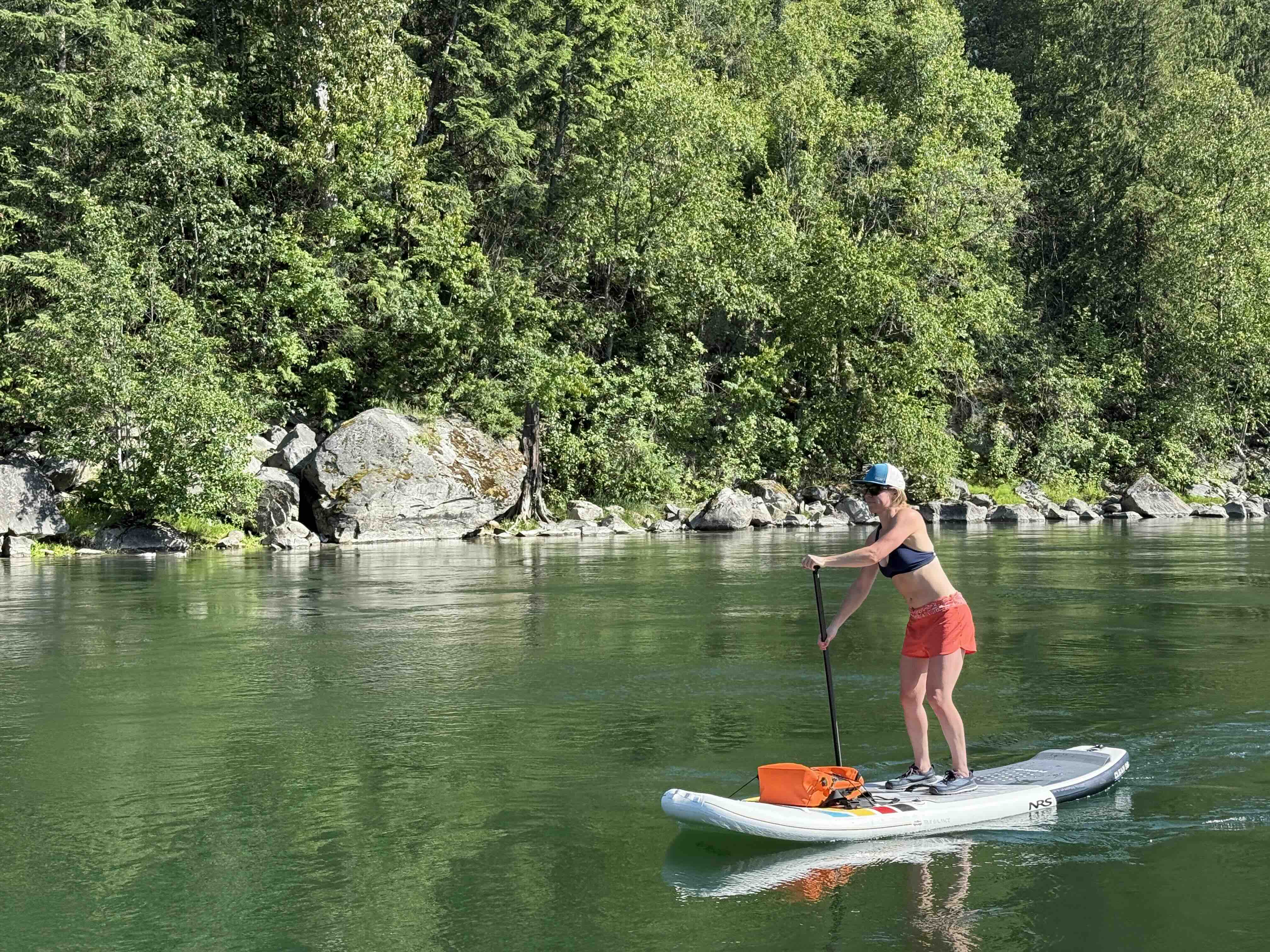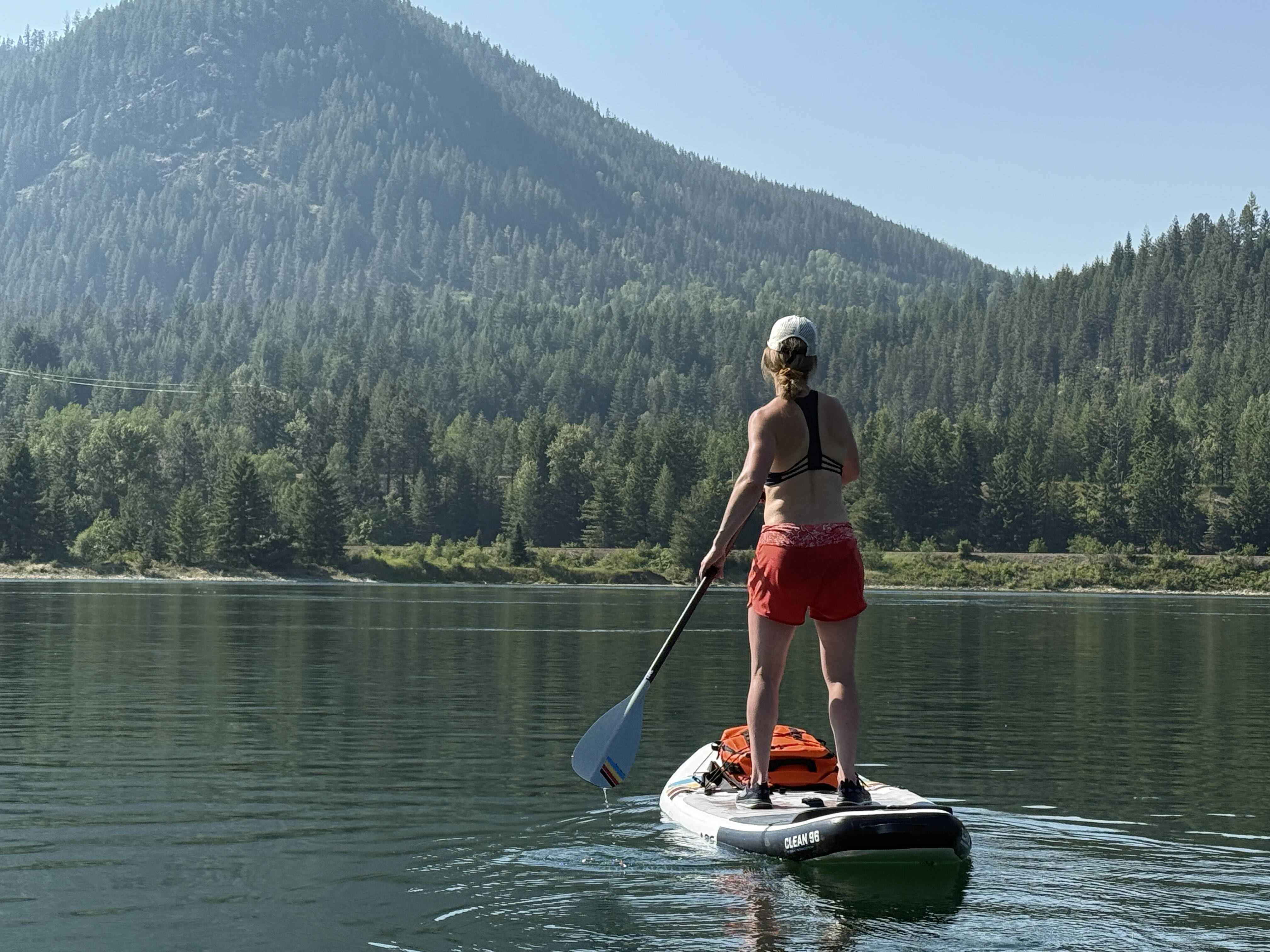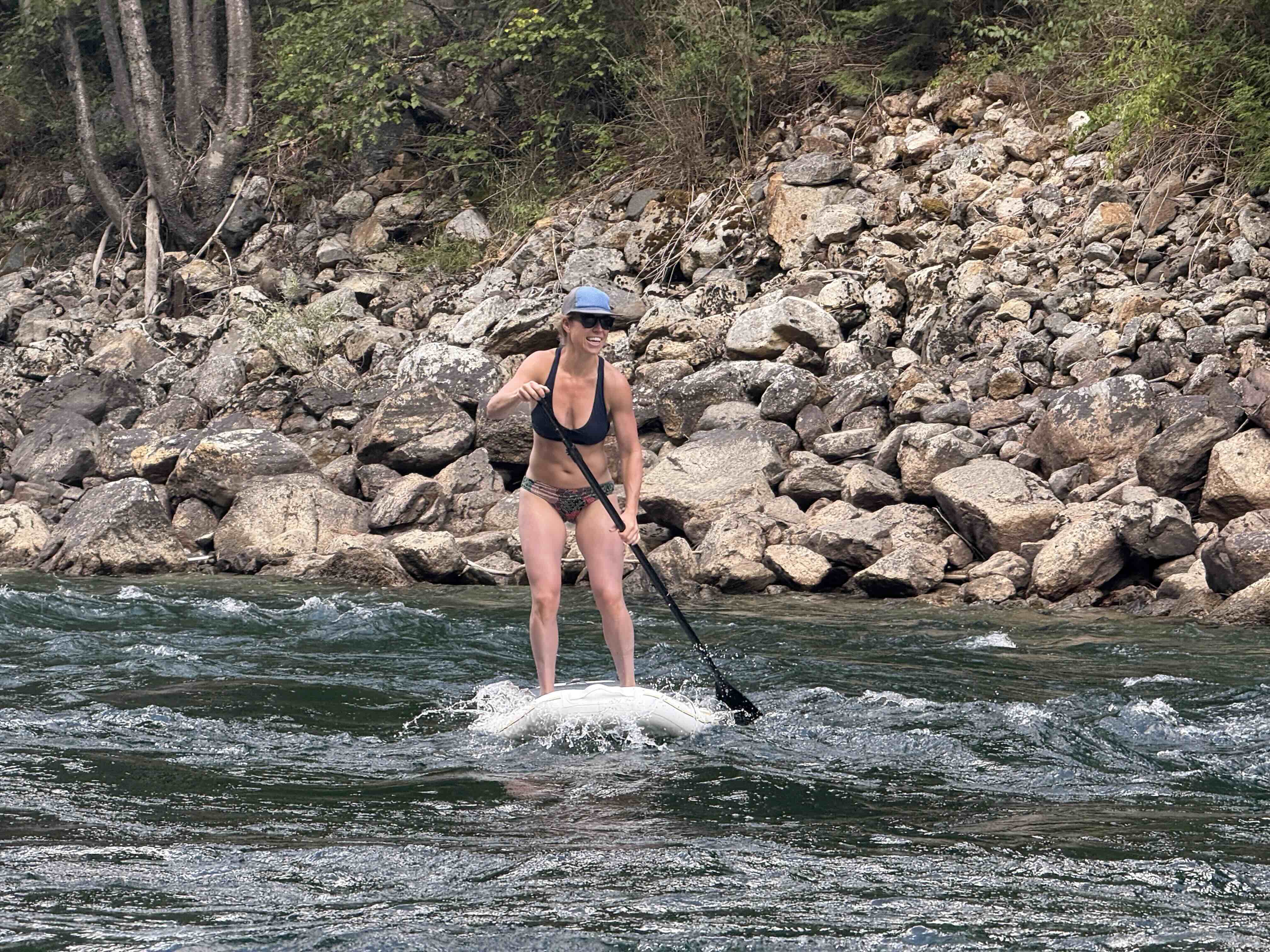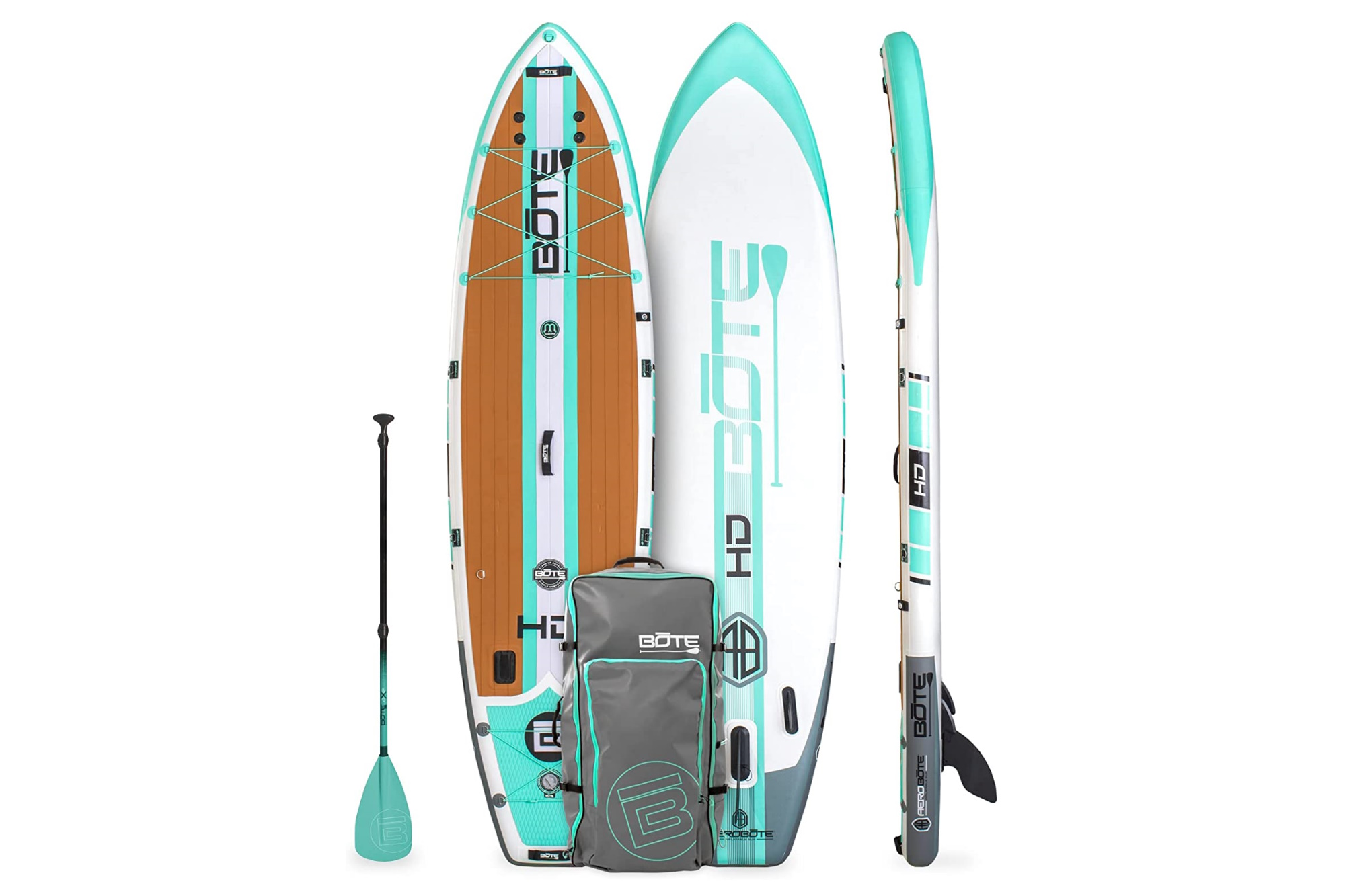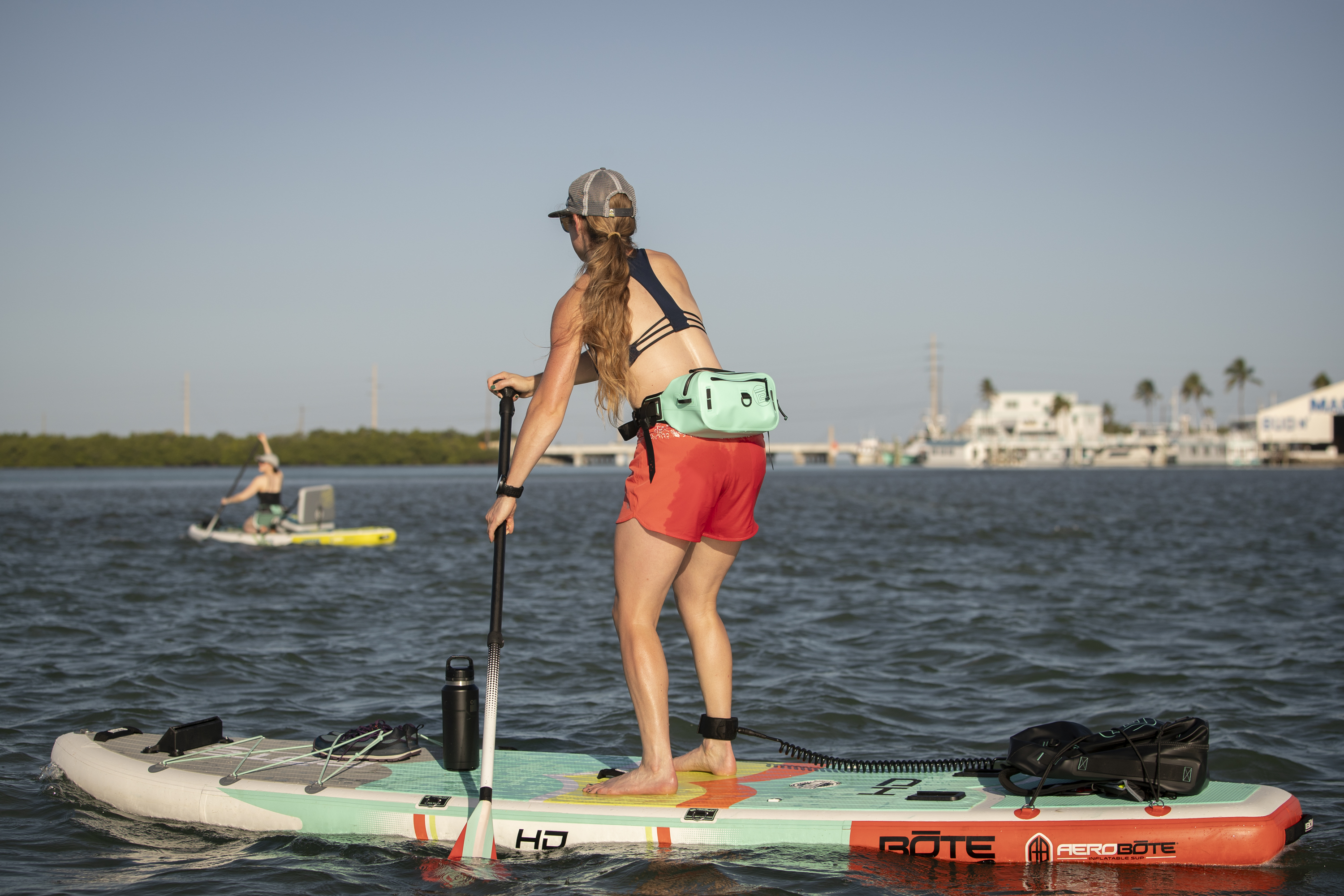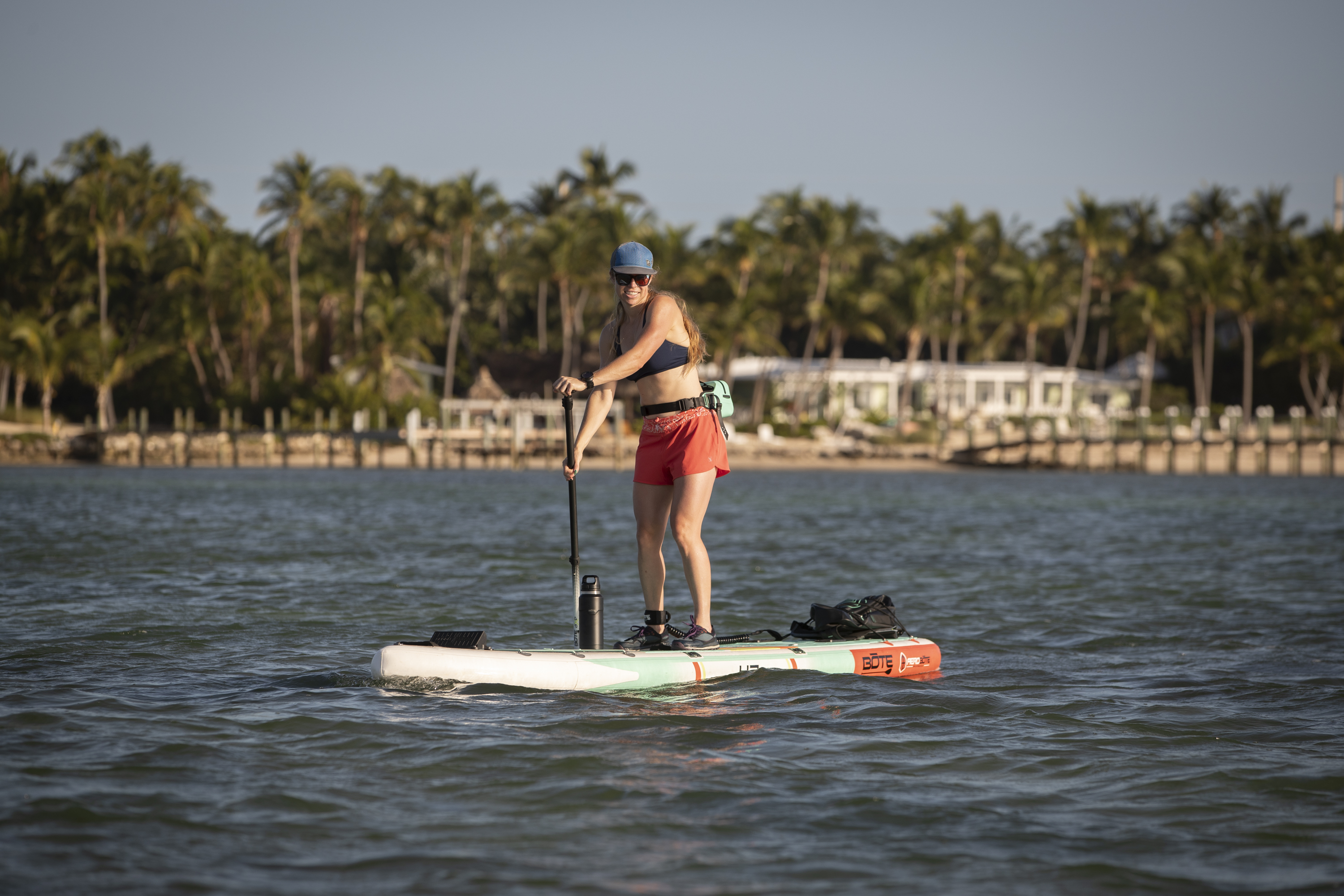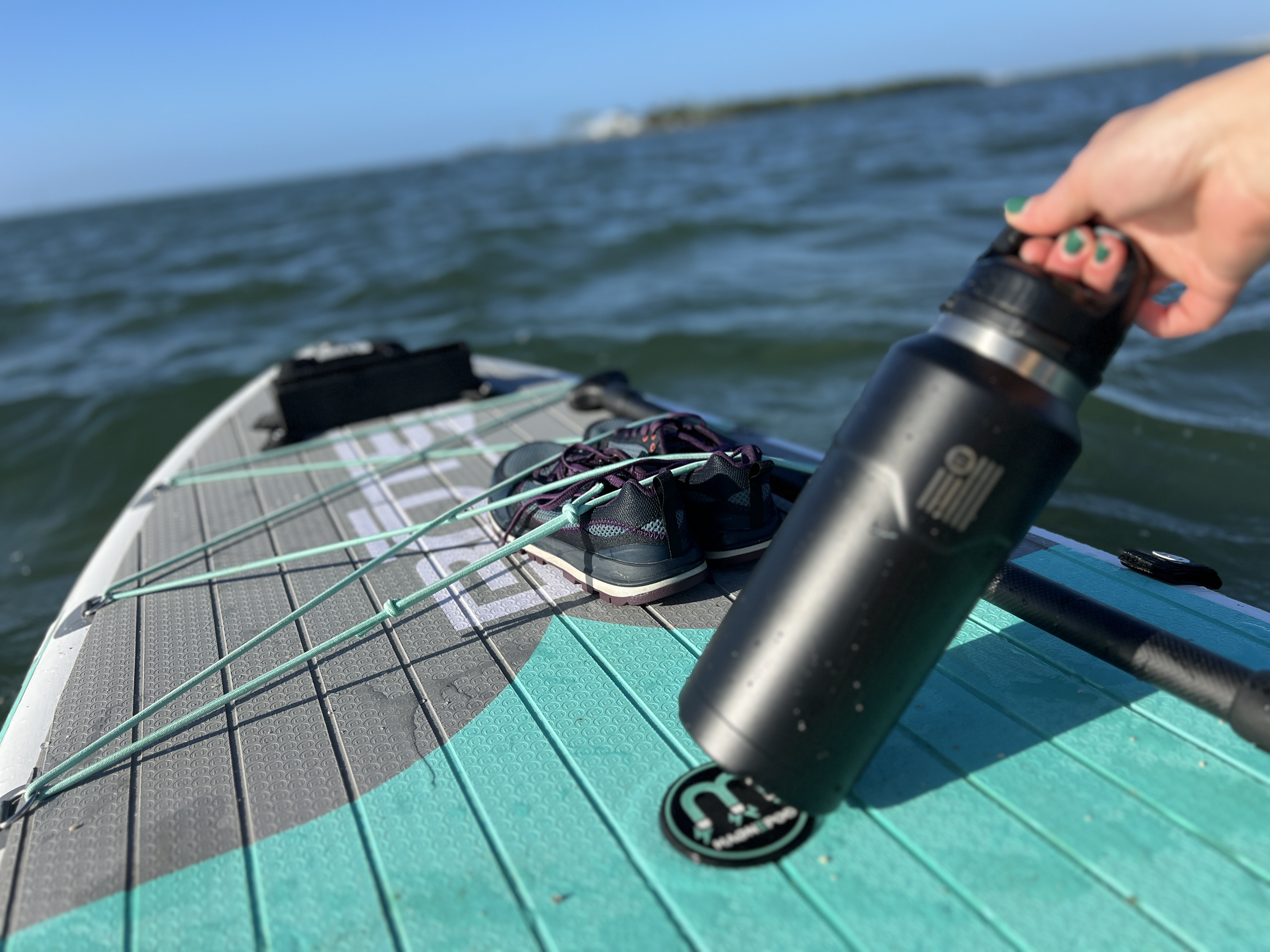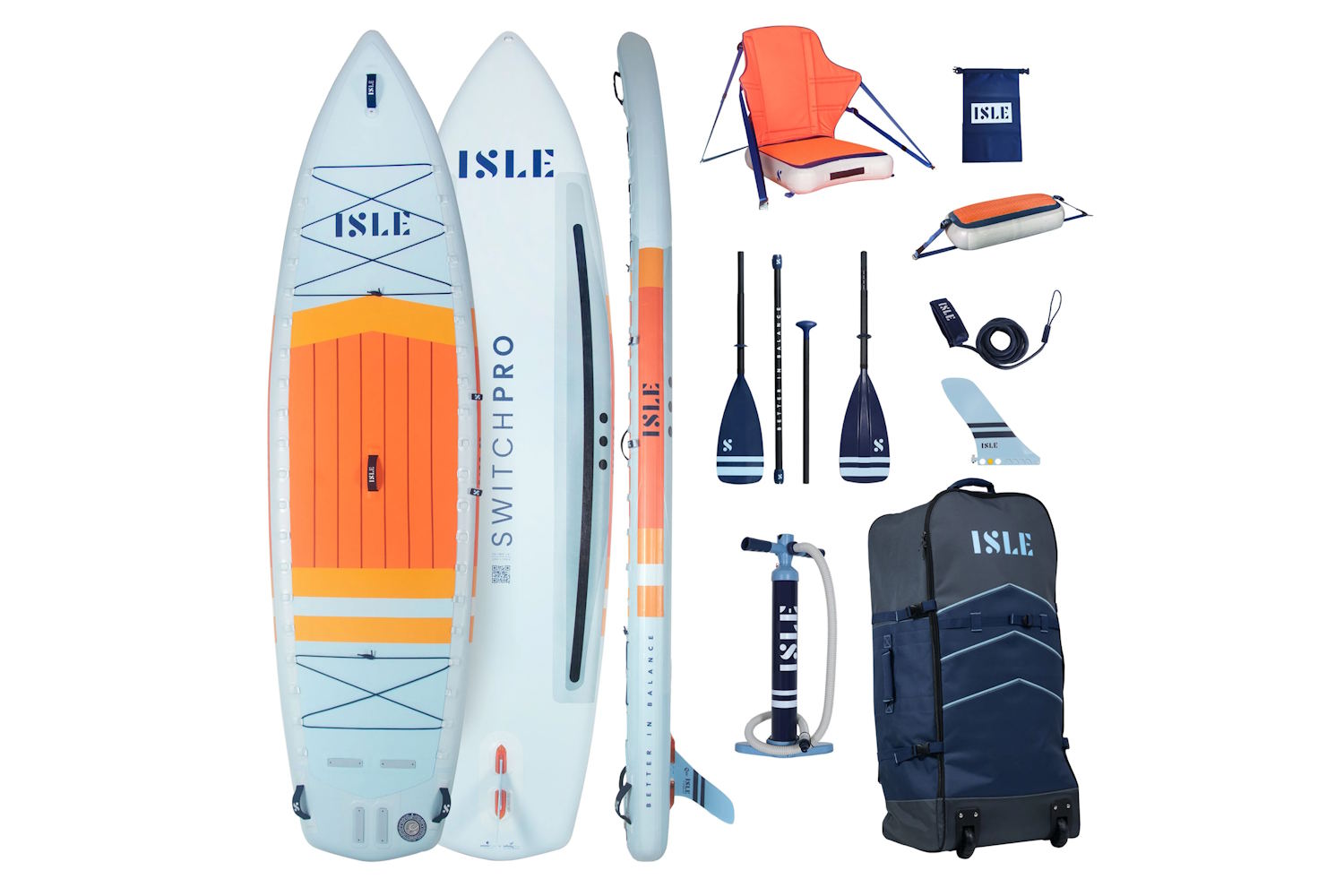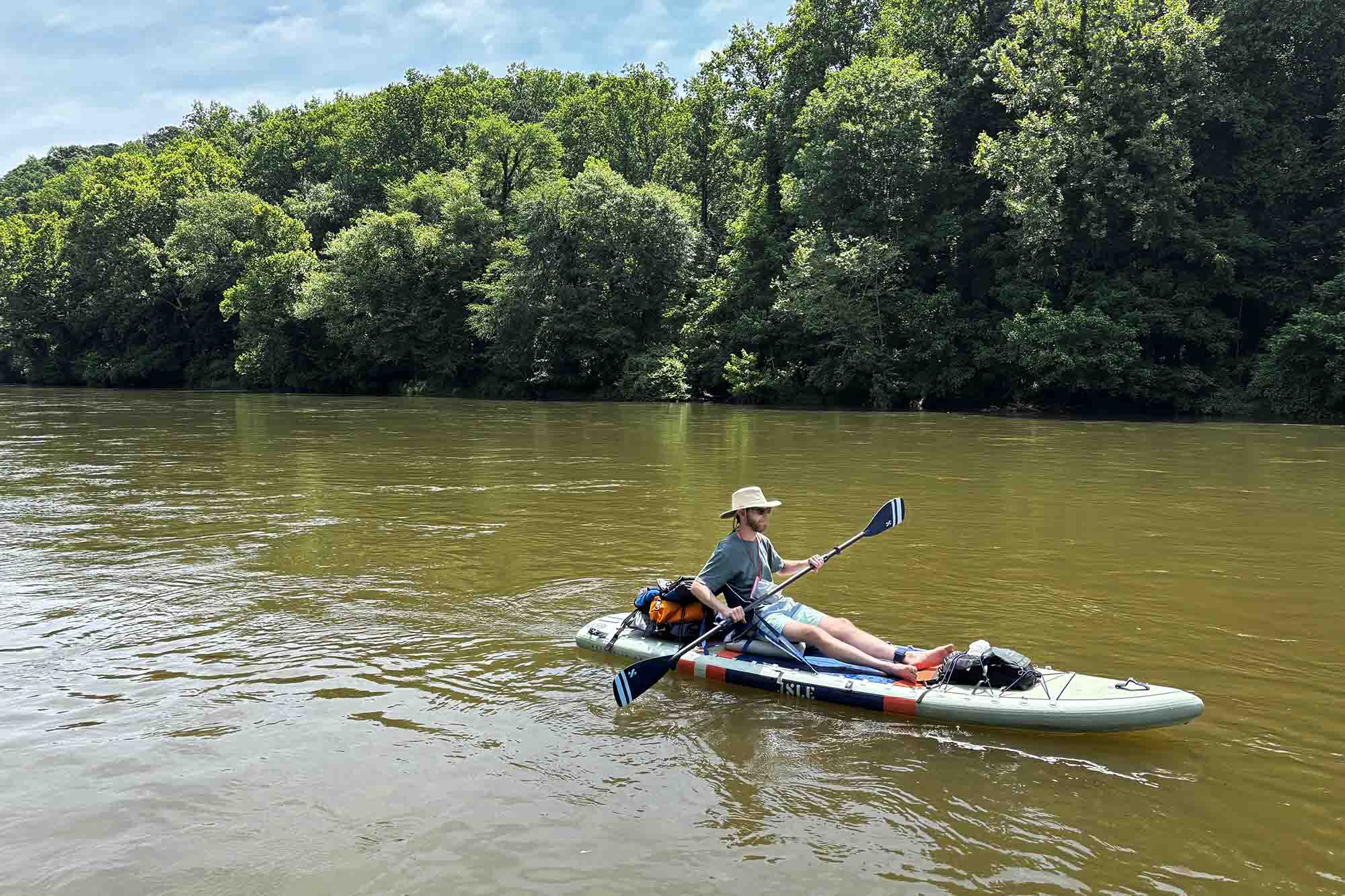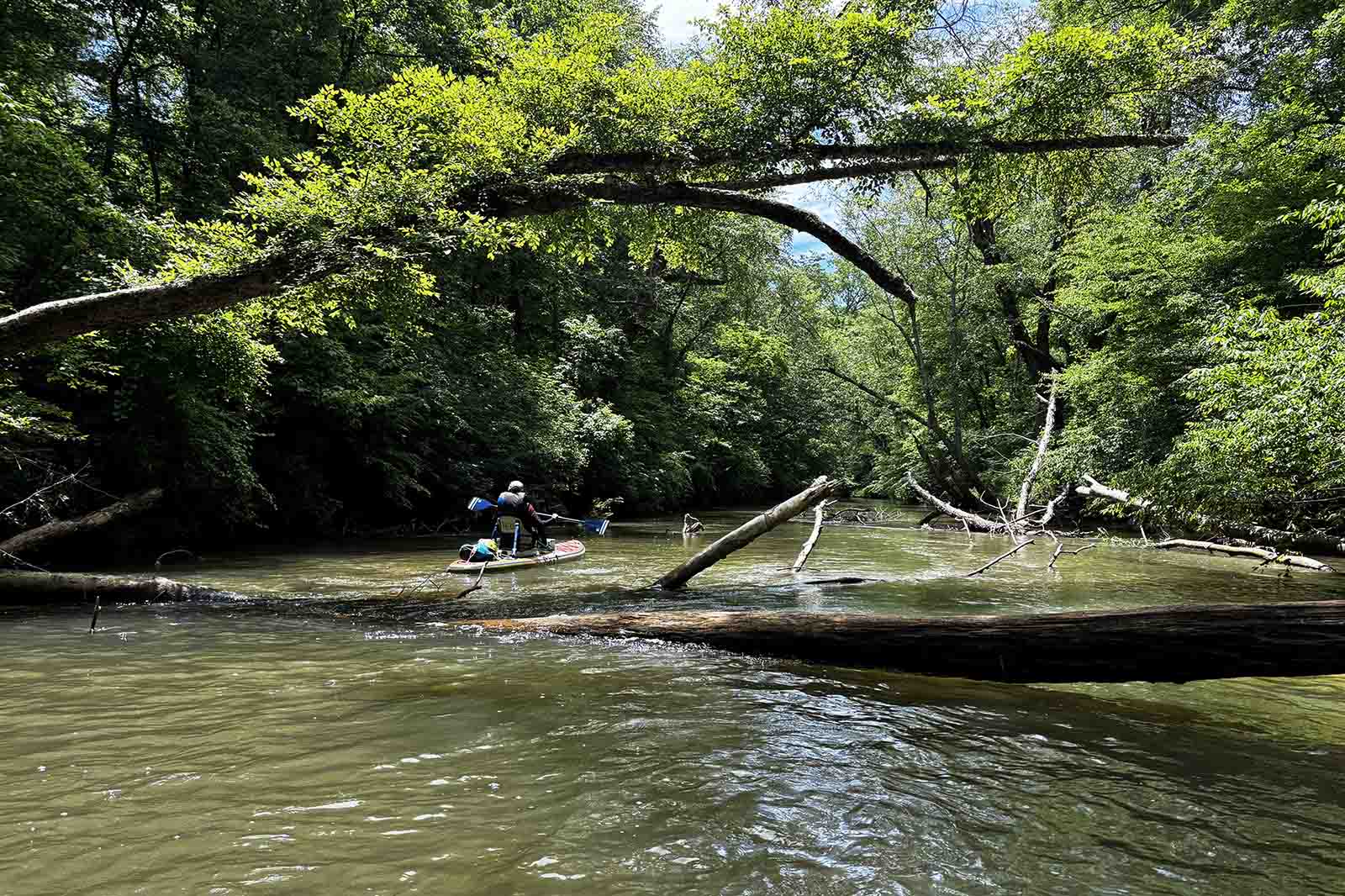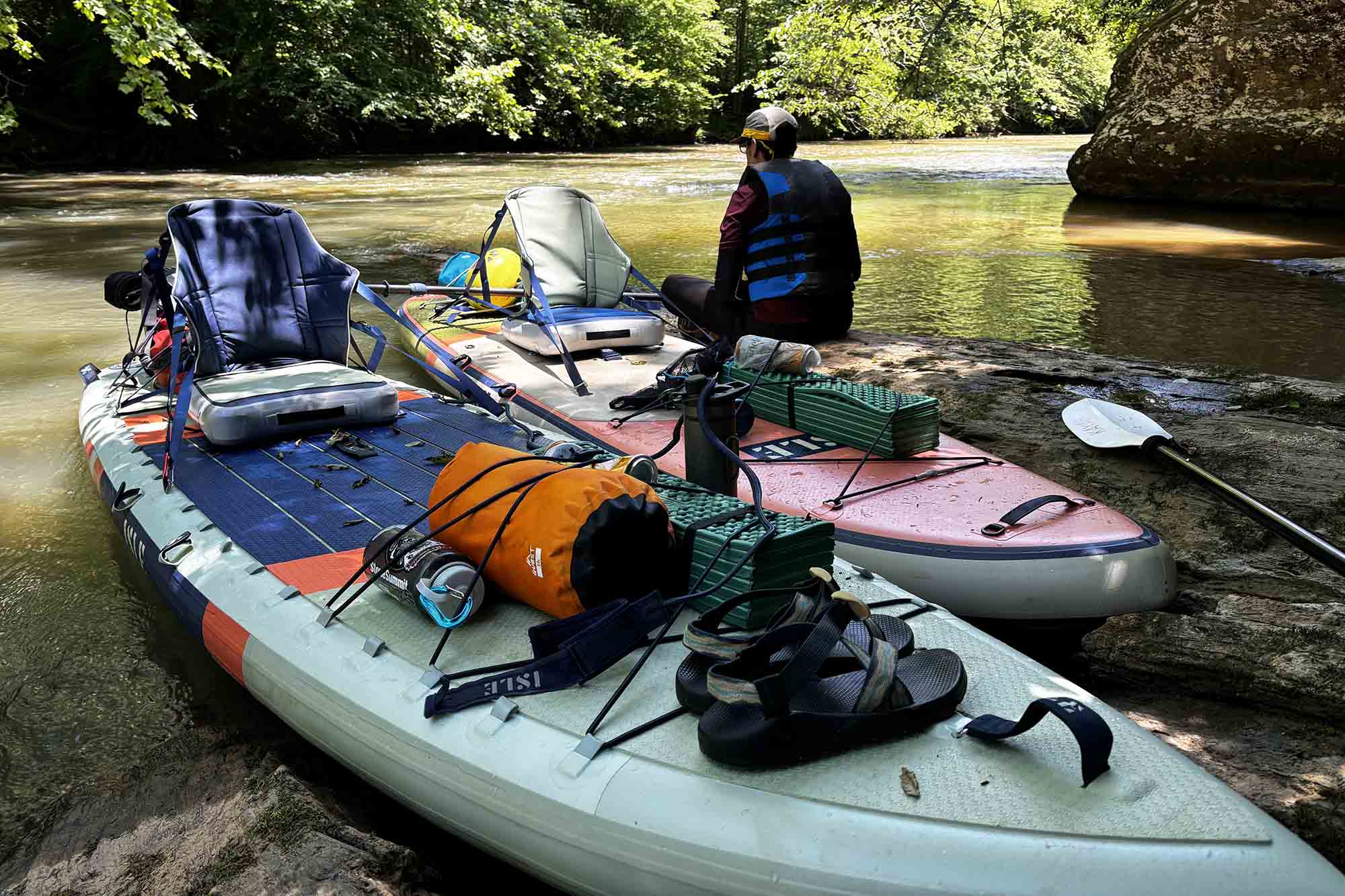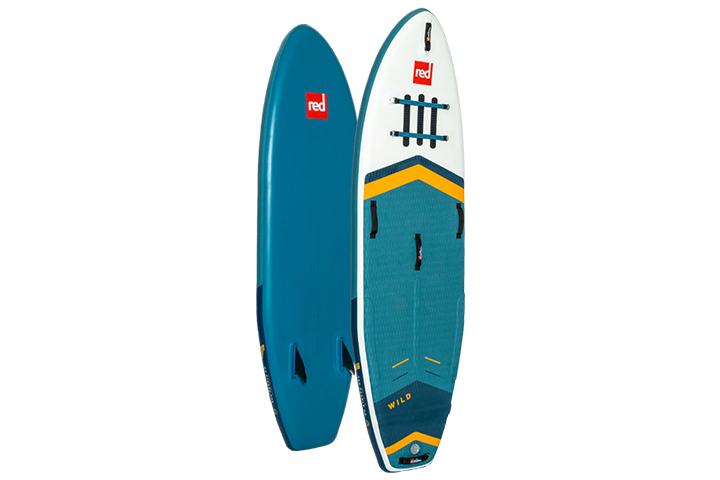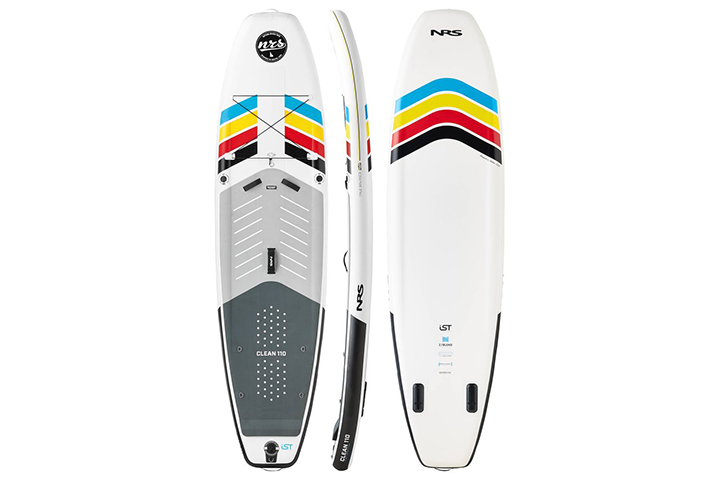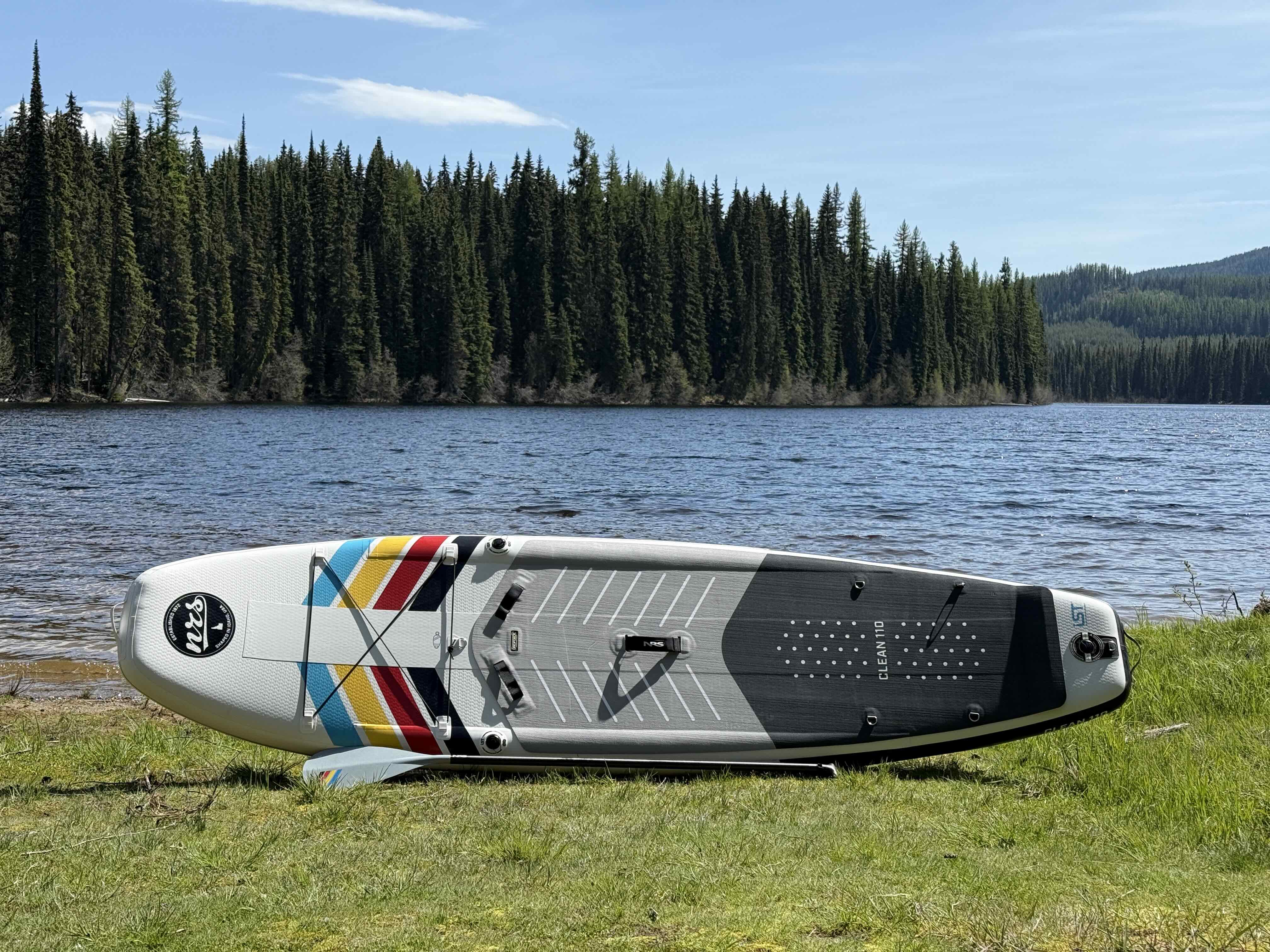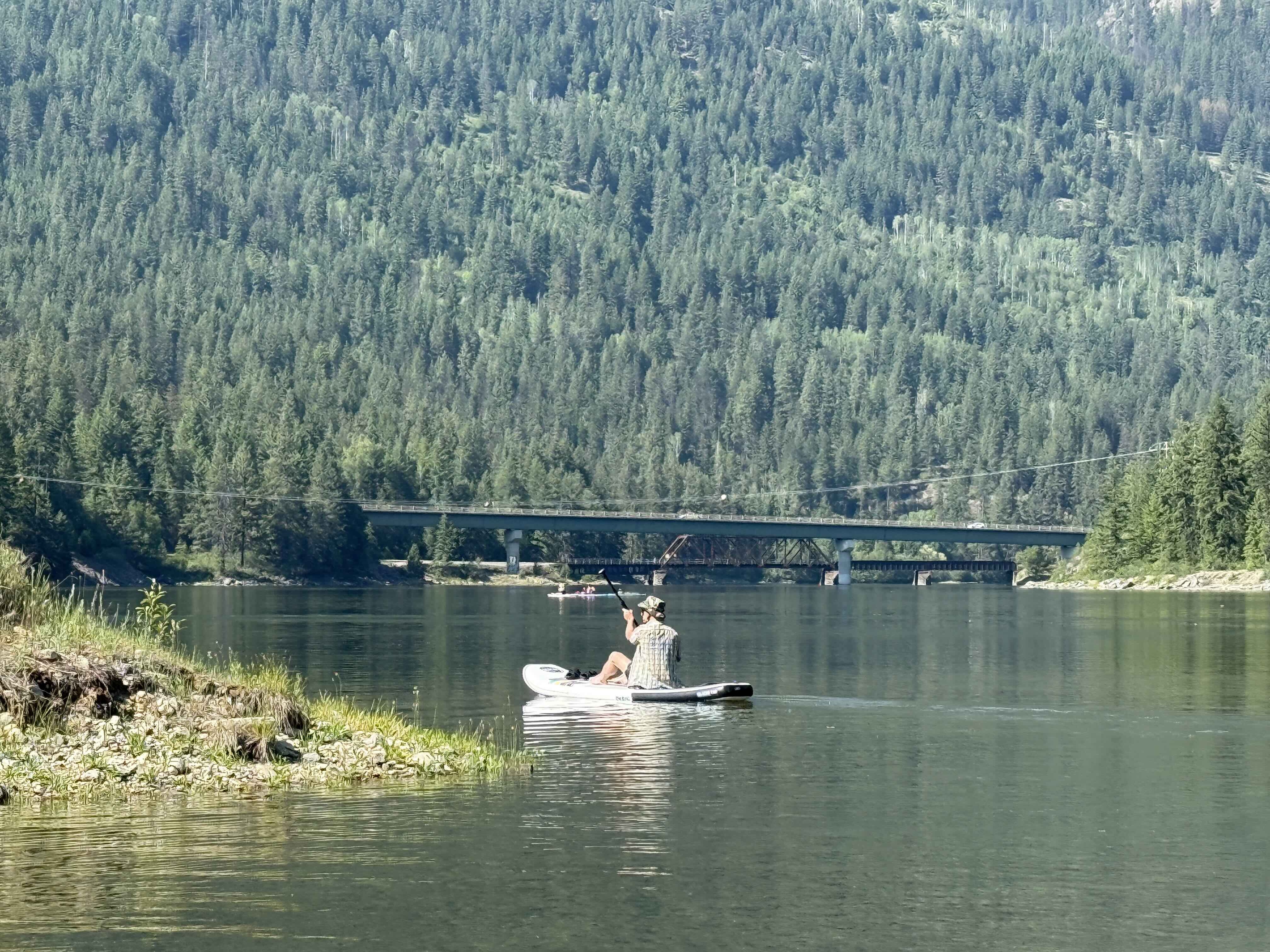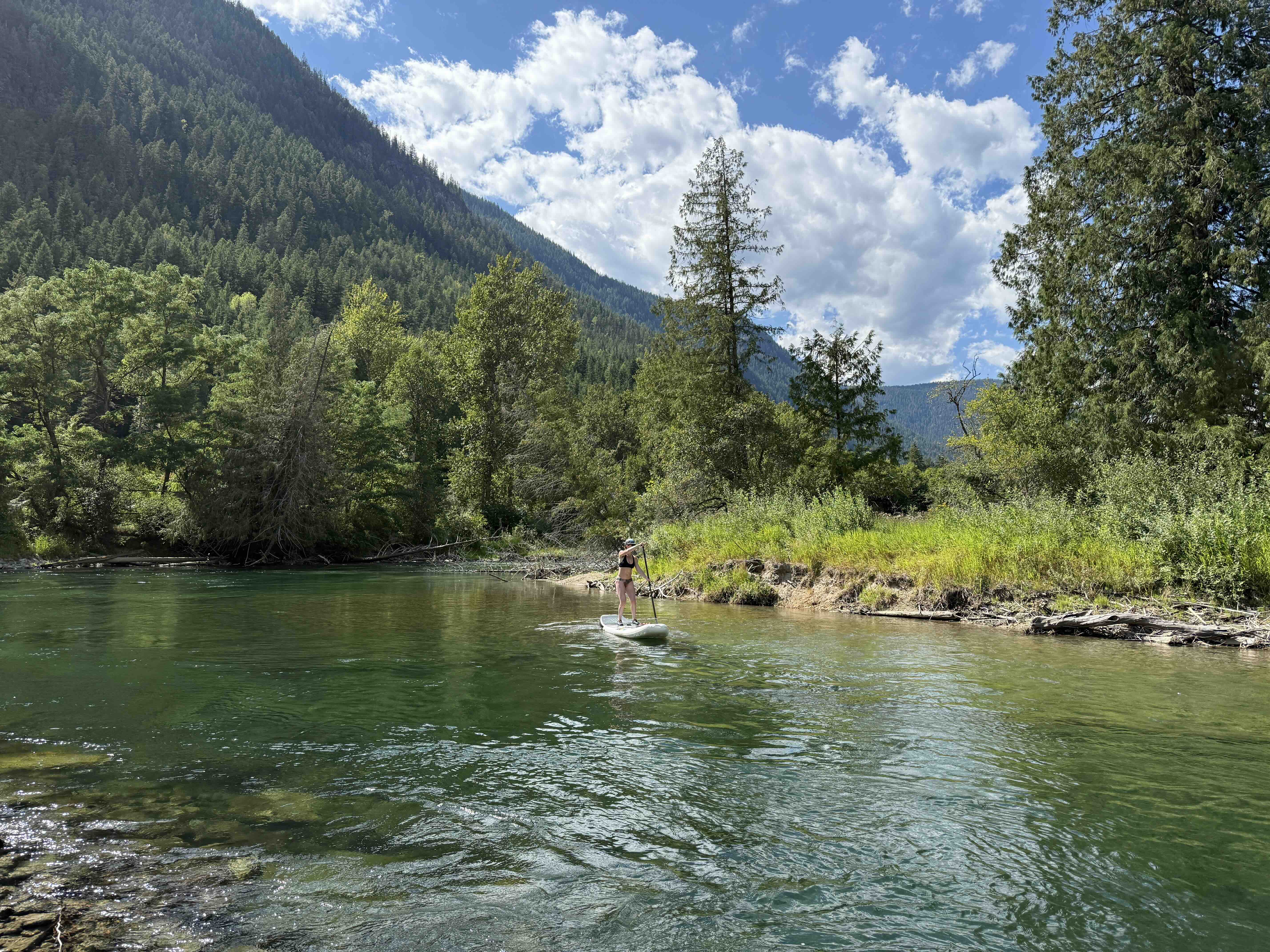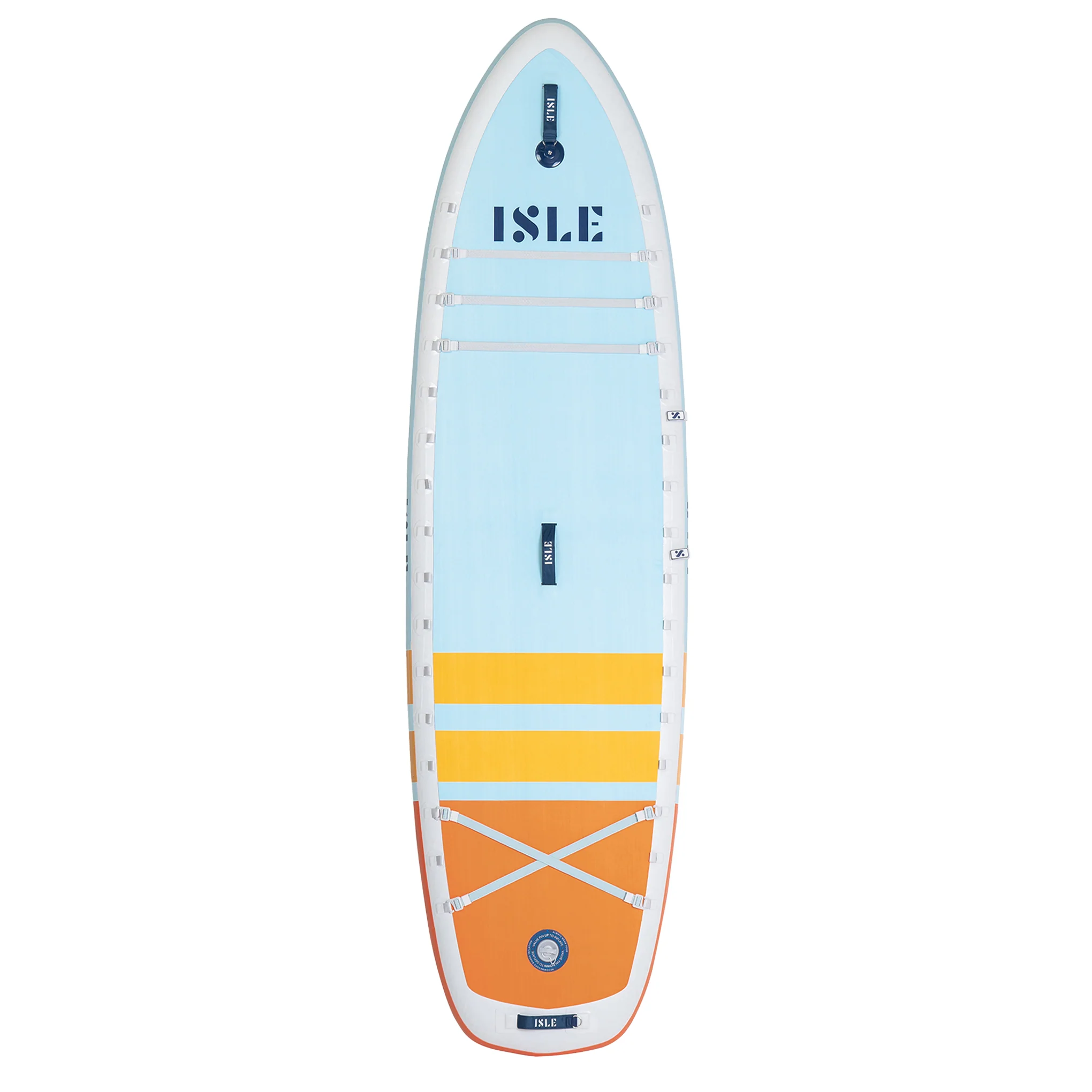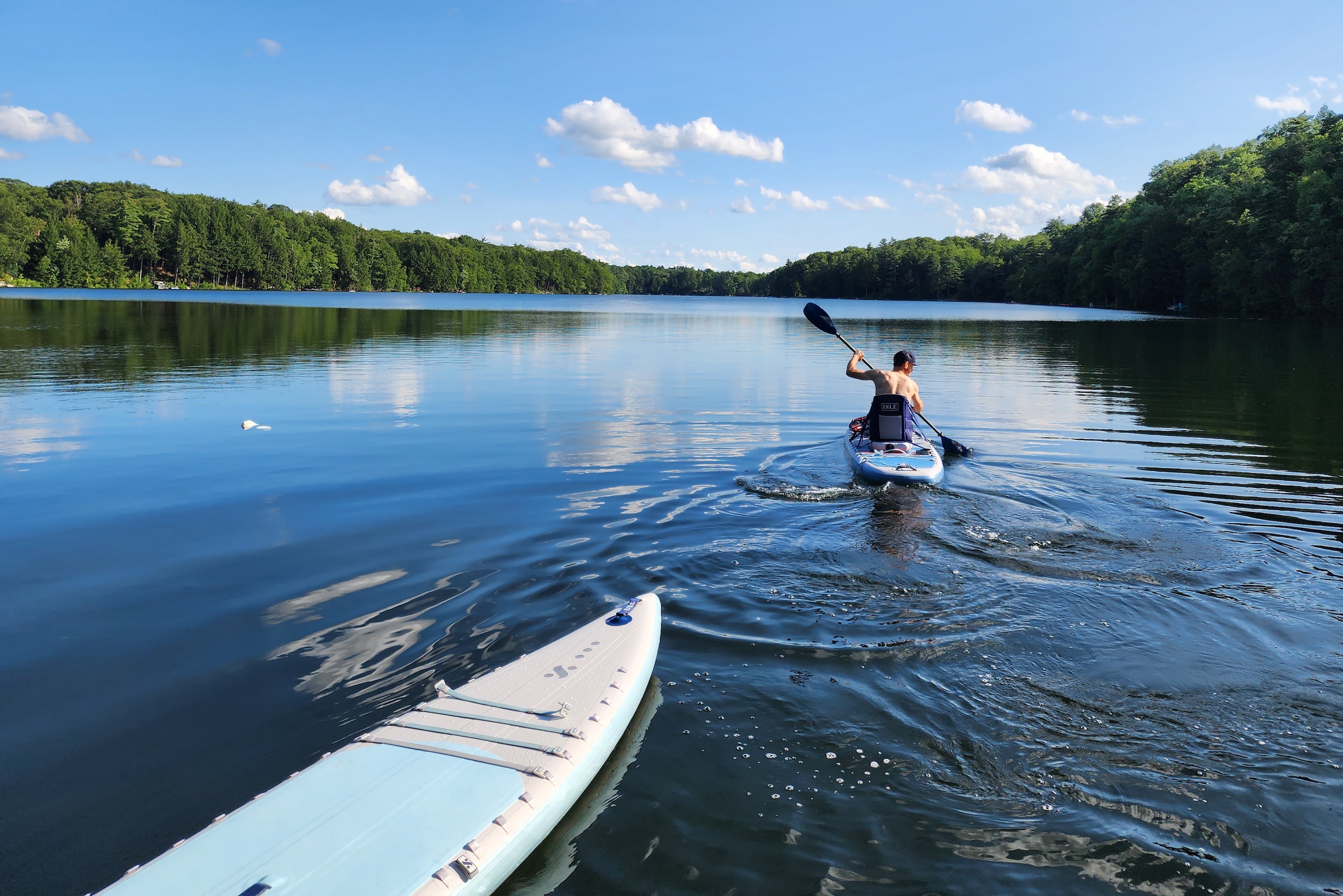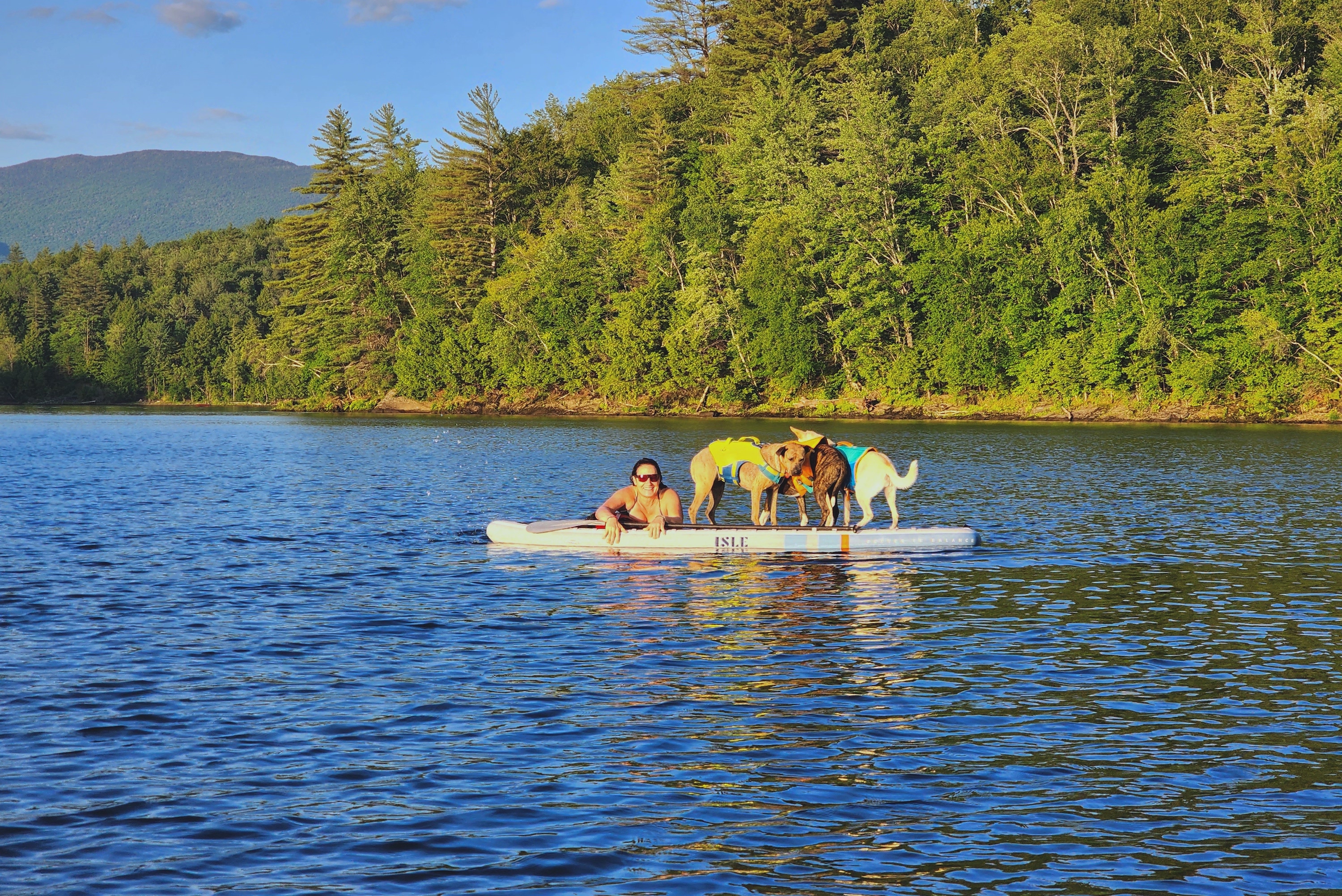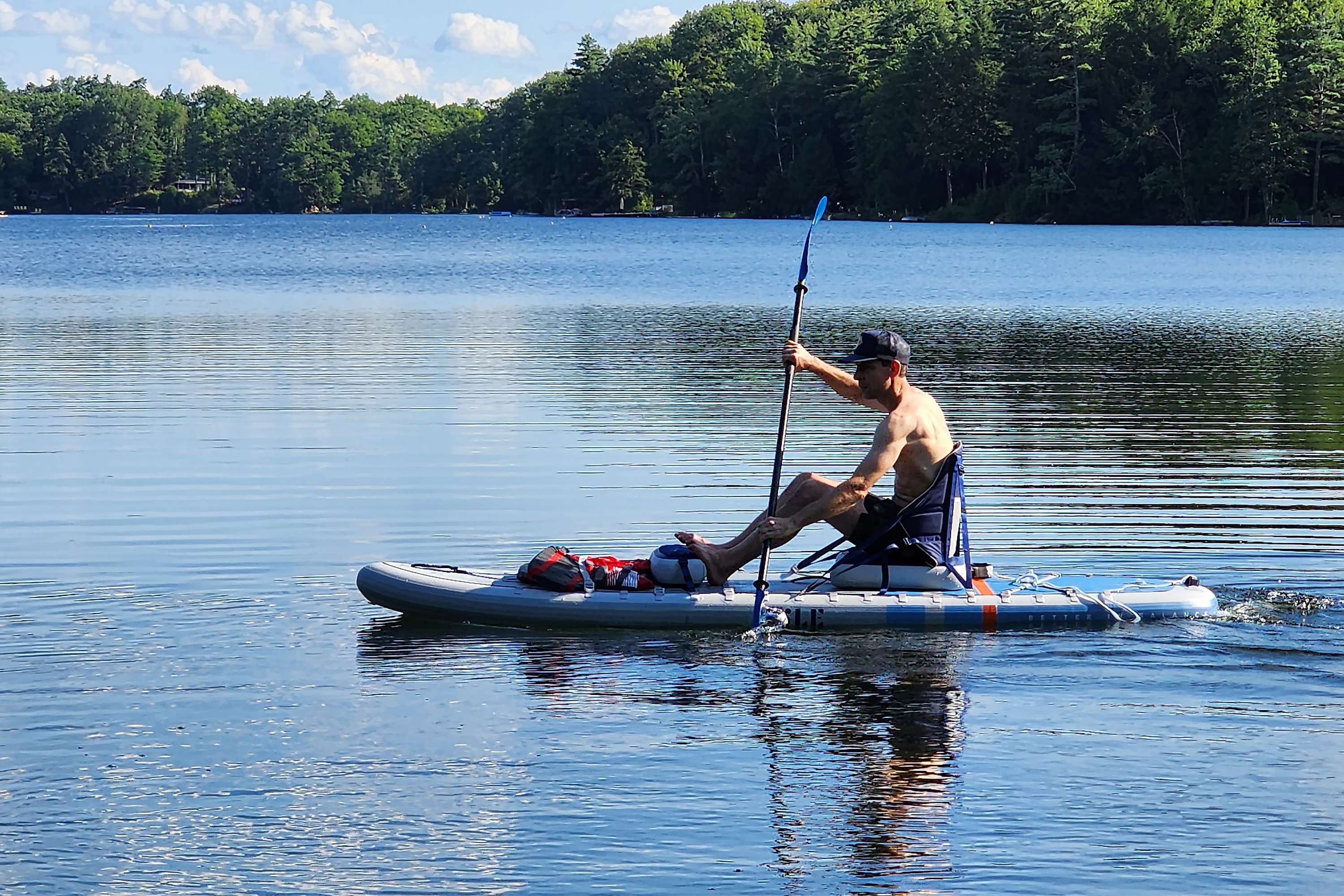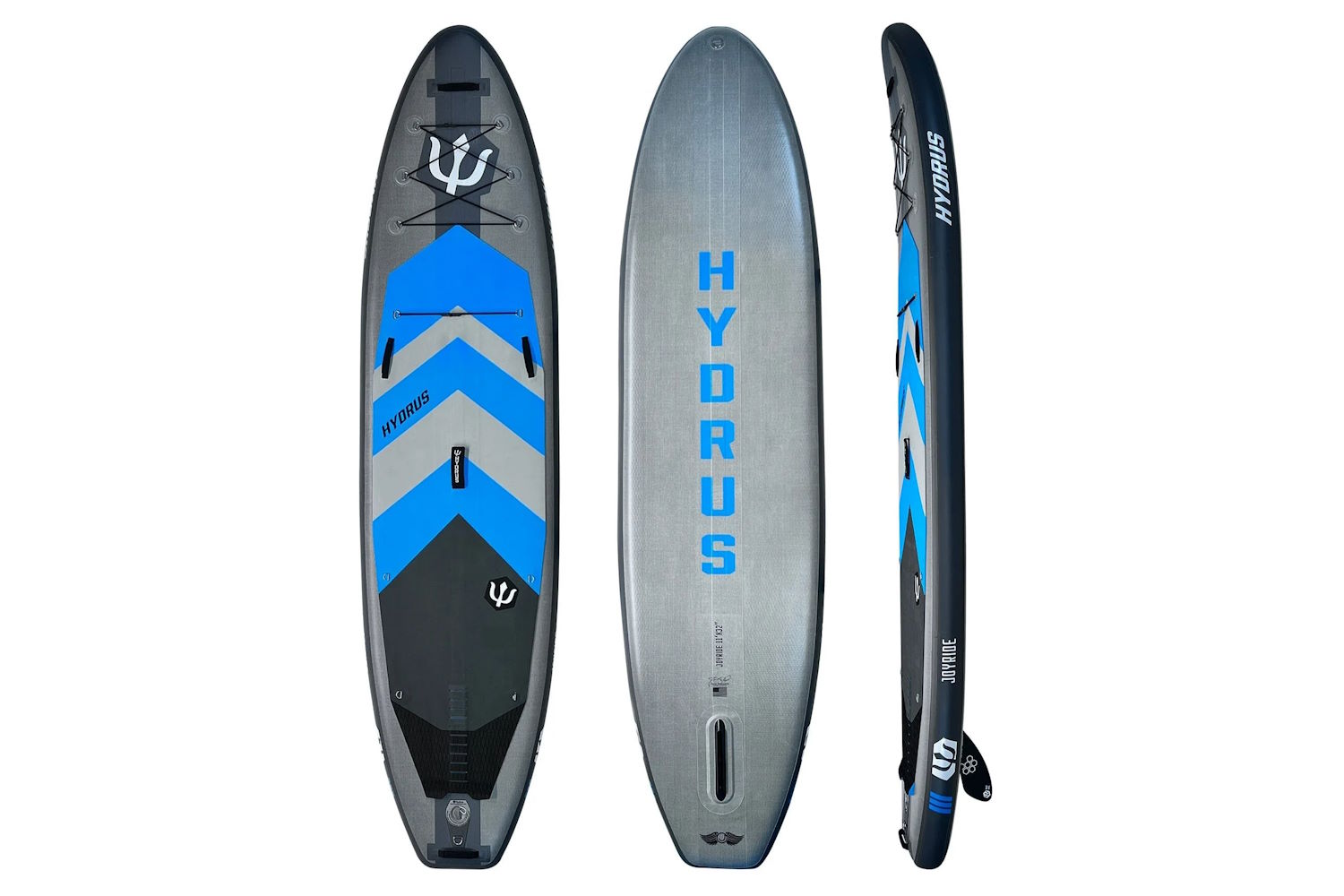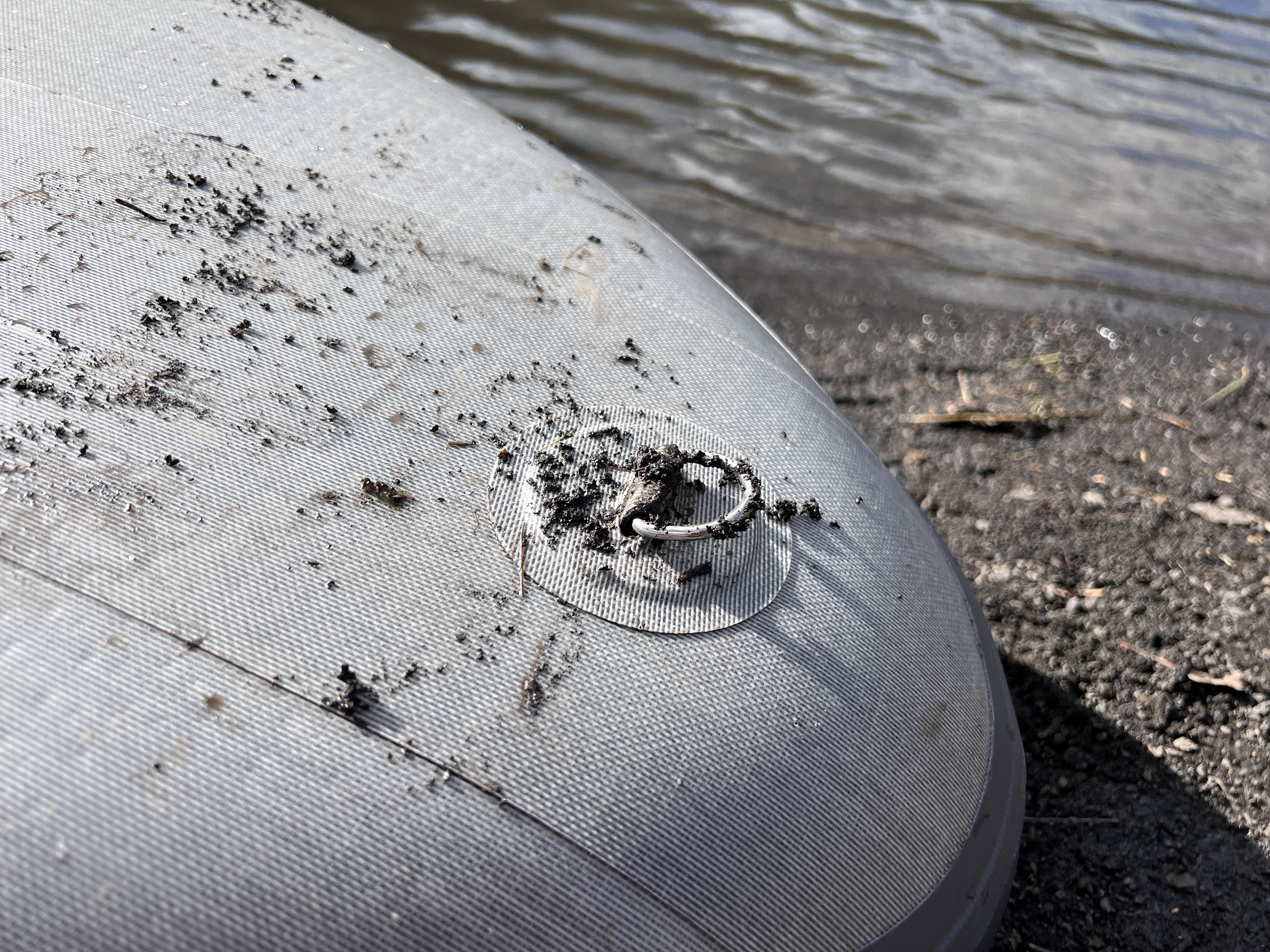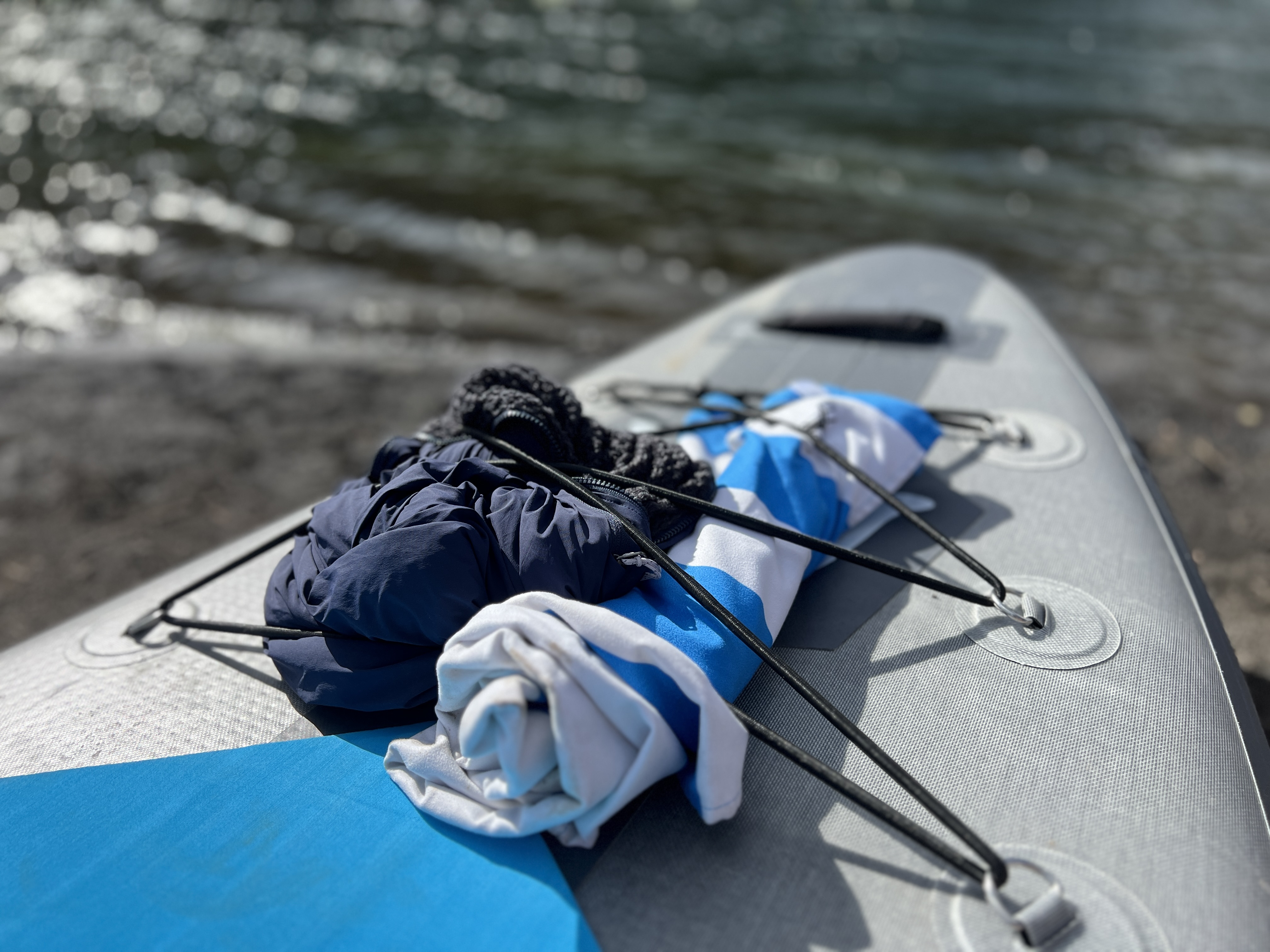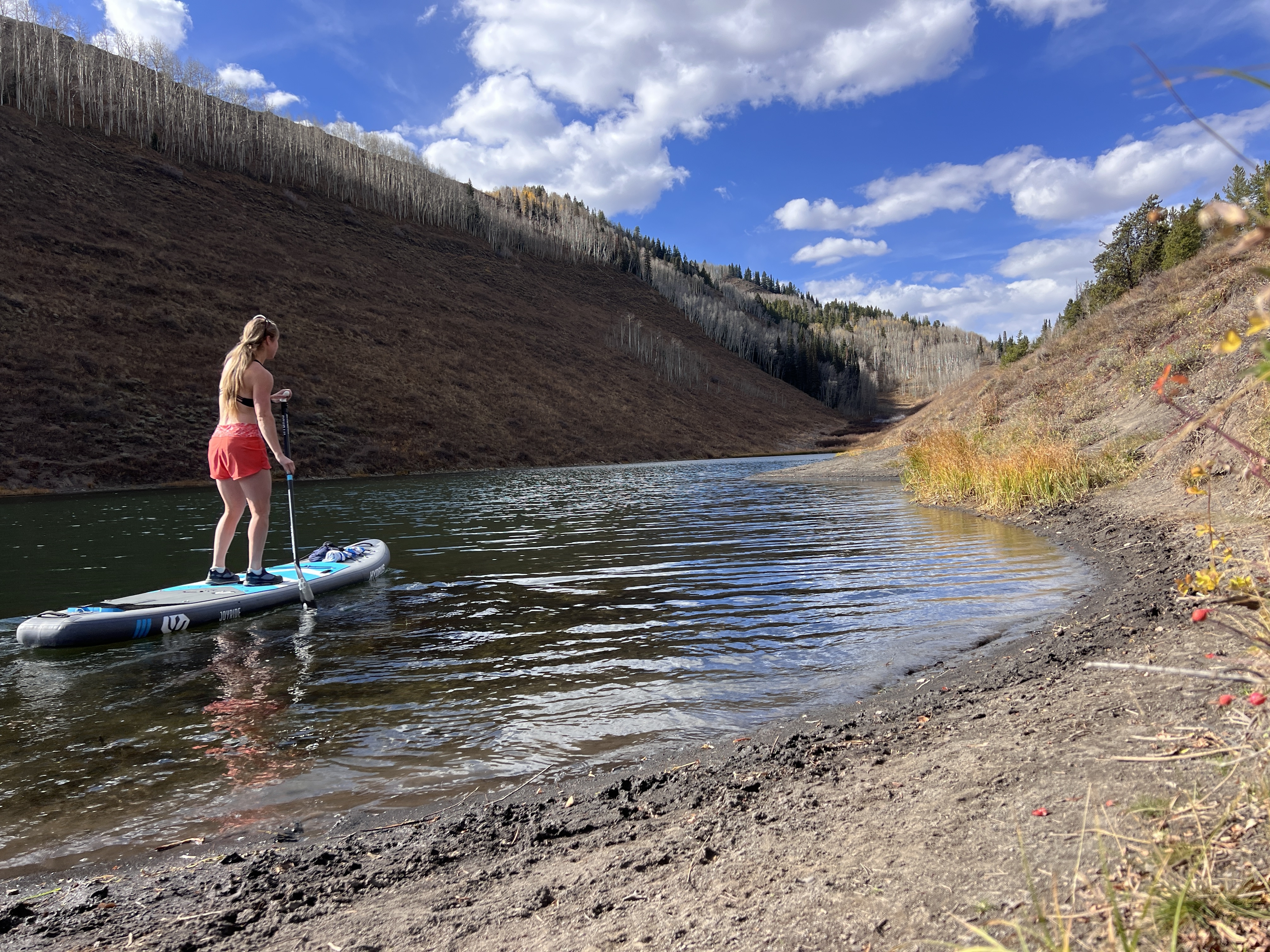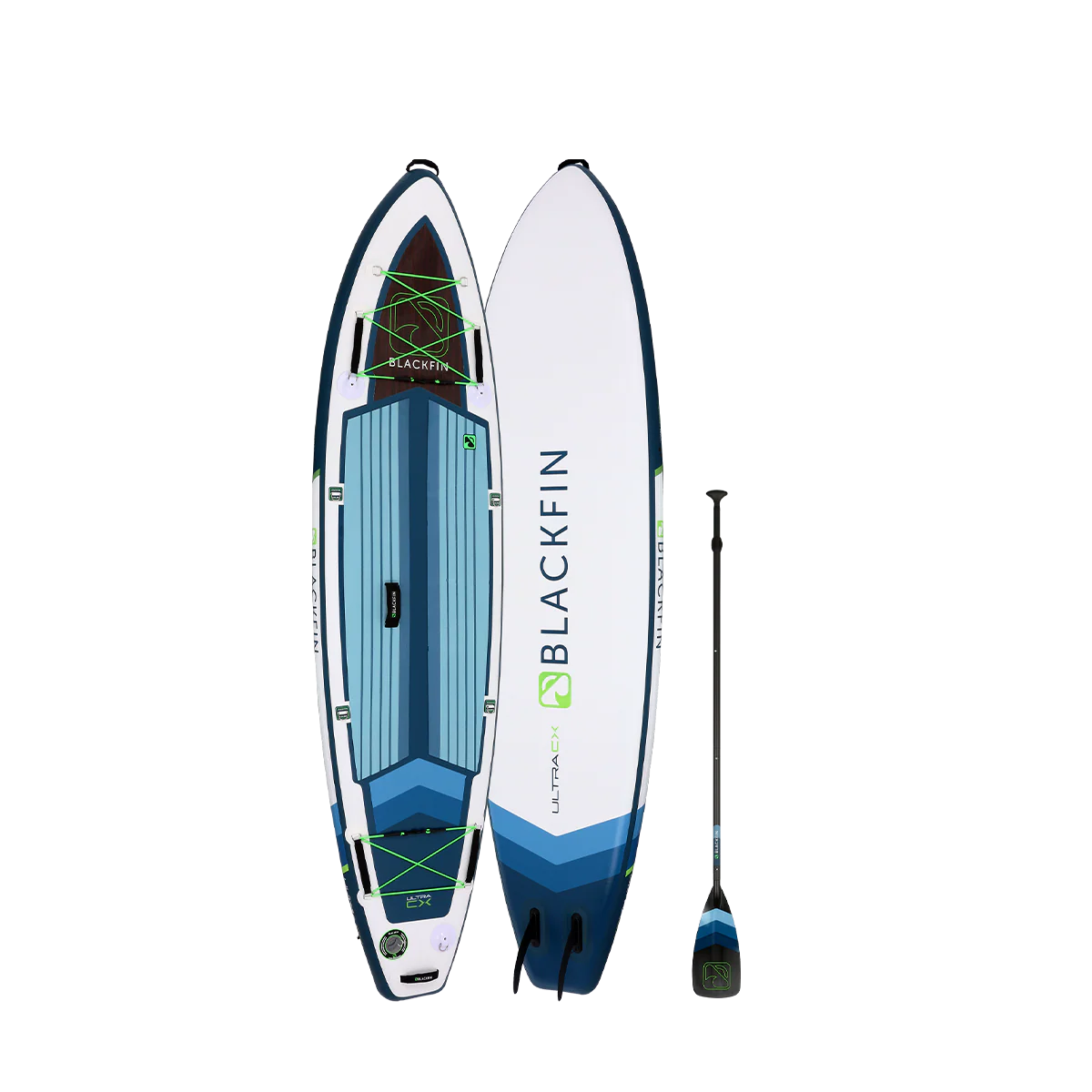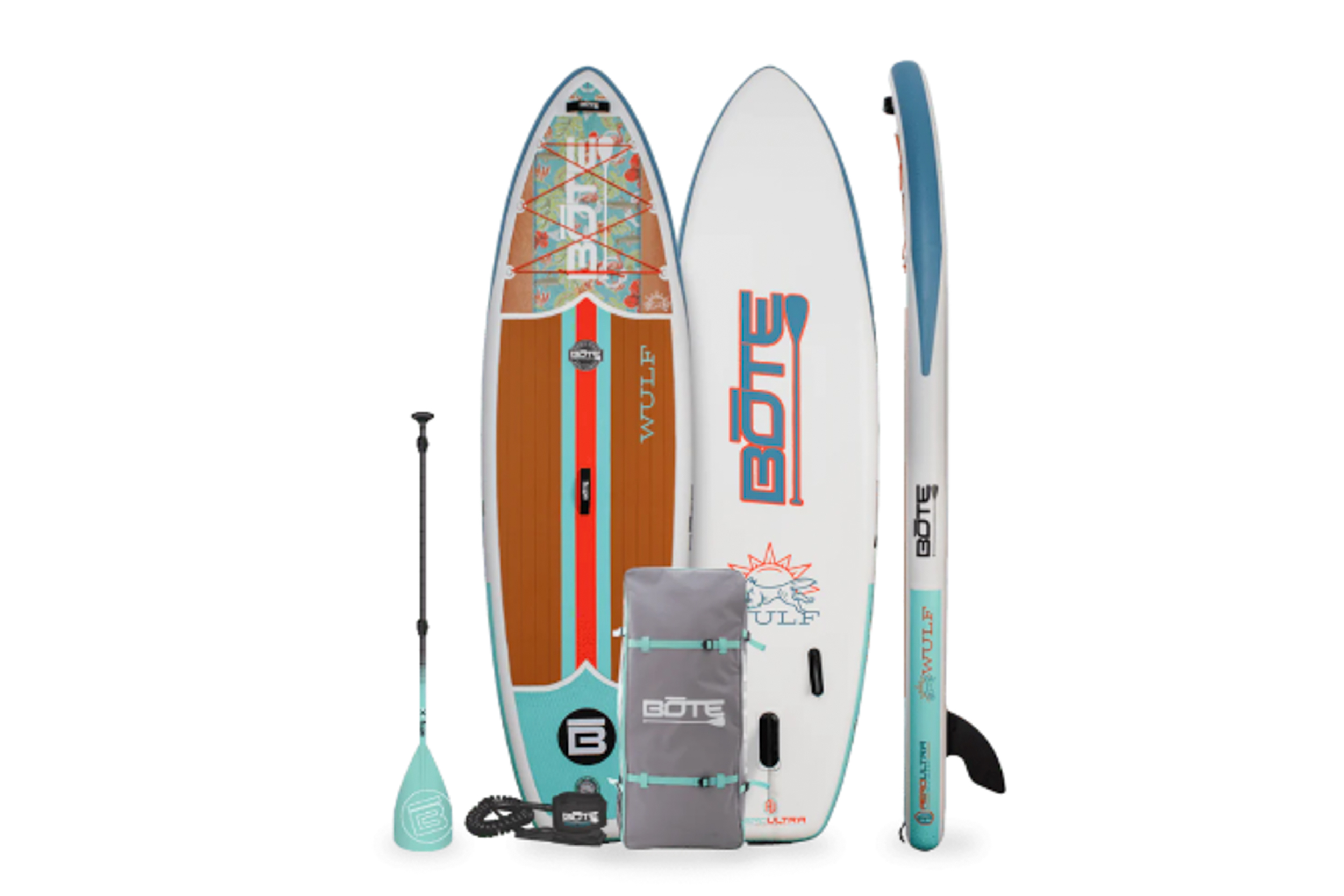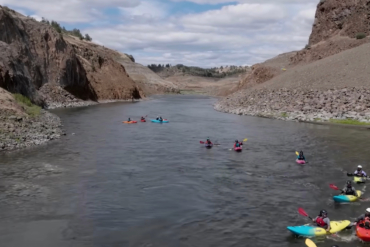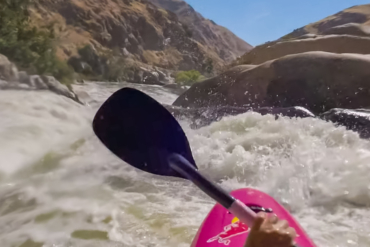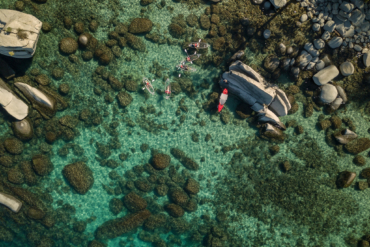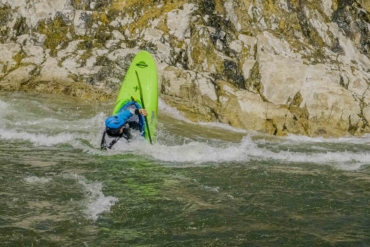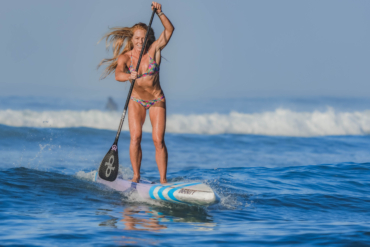From exploring coastlines and lakes to whitewater, a standup paddleboard offers freedom you don’t get in a boat. Standup paddleboarding, or SUPing, saw massive growth in the 2010s and remains very popular across North America. It involves standing (or sitting or kneeling) on a rigid or inflatable board that’s tapered at both ends. You use a paddle to accelerate and steer through the water.
We focus on inflatables here because, when deflated, they fit more easily in a closet, trunk, or truck bed — you can even take them on airplanes. Inflatable designs have benefits on the water, too, like durability against rocks or debris. They’re lighter and easier to transport and carry than a rigid SUP, especially for one person, if you’re willing to give up superior tracking, glide, and speed on the water. But you need to pump it up for use, and you don’t want to leave it in the sun, or it might pop.
Designs like the iROCKER Blackfin CX, which is longer and narrower with a pointed nose, are built for speed, can carry a heavy load (or two people), and are ideal for tours. Other boards, such as the Red Paddle Co 9’6″ Wild MSL are wider for stability, include tie-down points, and are fairly light: They’re great for single paddlers and casual outings.
Since this guide was initially co-authored by Senior Editor Morgan Tilton and contributor Mary Murphy, in 2021, our team of testers has continued to explore lakes and rivers by SUP from Georgia and Florida to Colorado, Utah, Texas, and British Columbia.
Editor’s Note: We updated this guide on August 12, 2025, with the field-tested and new Best Overall Red Paddle Co. 11’3″ Sport MSL, as well as the paddle-tested Red Paddle Co. 9’6″ Wild MSL, ocean-oriented BOTE HD Aero, and the NRS Clean 110, a whitewater and multiday rockstar with a rockered tip and tail. Senior Editor Morgan Tilton penned a new Price & Value section.
The Best Standup Paddleboards of 2025
Playful & Rockered: Best Expert Whitewater Standup Paddleboard for Surfing
NRS Clean 96
8.5/10 RatingRed Paddle Co. 11’3″ Sport MSL
- Length: 11′3″
- Width: 32″
- Thickness: 4.7″
- Weight capacity: ~242 lbs.
- Board weight: 24.9 lbs.
- Fin setup: Single 9" touring fin, removable
- Tie‑down points: 3 D-rings, 3 straight bungee straps, 1 bungee loop for water shoes
- Features: Accessory mount, removable rail stiffeners (battens), travel backpack with wheels, water-resistant phone case, repair kit, hand pump
Pros
- Tracks exceptionally well and is easy to paddle
- Great glide
- Low to the water
- Stable
Cons
- Harder to pivot
- Doesn't include a paddle
Boardworks SHUBU Riptide 10’6″
- Length: 10'6"
- Width: 33"
- Thickness: 5"
- Weight capacity: 255 lbs.
- Weight: 19 lbs.
- Fin setup: Single fin, removable
- Tie-down points: 5 (4 D-rings anchor the bungee strap, 1-D-ring on tail)
- Features: 3 grab handles
- Accessories: Adjustable 3-piece paddle, backpack roller bag, hand pump, leash, repair kit
Pros
- Expansive thick cushion across top
- Comfortable carry handles
Cons
- Need more tie-down points for multiday trips
- Not our first choice for whitewater
Kokopelli Chasm Lite SUP
- Length: 10'
- Width: 30"
- Thickness: 6"
- Weight Capacity: 250 lbs.
- Weight: 12.9 lbs
- Fin setup: Single
- Tie down points: 4
- Features: EVA deck pad, welded D-rings, bungee
- Accessories: Pump, paddle, leash, pack
Pros
- Extremely light
- Good stability and performance for size
- Small pump design
- Carry-on size
Cons
- Only single fin
- Smaller deck pad area
- Not the most durable
NRS Clean 96
- Length: 9'6"
- Width: 36"
- Thickness: 5"
- Weight capacity: 210 lbs.
- Weight: 23 lbs.
- Fin setup: 2 removable
- Tie-down points: 1 D-ring on the tail, 1 D-ring at the top of the deck
- Features: Bungee strap on nose, 5 grab handles
- Accessories: Super Pump II, 2 all-water fins, 2 whitewater fins, travel backpack, repair kit
Pros
- Wide design feels very stable
- QuickClick fin boxes make fin swapping super quick and streamlined
- Feels very light compared to size
- Super Pump II provides speedy inflation
Cons
- Travel backpack doesn't have wheels or a hip belt, a ding for airport trips
- Not many tie-down points
- Wider volume causes more drag on flat water than a narrower, longer board
BOTE HD Aero Inflatable Paddleboard
- Length: 11'6"
- Width: 34"
- Thickness: 6"
- Weight capacity: 315 lbs.
- Weight: 30 lbs.
- Fin setup: 2 plus 1, removable
- Tie-down points: 10 D-rings anchor the bungee straps plus 4 D-rings along sides, D-ring on nose, 2 D-rings on the top
- Features: Bungee straps on nose and tail, 10-inch center fin, four D-rings on side rails
- Accessories: 3-piece paddle, repair kit, hand pump, backpack travel bag
Pros
- Higher weight capacity for hauling gear on tours
- Compatible with a huge range of accessories that are especially great for anglers, birders, and tours like the SUP paddle seat
- Ample tie-down and attachment points
Cons
- Additional accessories add up so budget accordingly
- Not a SUP weight we'd want to hike far with
ISLE Switch Pro
- Length: 11'6"
- Width: 35.5"
- Thickness: 6"
- Weight Capacity: 475 lbs.
- Weight: 23 lbs.
- Fin setup: Single, removable 9-inch touring-style flex fin
- Tie-down points: Two bungee-corded areas (six-point and four-point) on the bow and stern
- Features: Attachment points for a kayak seat and footrest
- Accessories: Hand pump, electric assist motor mount system, carbon paddle, extra blade, kayak seat, foot brace, wheelie backpack, ankle leash
Pros
- Super high weight capacity
- Rigid and durable
- Lightweight and easy to carry
- Maneuvers well seated or standing
Cons
- Not cheap
- Packing it up can be frustrating
- Wheeled backpack model not as versatile as other ISLE backpacks
Red Paddle Wild MSL
- Length: 9'6"
- Width: 34"
- Thickness: 5.9"
- Weight capacity: 243 lbs.
- Weight: 23.9 lbs.
- Fin setup: Twin 4.6" flexible fins (2 removable)
- Tie-down points: 6 D-rings anchor the two front bungee straps; accessory mounts integrated into the deck
- Features: Full-length diamond-cut EVA deckpad, raised kick pad and side rails, 5 grab handles (center, nose, tail, sides), high rocker profile for whitewater maneuverability
- Accessories: ATB Transformer Bag with wheels (160 L), Titan II dual-chamber pump, coiled leash, waterproof phone case, repair kit
Pros
- Queen of stability on turbulent water
- Pivot on a dime
- Forgiving, durable fins
- Articulation in deck pad increases traction, balance, and control
- Large, plush grab handles make transport easy
- Huge backpack includes wheels and ample space for travel
Cons
- Hand pump offers high airflow but is large and cumbersome
- Backpack could use side compression straps to help compress heavy load
- Bungee straps are highly elastic, so dry bags need extra securing
Our Other Favorite Inflatable Boards for Paddling Adventures
- Length: 11
- Width: 34"
- Thickness: 6"
- Weight capacity: 240 lbs.
- Weight: 26.4 lbs.
- Fin setup: 2 removable
- Tie-down points: 5 D-rings on the tail, 1 D-ring at the top of the deck
- Features: Bungee strap on nose, 5 grab handles
- Accessories: Super Pump II, 2 all-water fins, 2 whitewater fins, travel backpack, repair kit
Pros
- Long, narrow shape accelerates well
- Relatively lightweight
- 6 metal D-rings provide various lash points
- QuickClick fin boxes make fin swapping super quick and streamlined
Cons
- We wish there were more D-rings on the nose for multi-day trips
- Backpack lacks a chest strap, hip belt, and wheels — a drawback for airport travel
- Length: 12'
- Width: 30"
- Thickness: 6"
- Weight capacity: 300 lbs.
- Weight: 24 lbs.
- Fin setup: 1-fin, removable
- Tie-down points: 23 D-rings, 23 Seamount attachment points
- Features: PVC drop stitch exterior, double-layer PVC side rails, EVA deck pad
- Accessories: Hand pump, backpack travel bag, paddle
Pros
- Large enough for 1-4-day expeditions (carrying rider plus gear)
- Durable
- Lots of attachment points
- Stable when paddling
Cons
- Smaller deck pad area
- Hard to pump to maximum PSI
- Length: 10'6"
- Width: 33"
- Thickness: 6"
- Weight capacity: 300 lbs.
- Weight: 21 lbs.
- Fin setup: 2-fin, removable
- Tie-down points: 4 D-rings plus front and tail bungees
- Features: 2 removable 2 x 9in fins, EVA deck pad, offset carry handle in the center plus carry handles on nose and tail, bungee cords on nose and tail
- Accessories: 5-piece carbon paddle, iROCKER 12V Electric Pump , 10-inch coil leash, backpack travel bag
Pros
- Anchored bungees are located on both the nose and tail
- Five-piece paddle is easy to pack and transport
- Offset center handle is excellent for shorter reach
Cons
- Not a good option for multiple paddlers
- No manual pump is included
- Length: 10’ 6”
- Width: 34”
- Thickness: 6”
- Weight capacity: 300 lbs.
- Weight: 23 lbs.
- Fin setup: Single center fin, removable
- Tie-down points: 6 Point Front, 4 Point Rear Bungee
- Features: Full-Length Traction Pad, Paddle Holder, High Pressure Valve
Pros
- Exceptionally rigid for an inflatable SUP
- ISLE-Link converts to highly adjustable sit-on-top Kayak
- Spacious storage bag
Cons
- Fin attachment can be tricky at first
- Length: 10’6”
- Width: 32.5"
- Thickness: 6"
- Weight capacity: 320 lbs.
- Weight: 19.8 lbs.
- Fin setup: 2 removable
- Tie-down points: 14 D-rings, 2 Bungees
- Features: Sand Spear mounting points, seat attachment points, dual-layer PVC laminate, reinforced seams
- Accessories: 3-piece paddle, triple-action hand pump, carrying bag
Pros
- Fins install without tools
- Includes repair kit
- Mounting points for seat
Cons
- Pricier
- Not the best board for beginners
- Length: 10' 6"
- Width: 32"
- Thickness: 4.7"
- Weight capacity: 220 lbs.
- Weight: 21.9 lbs.
- Fin setup: 2-fin, fixed
- Tie-down points: D-ring on tail, 2 elastic straps on nose, 1 adjustable bungee strap with two D-ring anchors
- Features: 3 carry handles, accessories mount
- Accessories: Backpacker roller bag, hand pump
Pros
- Super innovative minimal backpack carry system
- The fins are fixed so travelers don't need to fuss with managing extra accessories
Cons
- Paddle not included
- Lacks tie-down points for overnighters and heavier loads
- Fins are not removable (for some paddlers, the lack of adjustability is a downfall)
- Length: 10'4", 11'4"
- Width: 34"
- Thickness: 6"
- Weight capacity: 250 lbs.
- Weight: 20 lbs.
- Fin setup: 1 removable (10"), 2 fixed
- Tie-down points: 8
- Features: Three carry handles, fixed bungee strap on nose (with 6 D-rings), 1 D-ring on tail, 1 D-ring next to center handle
- Accessories: 3-piece aluminum paddle, backpack-style bag, hand pump, coiled leash, repair kit
Pros
- Excellent stability and stiffness
- Good maneuverability
- Generous, comfortable, and grippy deck pad
- MAGNEPOD compatible
Cons
- Small attached fins get deformed and must be straightened
- Aluminum paddle prone to damage and is slippery
- Rudimentary travel bag
Standup Paddleboard Comparison Chart
Scroll right to view all of the columns: Price, Length, Width, Weight, Fin setup.
| Standup Paddleboard | Price | Length | Width | Weight | Fin setup |
|---|---|---|---|---|---|
| Red Paddle Co. Sport MSL | $1,099 | 11′3″ | 32″ | 24.9 lbs | Single 9″ touring fin, removable |
| Boardworks SHUBU Riptide | $500 | 10’6″ | 32″ | 21 lbs. | Single fin, removable |
| BOTE HD Aero | $999 | 11’6″ | 34″ | 30 lbs. | 2 plus 1 removable |
| NRS Clean 96 | $945 | 9’6″ | 36″ | 23 lbs. | 2 removable |
| Kokopelli Chasm Lite | $999 | 10′ | 30″ | 12.9 lbs | Single fin |
| Pau Hana Endurance Air | $1,249 | 12′ | 30″ | 24 lbs. | 1, removable |
| ISLE Swit ch Pro | $1,295 | 11’6″ | 35.5″ | 23 lbs. | Single, removable 9-inch touring-style flex fin |
| Red Paddle Wild MSL | $1,499 | 9’6″ | 34″ | 23.9 lbs. | Twin 4.6″ flexible fins (2 removable) |
| NRS Clean 110 | $995 | 11″ | 34″ | 26.4 lbs. | 2 removable |
| iROCKER Blackfin CX | $949 | 10’6″ | 32.5″ | 19.8 lbs. | 2 removable |
| Hydrus JoyRide | $1,165 | 11″ | 32″ | 6″ | 1 removable |
| Red Paddle Co. MSL Ride SUP | $949 | 10’6″ | 32″ | 21.9 lbs. | 2 fixed |
| BOTE WULF Aero | $559 | 10’4″ | 34″ | 20 lbs. | 2 plus 1 removable |
| Isle Pioneer Pro | $995 | 10’6″ | 34″ | 23 lbs. | Single center fin, removable |
| iROCKER Cruiser Ultra 2.0 | $799 | 10’6″ | 33″ | 21 lbs. | 2 removable |

How We Tested Standup Paddleboards
We take SUPs on river outings and turbulent whitewater, across lakes, and through canyons. We hike with our SUPs to high-altitude mountain lakes, paddle on wide-open reservoirs, and load them up for multiday adventures.
Our Expert Testers
Hailing from Crested Butte, Colo., Senior Editor Morgan Tilton is an avid paddleboarder. Tilton enjoys paddling the lakes, reservoirs, and rivers in the Elk and San Juan Mountains. With five friends, Tilton completed a self-supported first SUP descent down the 100-mile wild whitewater of Utah’s Escalante River, giving her a unique perspective to evaluate SUPs for their cargo-carrying and touring abilities.
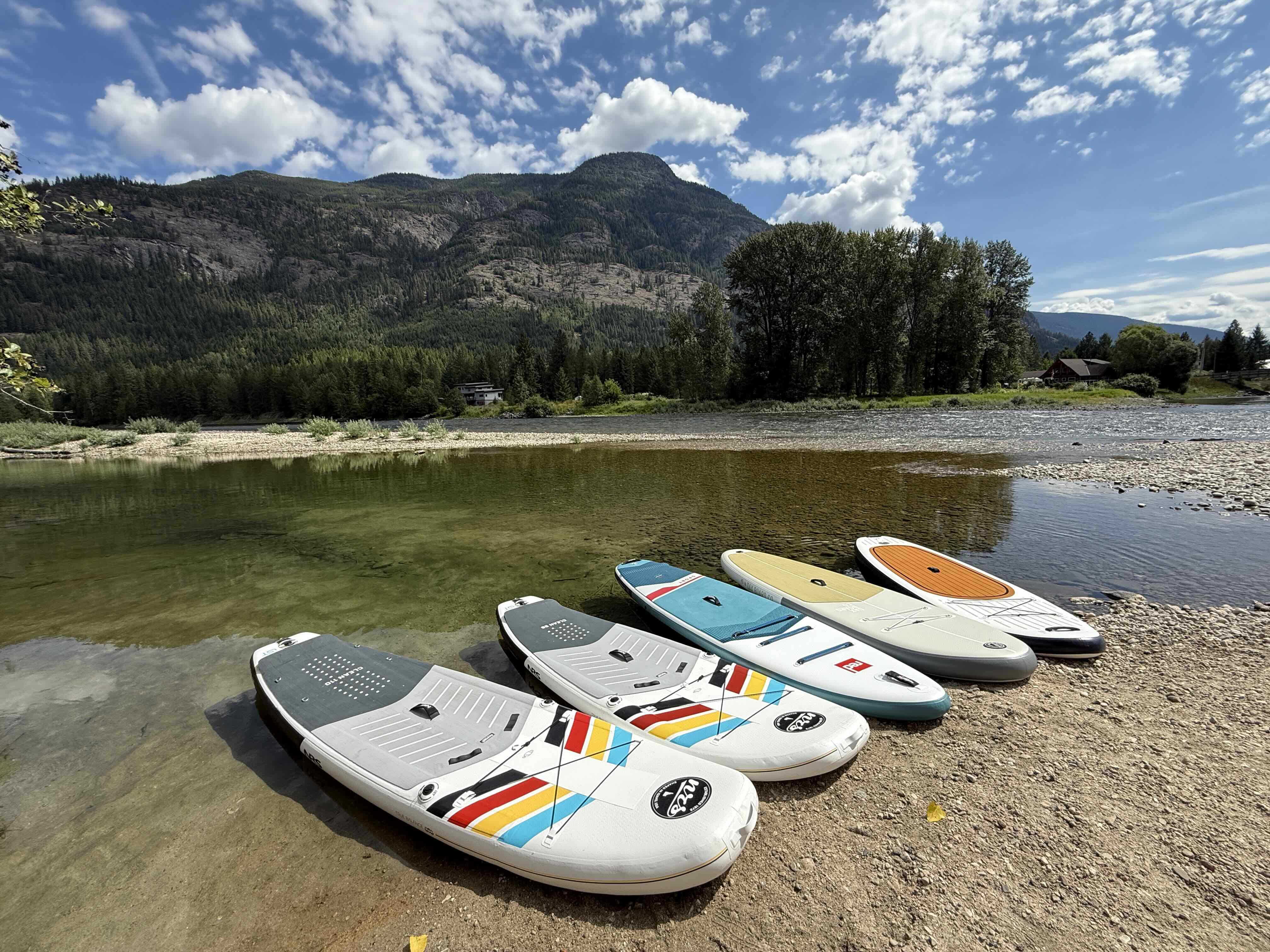
Located in Atlanta, Staff Writer Andrew McLemore paddles hundreds of river miles statewide, including flatwater, overnighters, whitewater, and ferrying multiple passengers.
Based in Denver, contributor Mary Murphy frequently tests the latest paddleboards on the local lakes, regardless of conditions, and enjoys multiday tours whenever she gets the chance. Other contributors have included Sean Jansen and Seiji Ishii.
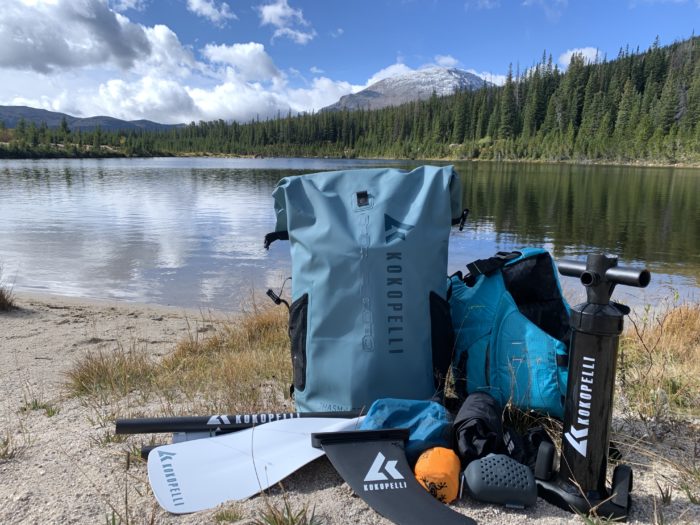
Our Testing Grounds
From the mountain to the ocean, we have tested SUPs in Colorado, California, Utah, Texas, Florida, Georgia, British Columbia, and Mexico.
Our Testing Process
When testing SUPs, we look at the overall construction, durability, rails, handles, attachment points, pad, stomp pad, air valve, weight, length, width, depth, shape, fin compatibility, adaptability, and accessories. Bundles often include a carry bag, hand pump, fins, and potentially a leash or paddle.
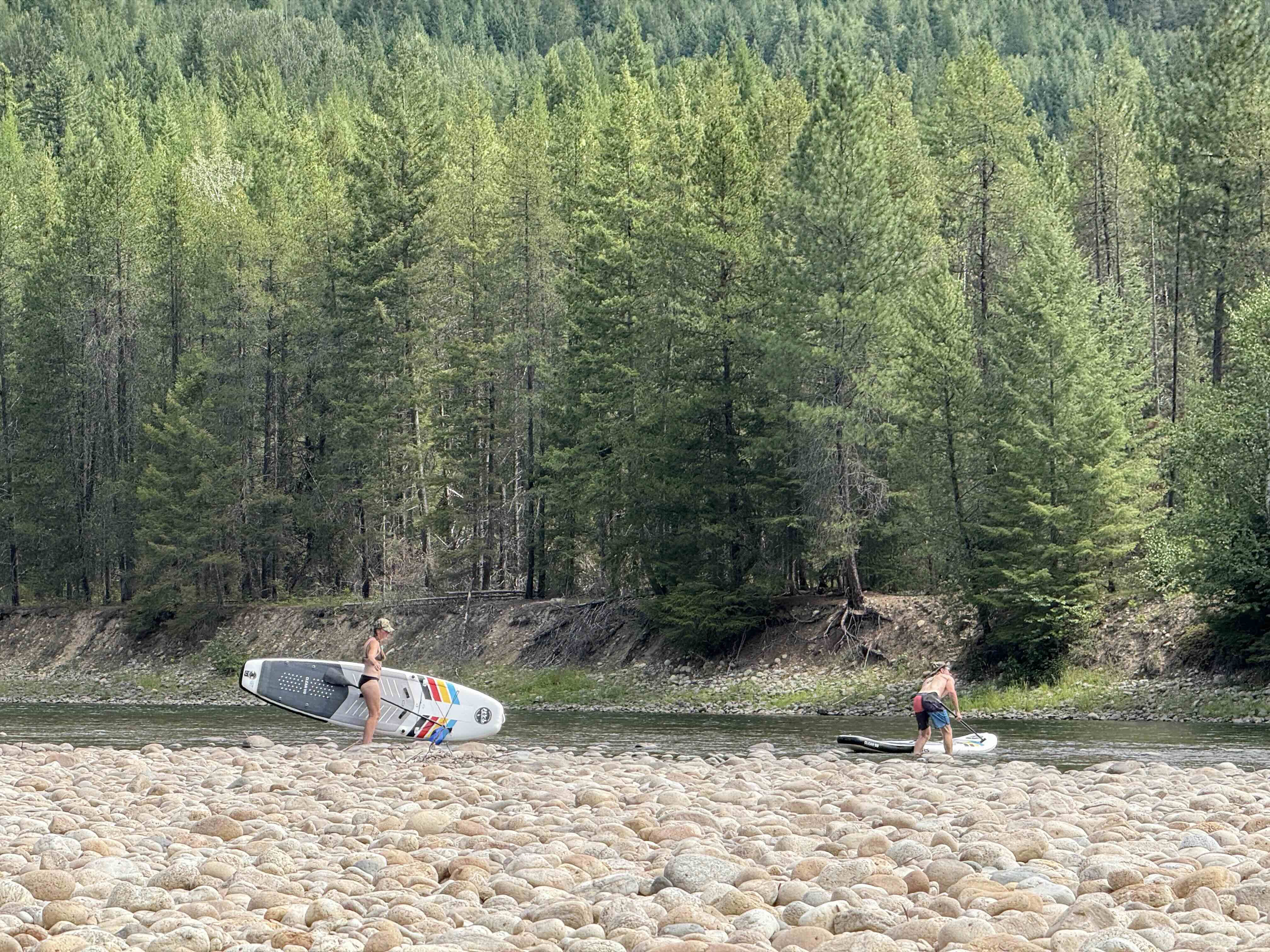
Our metrics for each board included quality, construction, and value. We put a huge focus on inflatable standup paddleboards and all-around models. They are a great option for all experience levels, have a variety of uses (flatwater, whitewater, and ocean), and don’t require special racks or extra storage space.
We test all of the boards on this list — with and without gear bags strapped down — to get a feel for how the boards handle at different weights. In addition, we consider the newest, highest-rated, most popular, and bestselling models on the market today.

Buyer’s Guide: How to Choose a Standup Paddleboard
Paddleboards are similar in shape to a long ocean surfboard but also have fins that are removable or fixed on the bottom, which help the board track well in the water while being steered.
Some paddlers use their boards for multiday adventures, while others race, fish, surf ocean waves, do yoga, run whitewater, hike to glacial tarns, or hang out with friends and family at the local reservoir. Our experts take all of these uses and scenarios into account when evaluating paddleboards.
Many boards are offered in a bundle with a paddle, fin, hand pump, and travel bag included in the cost of the package.

Types of Standup Paddleboards
A variety of standup paddleboard designs exist, tailored to specific activities and user goals. Boards can also have hybrid designs that work well for a variety of applications.
All-Around
These popular boards work for many types and experience levels of paddlers, from whitewater to flatwater. However, the designs do not excel at a specific type of paddling, such as racing or whitewater.
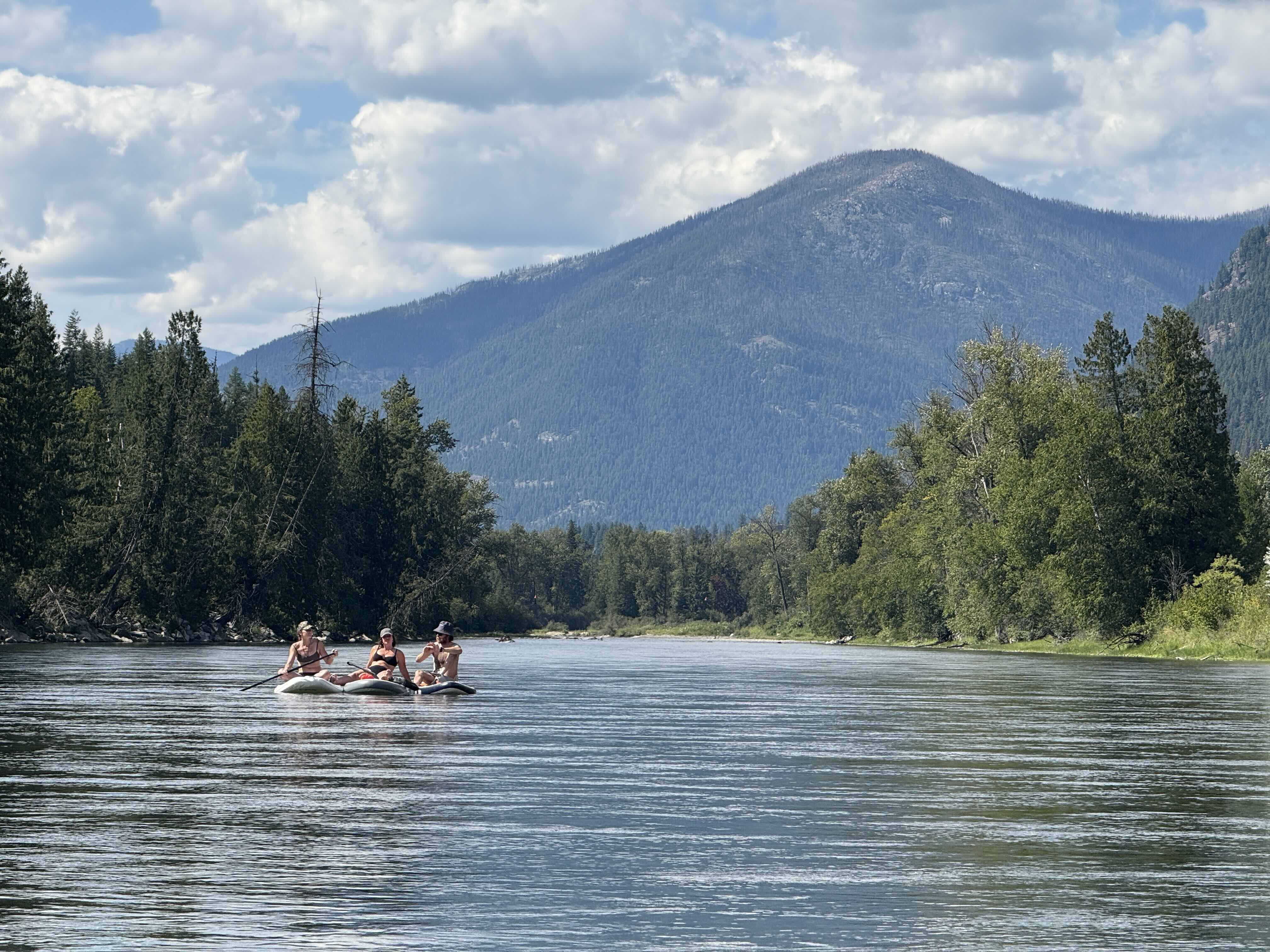
The majority of the SUPs in our guide are all-around boards, given the designs are often suitable for beginners, families, groups, individuals, and laid-back paddling in addition to more aggressive missions. All-around SUPs can be rigid or inflatable, and we focus on inflatable designs in this guide.
Whitewater (River or Ocean)
SUPs for whitewater are typically inflatable, which increases the durability while running against rocks, trees, or other debris. While they’re lengthier than a river surfboard, they’re generally shorter than the longest SUPs that are speed- or race-oriented on flat water.
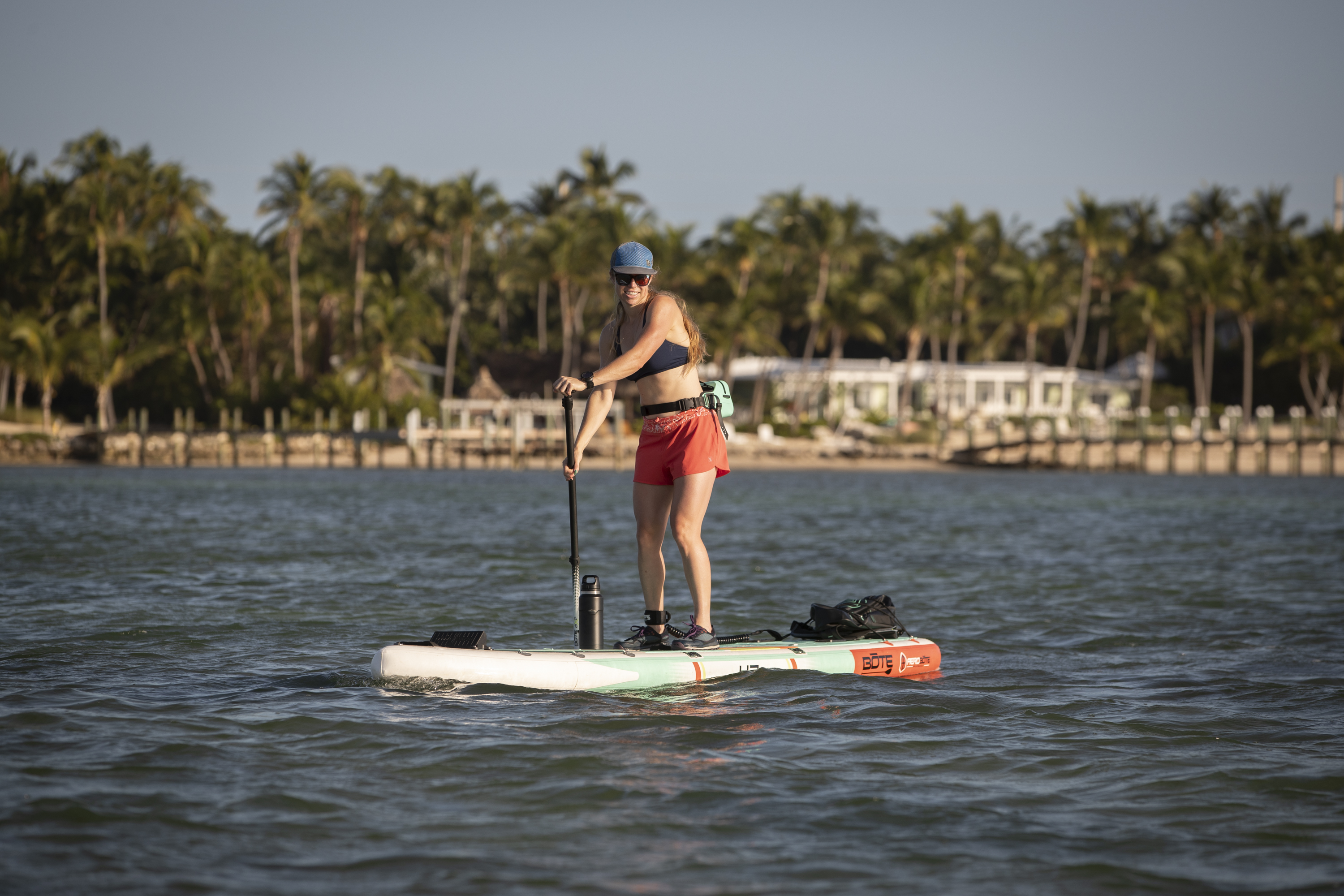
Touring (Flatwater)
Touring boards are made to be stable and move fast in water for paddling over long distances. The shape, or hull, is pointier to displace the water. Touring SUPs can be rigid or inflatable.
Fishing
For greater stability, fishing-oriented SUPs are often wider, which makes them a tad slower than narrower boards. These boards also usually have plenty of attachment points for angler accessories. Fishing SUPs can be rigid or inflatable.

Race
The length of the SUP is longer, and the width is narrower. The longer design helps the board track straighter. The three primary race categories are 12’6″, 14′, and everything that’s longer than that. The shape, or hull, can be pointier to displace the water (called a displacement hull), which is good for flatwater races and long distances. Or, a planing hull sits more on top of the water, which is useful for choppy or ocean water.
Surf
If you frequent the ocean and want to surf waves, you can do so on a SUP. These designs are usually shorter in length and built for maneuverability like the NRS Clean 96, which has continuous rocker that makes it exceptional at pivoting and riding a wave train.

Rigid vs. Inflatable SUPs
Rigid Designs
Performance-wise, rigid SUPs travel stronger through water and with more stability compared to a lighter, air-filled inflatable. A rigid board is typically made of EPS foam that’s reinforced with fiberglass and epoxy. The blend is durable and fairly light.
Another rigid material option is to invest in a carbon fiber board if you want an even lighter-weight, stiffer build. Carbon fiber is pricier. Designs can also incorporate wood, which is aesthetically attractive. Those options include bamboo, which is strong, light, and less expensive than carbon fiber. Other types of wood include cedar, paulownia, and beetle-kill pine.

Generally, rigid boards have a broader range of shapes and sizes compared to inflatables. If you do go with a rigid board, be sure you have the proper transportation setup, like a vehicle rack, as well as a place to store the full-length board year-round.
Inflatable Designs
Inflatable SUPs usually are made of plastic with reinforcements, such as along the rail and beneath where the paddler stands. They are pumped up with air for use, similar to pumping up your bike tires before a ride. The materials of the deck pad are soft and grippy underfoot.
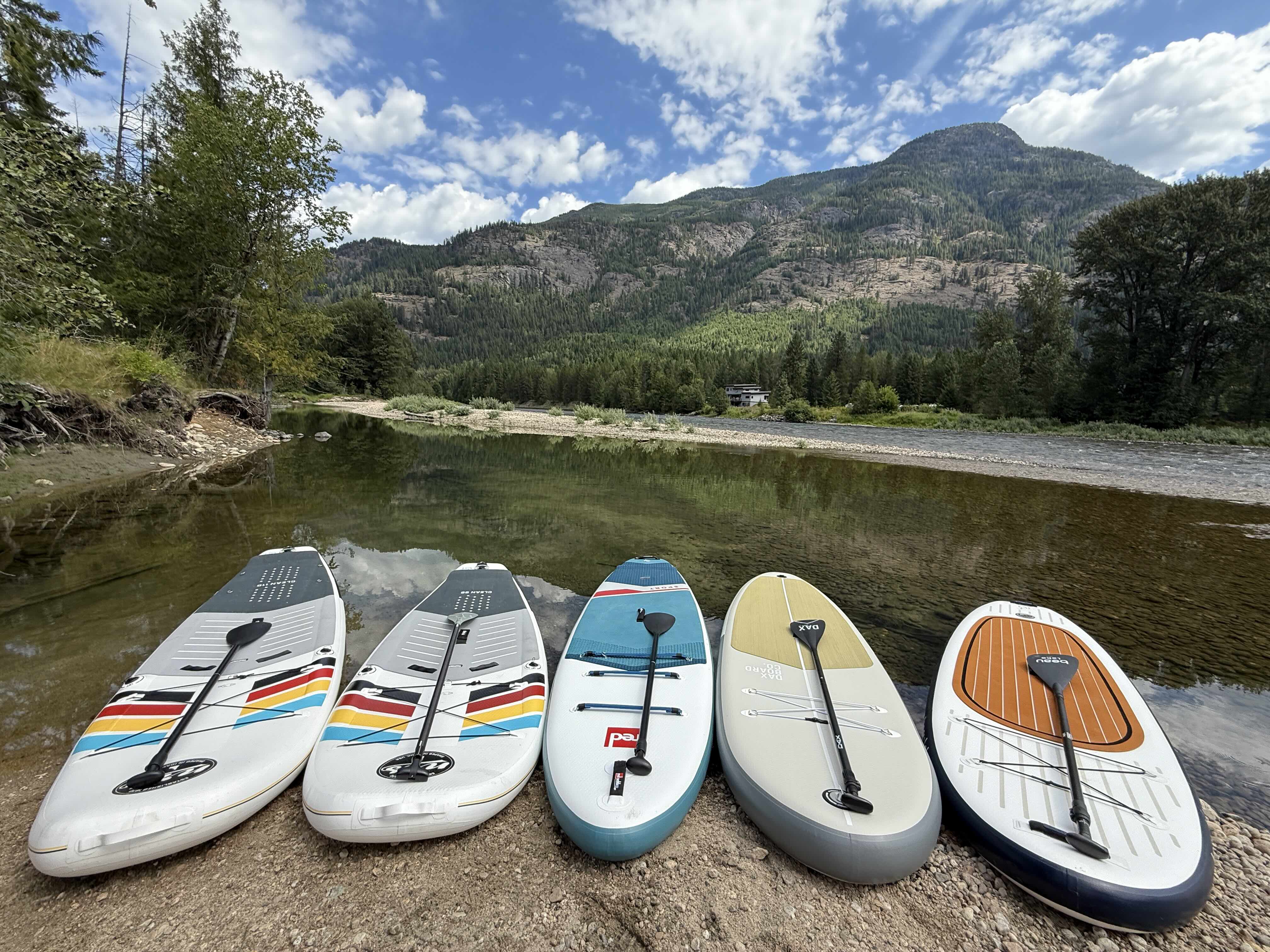
Inflatable designs are super popular because they’re easier to store and transport than a rigid board. But they do require energy and time to inflate every single time you use the board. Typically, it takes us about 10 minutes to pump up a board — it’s a great warmup before a paddle. It can raise your heart rate and make your biceps burn depending on the psi needs of the day!
They are also generally less performance-oriented than rigid boards in regard to speed and stability.
Inflatable SUPs are a great choice if you will be in low water depths or near rocks, sharp sticks, or logs because they can absorb and handle abrasion and impact better than a rigid board.
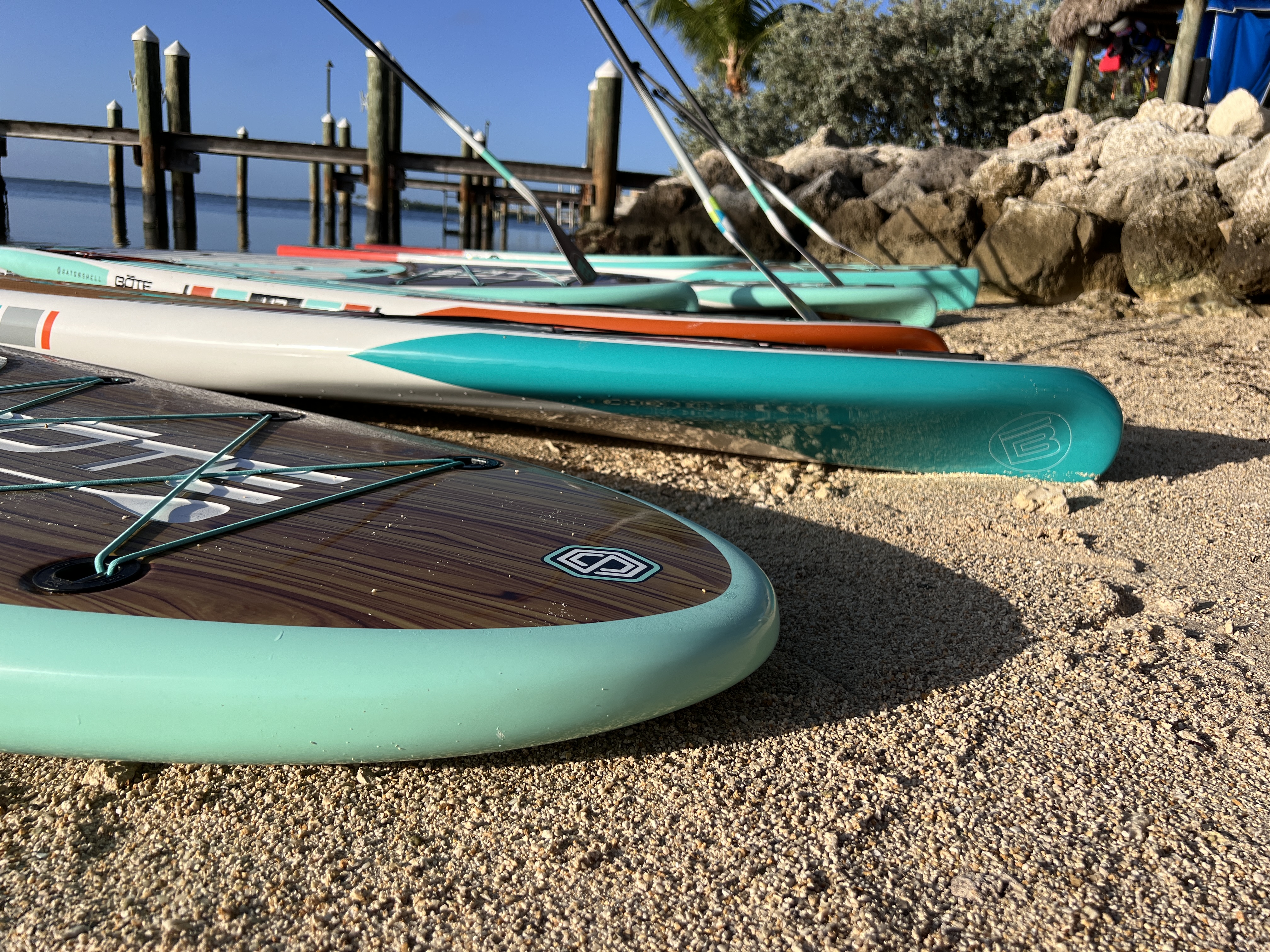
Shape or Hull
The hull is the shape of the board. There are generally two types of shapes for SUPs, which are in simple terms rounder and pointier.
A smooth, non-displacement hull is smooth and makes the board more maneuverable: also known as a planing hull. A displacement hull is sharper and more pronounced, which increases speed and tracking, especially in wind and chop.
Wide & Blunt (Planing Hull)
This SUP design is flatter and rides toward the surface of the water. It’s a design feature for inflatables.
Made with a wider, rounder nose (and tail), the overall shape is stable and easier to turn and maneuver. Planing hulls are used for all-around SUPs. These shapes are generally good for whitewater, surfing (the shape is similar to a surfboard), and practicing yoga on a SUP.
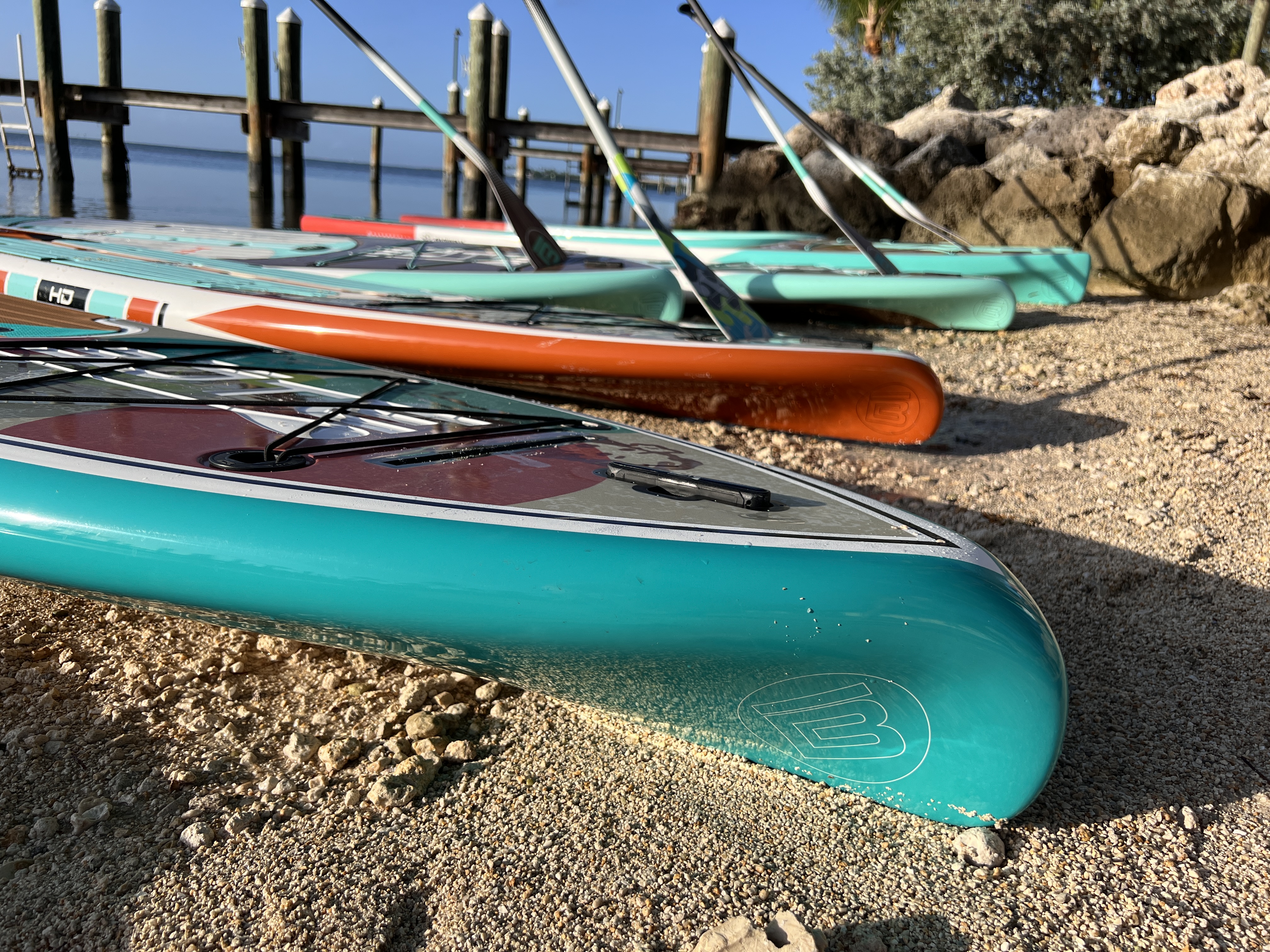
Narrow & Pointed (Displacement Hull)
A displacement hull is narrower and the nose is pointier, so that the board smoothly cuts through the water and tracks well. The articulation of the nose goes below the surface of the water. A displacement hull increases efficiency: Experienced paddlers will complete 10 paddles per side compared to three to four paddles per side, which is the average strokes that can be reached with a rounder planing hull before needing to switch sides to maintain a straight trajectory.
The tail is often flat instead of round. Flatwater or touring and race-specific boards typically have a displacement hull.
This design is a good choice for competitions, events, and speed-oriented workouts or covering long distances.
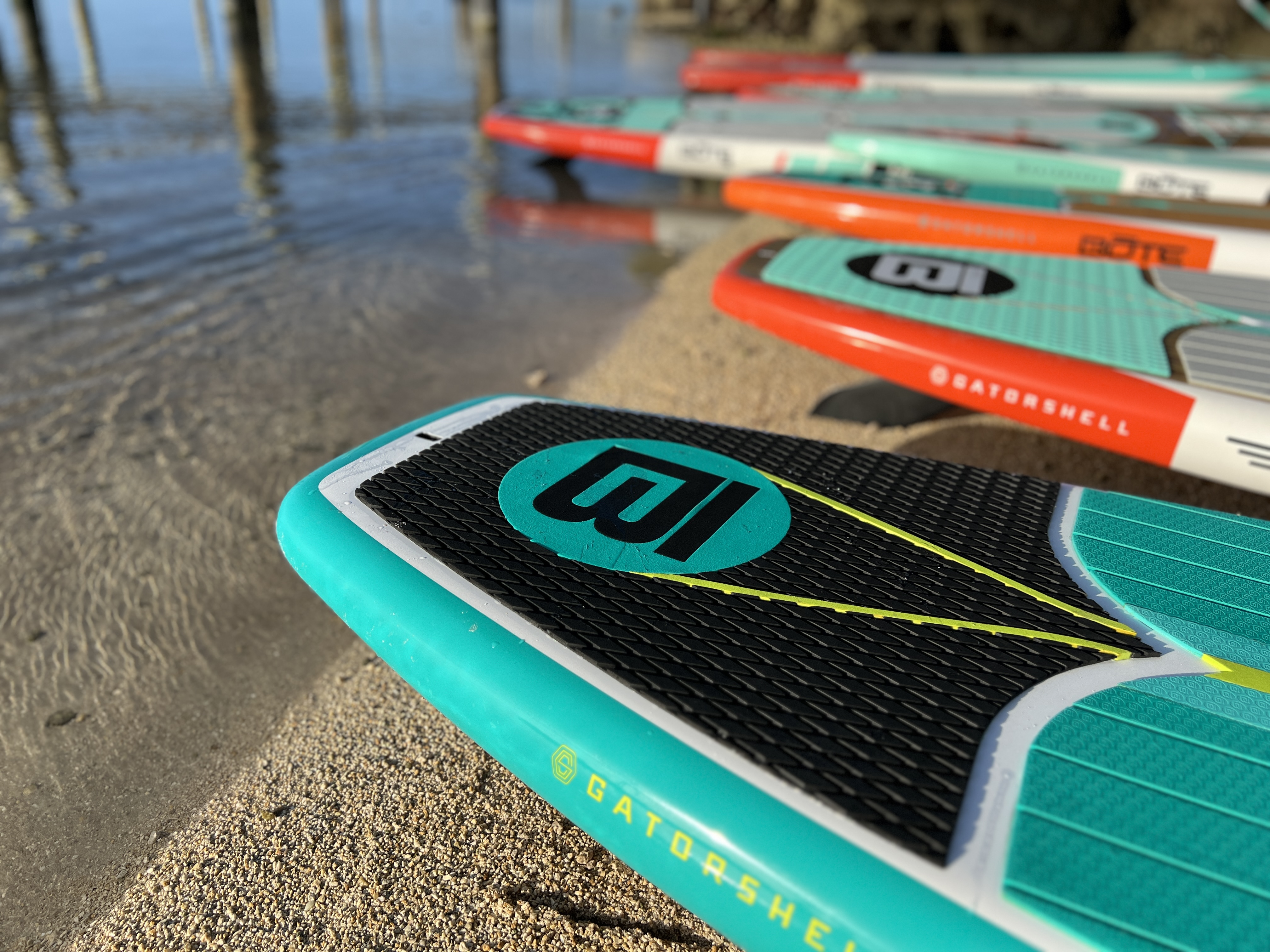
Length & Width
With boards, the length and width correlate to overall volume and weight capacity. Overall size influences how nimble a board is in waves or whitewater (relative to the paddler size and cargo weight) as well as the board’s stability. If ocean surfing is your focus, go shorter. For an all-around board, choose a moderate length. If your priority is long-distance tours, opt for a longer board.
Otherwise, if you weigh 140 pounds (and want the board to be extra speedy or maneuverable), you have the option of choosing a shorter length — and, therefore, lower volume — board. If you weigh at or over 180-200 pounds — or if you want to paddle with a dog, child, or partner — consider a longer length and wider board. Also, consider if you want to travel super lightweight such as on short day trips. Or if you need plenty of storage for cargo, such as dry bags and a cooler.

In general, here are the guidelines for short, moderate, and long boards:
- Short: Less than 10 feet
- Medium: 10 to 12 feet
- Long: Greater than 12 feet
Widths range from around 25 inches to 35 inches or more. Adding width increases the volume, which improves stability and capacity for hauling gear. Narrower boards have less drag, move faster, and can more easily pivot.
Generally, we recommend a slightly larger board to new paddlers to offer more stability. The most common size boards are 10’6″ or 11′. But there are plenty of lengths, shapes, and sizes beyond that range.
If you’re shopping for a family, you can save buckets by purchasing one longer, wider board instead of two (or four). For instance, two 140-pound adults can comfortably fit on an 11′ board (the fit and weight limit will vary by brand). Like kayaks, there are even tandem-specific models out there (ranging from 12 to 15 feet in length).

Weight & Weight Capacity
Inflatable SUPs generally weigh less than rigid boards. All of the inflatables in our guide weigh under 31 pounds. The heavier boards include the 30-pound BOTE HD Inflatable Paddle Board. The lightest board on our list is the 12.9-pound Kokopelli Chasm Lite.
The weight capacity is how much a SUP can safely carry, including paddlers, pets, catch, or cargo.
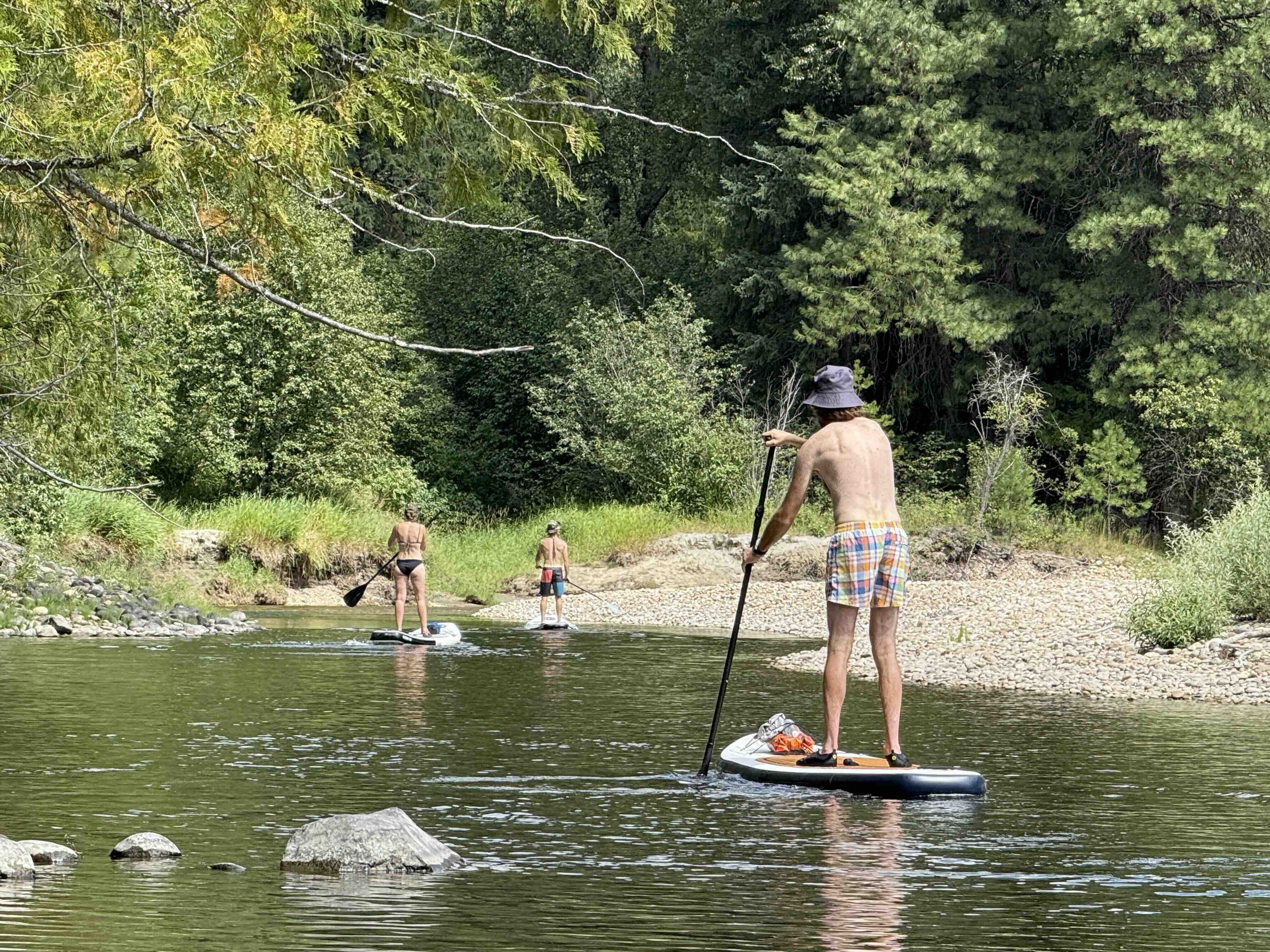
When you trim a SUP’s grams, typically, the board has a lower weight capacity overall. However, there’s not a direct correlation so pay attention to those numbers. For instance, the BOTE HD Inflatable Paddleboard weighs a tad less than other models, has a greater overall volume, and can carry 315 pounds.
For instance, the iROCKER Cruiser Ultra 2.0 can carry 300 pounds.
Deck Pad
The deck pad covers the top of the SUP where the paddler will sit or stand. Coverage varies per board, and some boards have wider, longer patches of pad than others. The material blend is unique to each brand but often includes plastic.
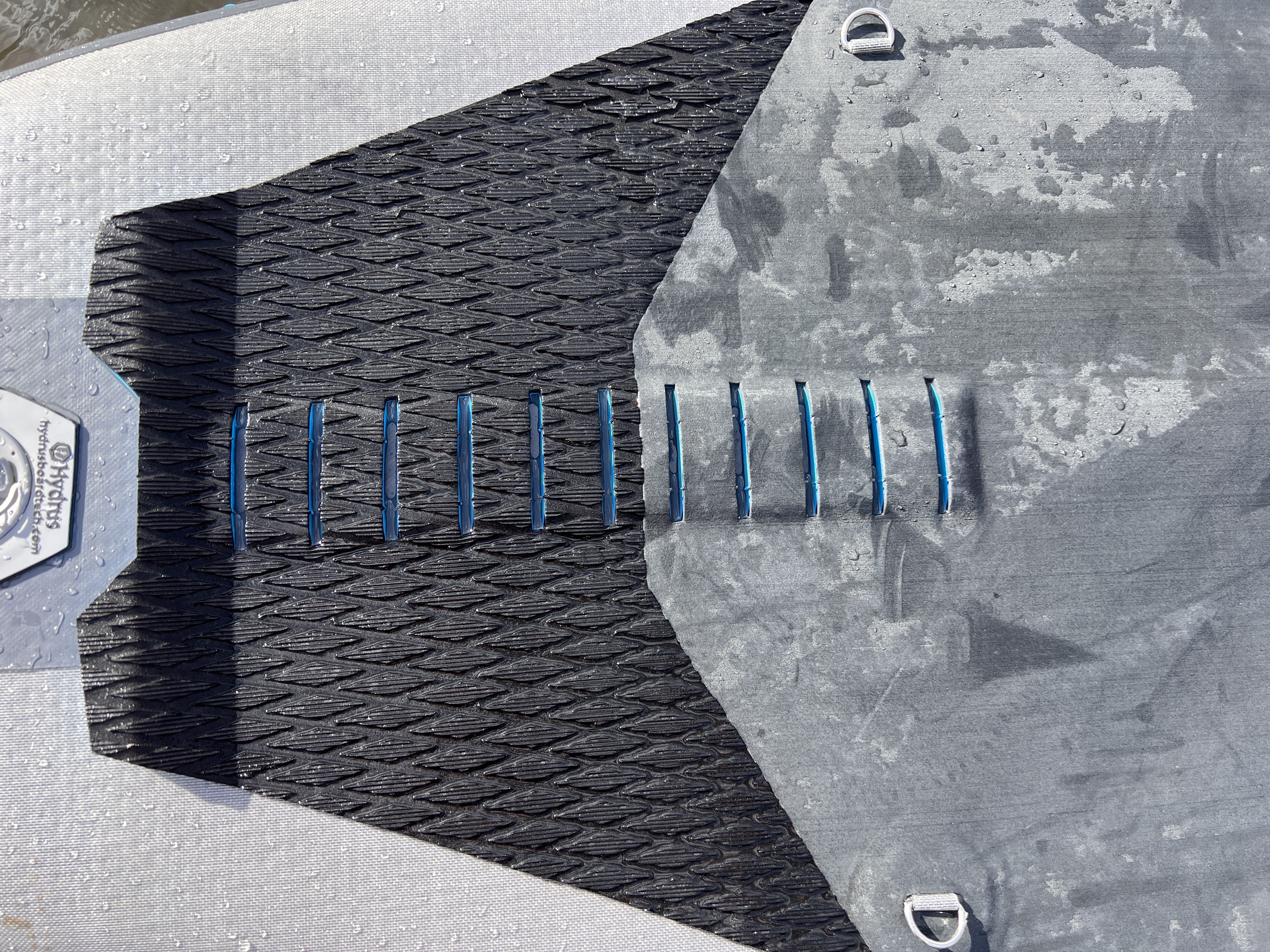
The materials offer traction and grip, and they generally feel soft and cushioned. However, that doesn’t mean you can’t get burned from friction. If you plan to paddle whitewater or uneven water, don’t be ashamed to wear knee pads, especially on a long trip.
One of our favorite deck pads is on the Boardworks SHUBU Riptide. Using a material that looks like honeycomb and feels like a therapeutic, thick yoga mat, it makes standing, sitting, kneeling, or practicing yoga poses much more comfortable.
If you paddle with kids, dogs, or other passengers, it’s really nice to pick a board with a deck pad that goes from tip to tail for full traction.
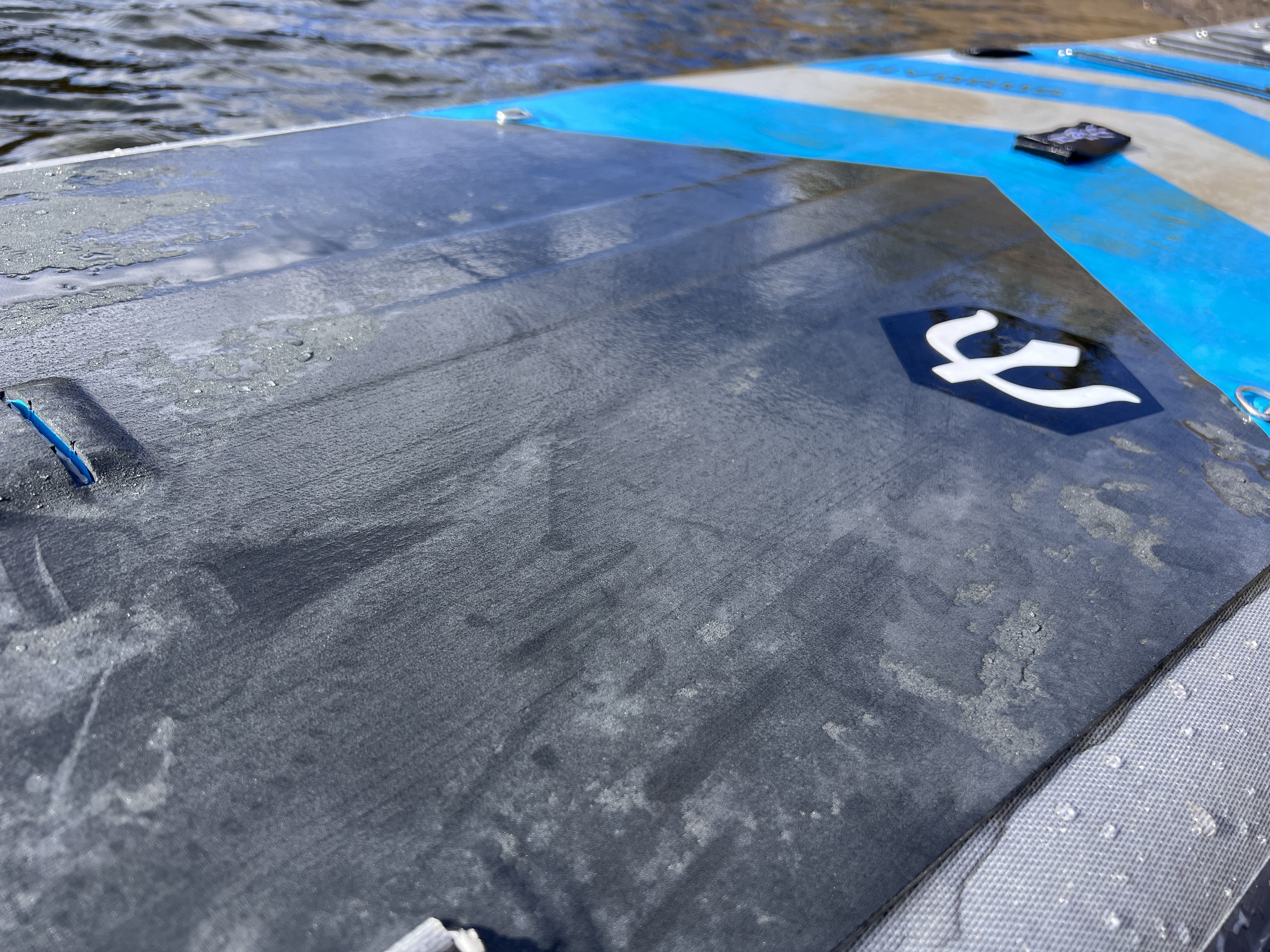
All-around or whitewater boards typically have a deck pad that covers the majority of the board’s surface and at least covers the center to the tail, given the paddler will be making more dynamic paddling strokes and moving around to shift weight on the board. For instance, the Boardworks SHUBU Riptide is almost entirely covered in a cushioned deck pad.
Comparatively, the EVA deck pad on the iROCKER Cruiser Ultra 2.0 is split in the middle with two strips where the paddler is likely to stand, which helps trim down weight.

Rails
The SUP rail is the edge around the board. The rail materials can vary, and the shape can be rounder or more angular.
Rails are important to pay attention to because they can often be the first place on a board to get dinged or begin to deteriorate through use. It’s good to know how to repair a rail and have your repair kit on a trip.

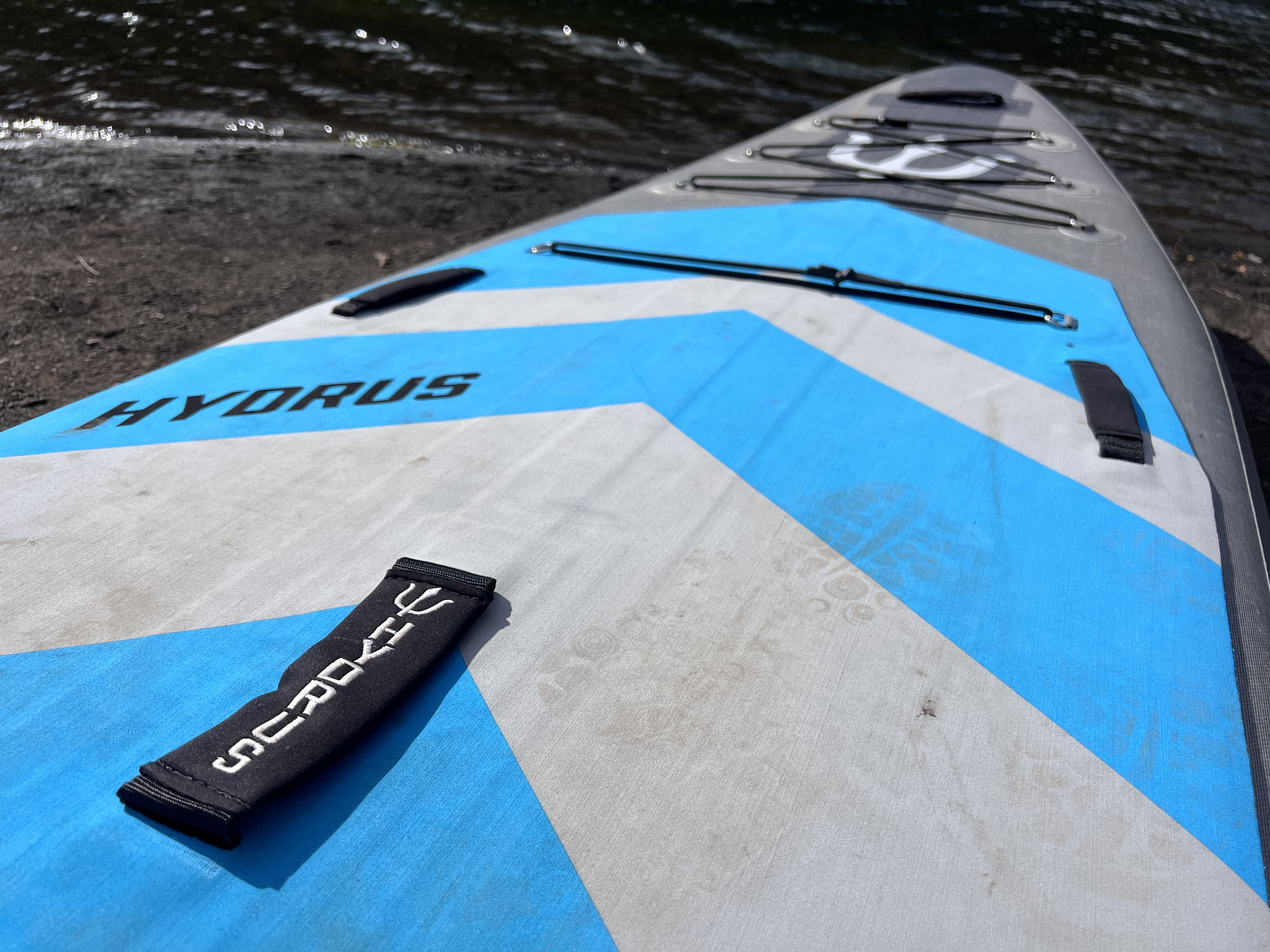

Handles
Many SUPs are designed with a well-cushioned, ergonomic carry handle in the center of the SUP, so you can carry it under your arm. There can also be carry handles at the nose and tail. Some carry handles are more comfortable than others, and not all are cushioned. The Hydrus JoyRide has five very plush grab handles: three in the center of the board, one on the tail, and one on the nose.
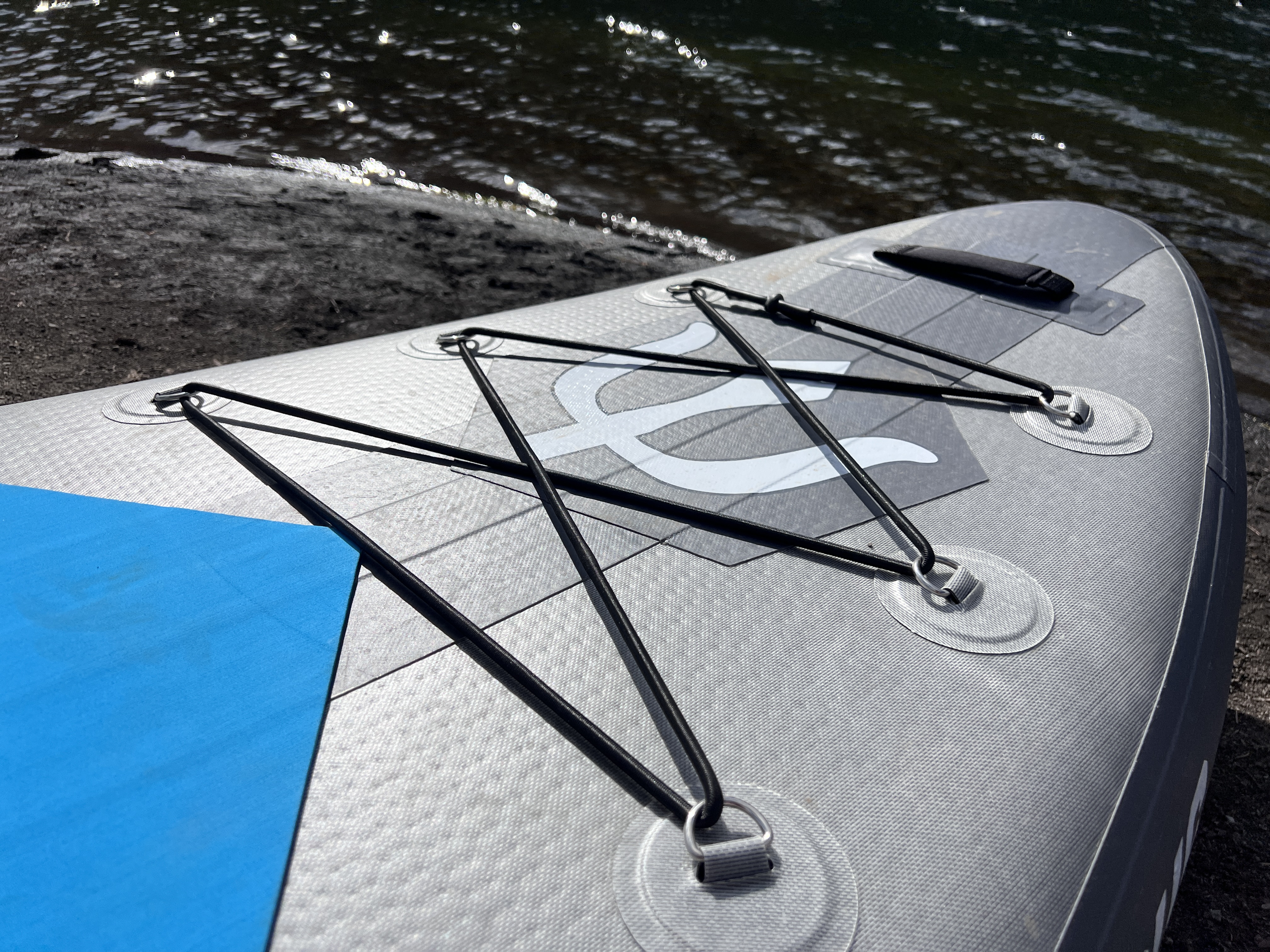
Tie-Down Points & Bungee Straps
Various tie-down points exist on SUPs. Many designs feature bungee cord nets fixed to the front or back of the board (or both).
For overnight paddle trips and whitewater trips, our favorite feature is stainless steel D-rings — they’re easy to clip or thread tie-downs into, reliable, and super sturdy.
Other rings include soft rings, which are not as quick to thread, and plastic rings, which are not as durable as stainless steel.
Certain SUP designs feature specific attachment points for brand accessories tailored to certain sports like fishing and touring. The BOTE HD Aero Paddleboard is compatible with removable rack receivers for the brand’s tackle rack or bucket rack accessories for anglers.
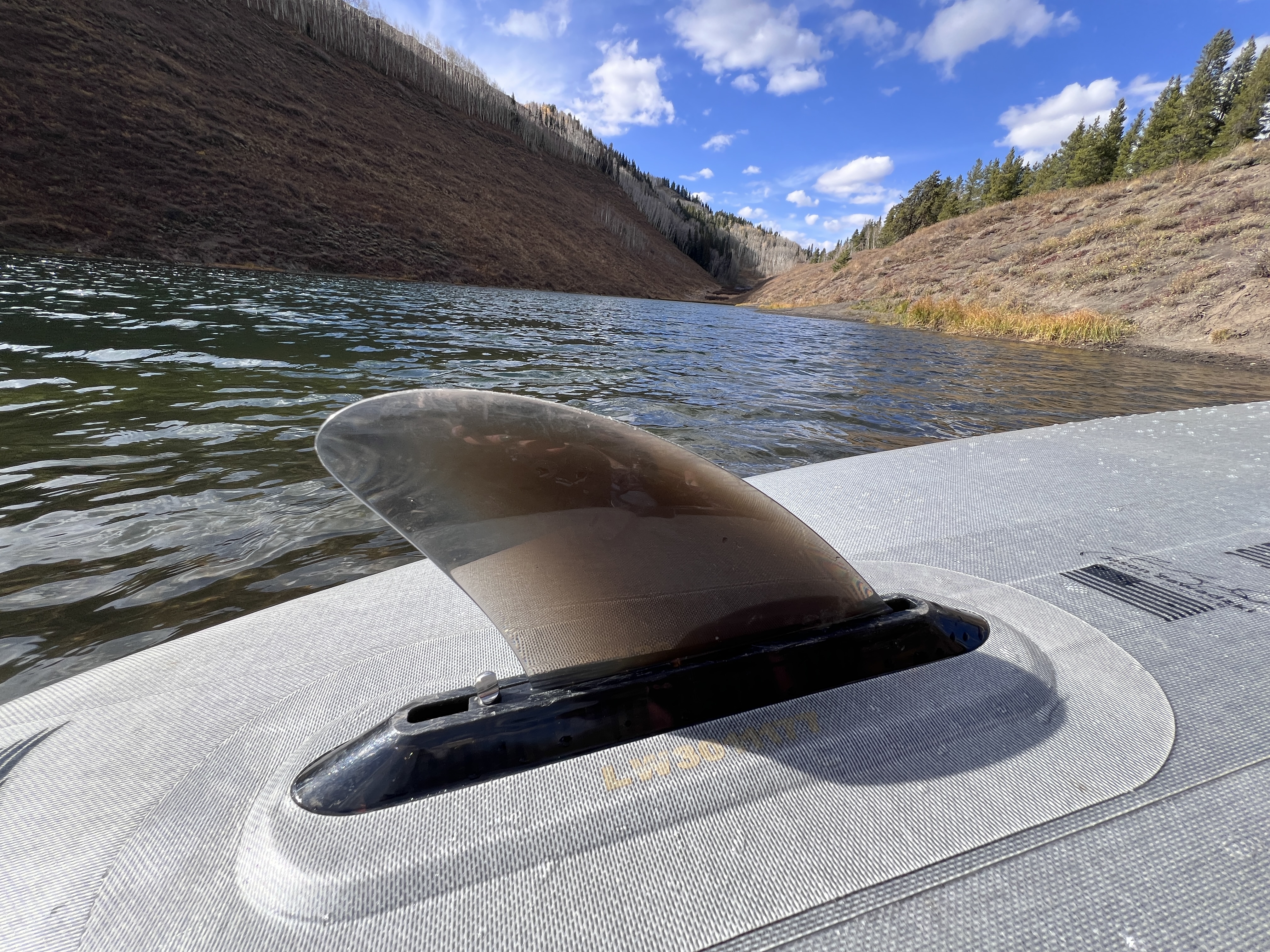
Standup Paddleboard Fins
Fins beneath the board near the tail help a board track well (read: stay straight) in the water and help increase stability. Sizes and shapes vary. The longer the fin, the more influence it will have on tracking and stability. In contrast, shorter fins are great for shallower water like low-volume rivers, certain beaches, or areas with lots of vegetation like seagrass. Often, folks refer to fin size in regard to the length of the fin or how much it protrudes into the water.
Lots of paddle brands offer removable and interchangeable fins for various types of water. Certain boards have a mix of both fixed and removable fins, like the BOTE WULF Aero 10’4”, which has two fixed side fins and a removable larger center fin.
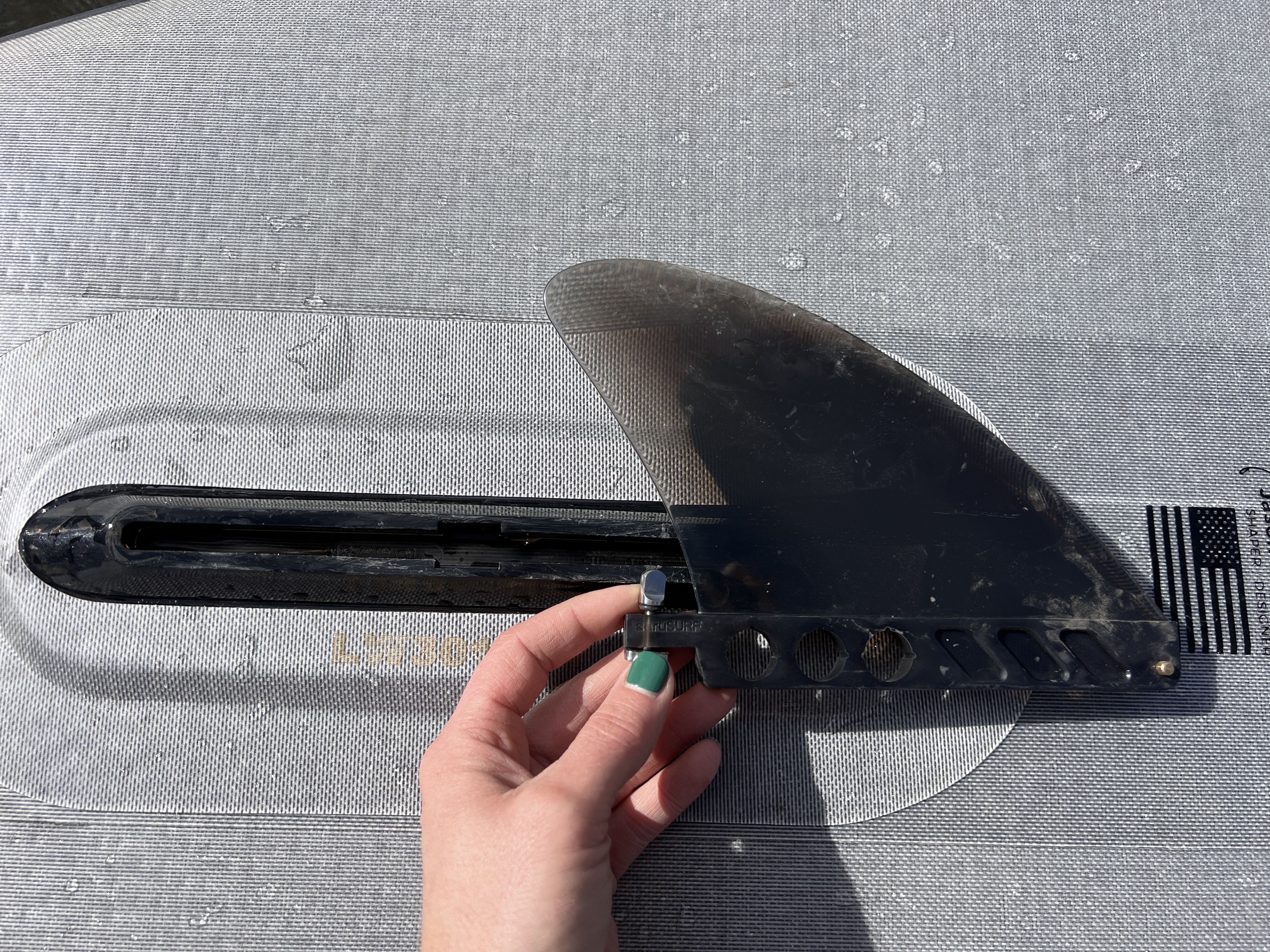
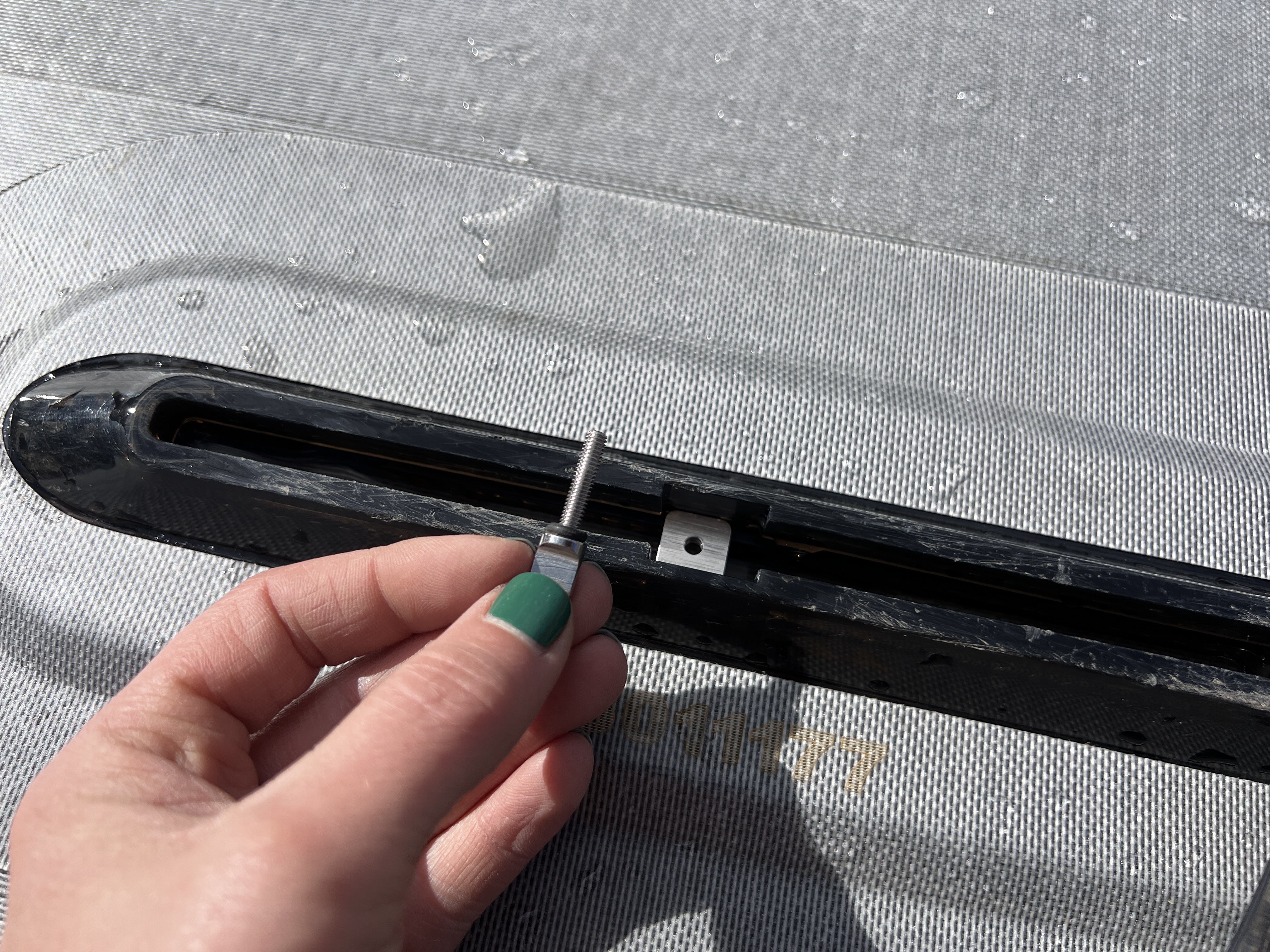
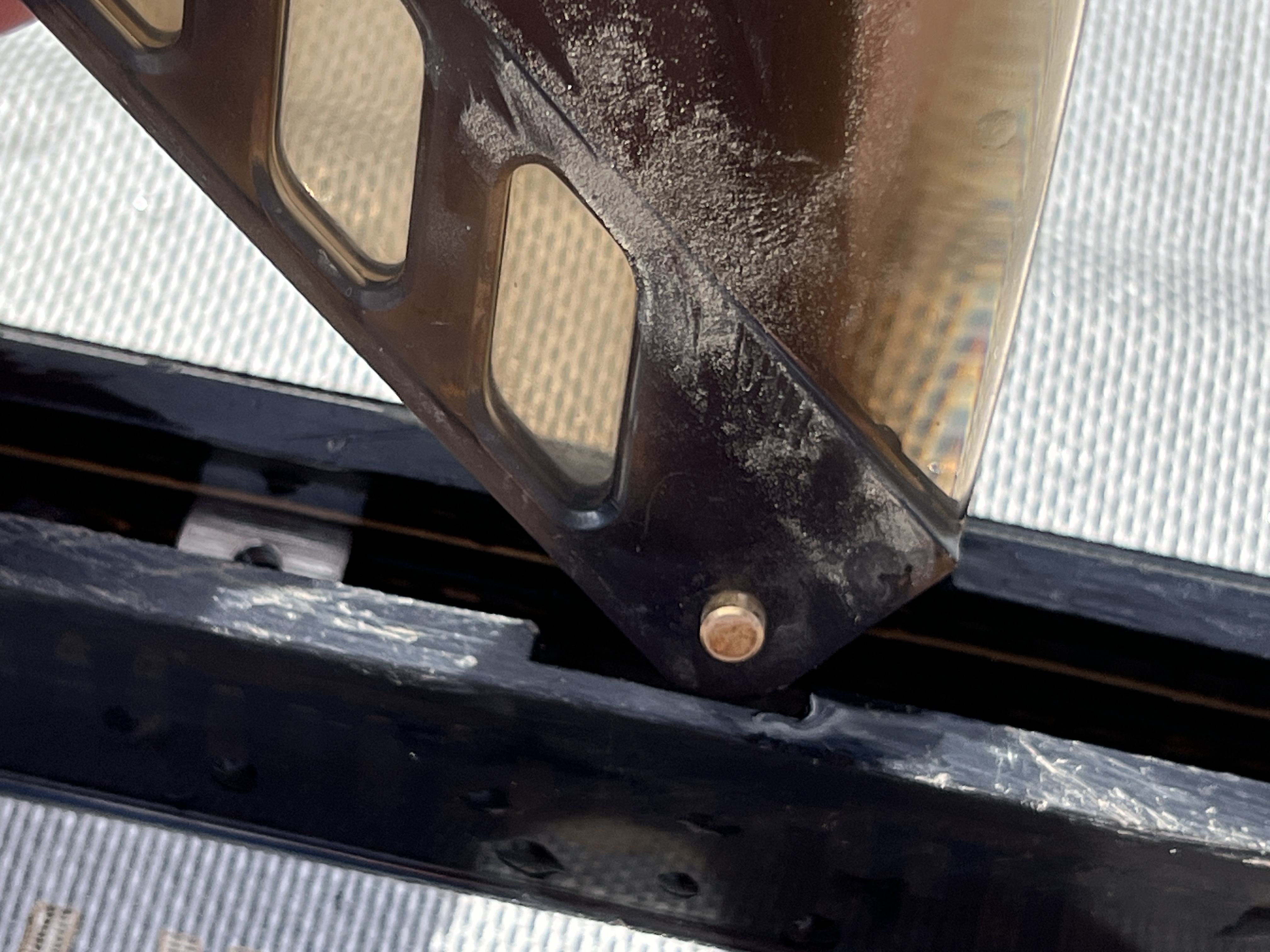
A removable fin attaches to a board via a fin box or plate, which is where the end of the fin slides or snaps into place. Note: not all fins are compatible with all types of fin boxes.
A variety of fin configurations exist:
- 1-fin: One single, usually longer fin that is placed in the center
- 3-fin: Three fins that are equal in length and size and spaced evenly apart
- 2-fin: Two fins that are equal in length and size and space evenly apart
- 2 plus 1: One single larger fin in the center and two smaller fins on either side
If you know you want to take your board out on both flatwater and whitewater (or the ocean), invest in a brand that has a surf fin in its lineup. Some brands also offer spare fins with a purchase.
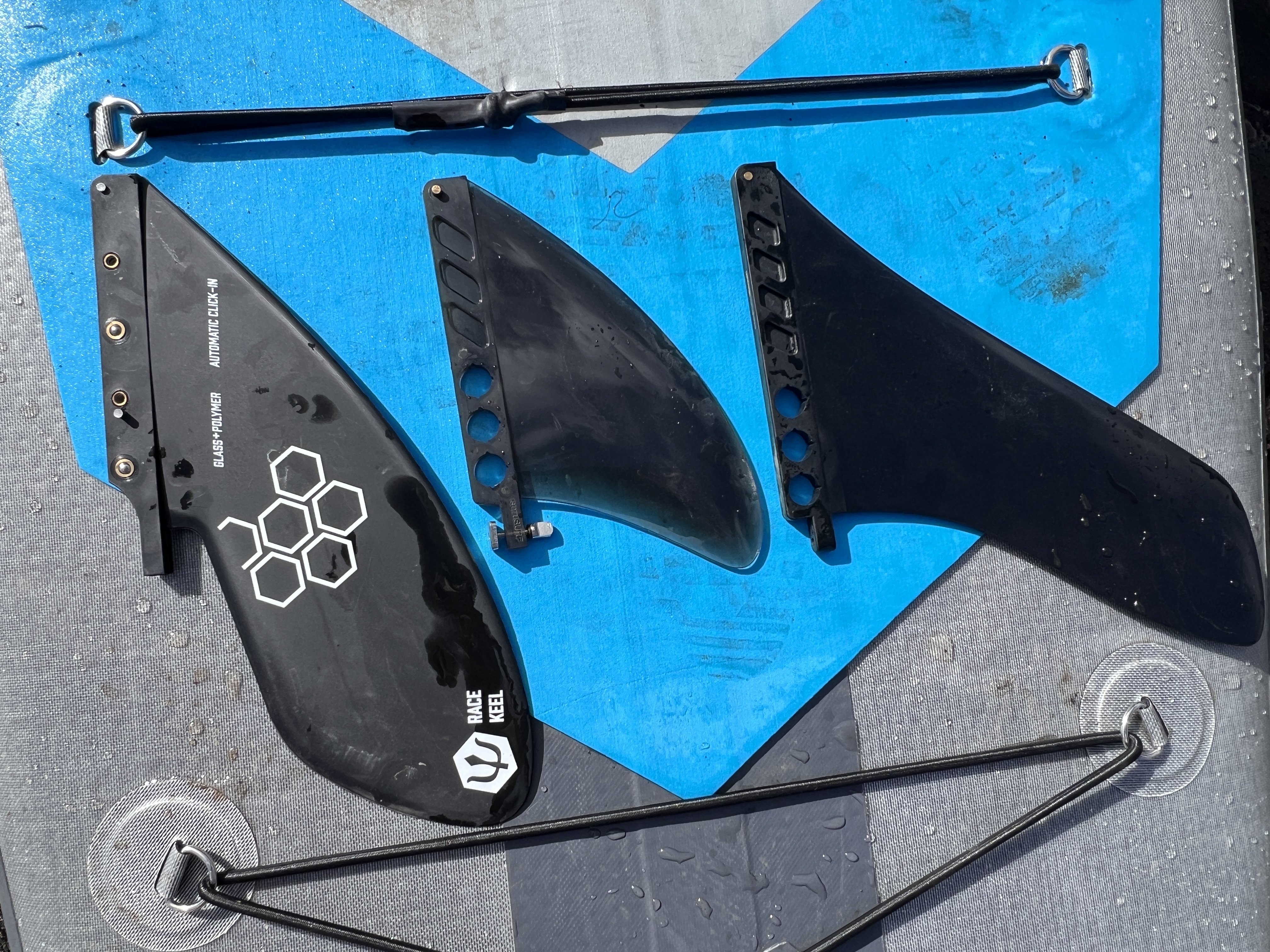
Standup Paddleboard Paddles
The majority of SUPs include a paddle with purchase, but not all. One of our favorite designs, the Hydrus JoyRide, includes a collection of great accessories, but the paddle needs to be purchased separately. Generally, an inflatable SUP includes a multi-piece or three-piece paddle that breaks down and fits well in the travel bag. The length is adjustable.
A paddle has a handle at one end connected to the shaft and a blade (which goes in the water) at the other end. Nicer paddles have more ergonomic handles.
Paddle shafts are usually made of aluminum, glass fiber, carbon, or Kevlar. Carbon is the most performance-oriented because it’s lightweight and strong, and the investment could be worth the long haul.
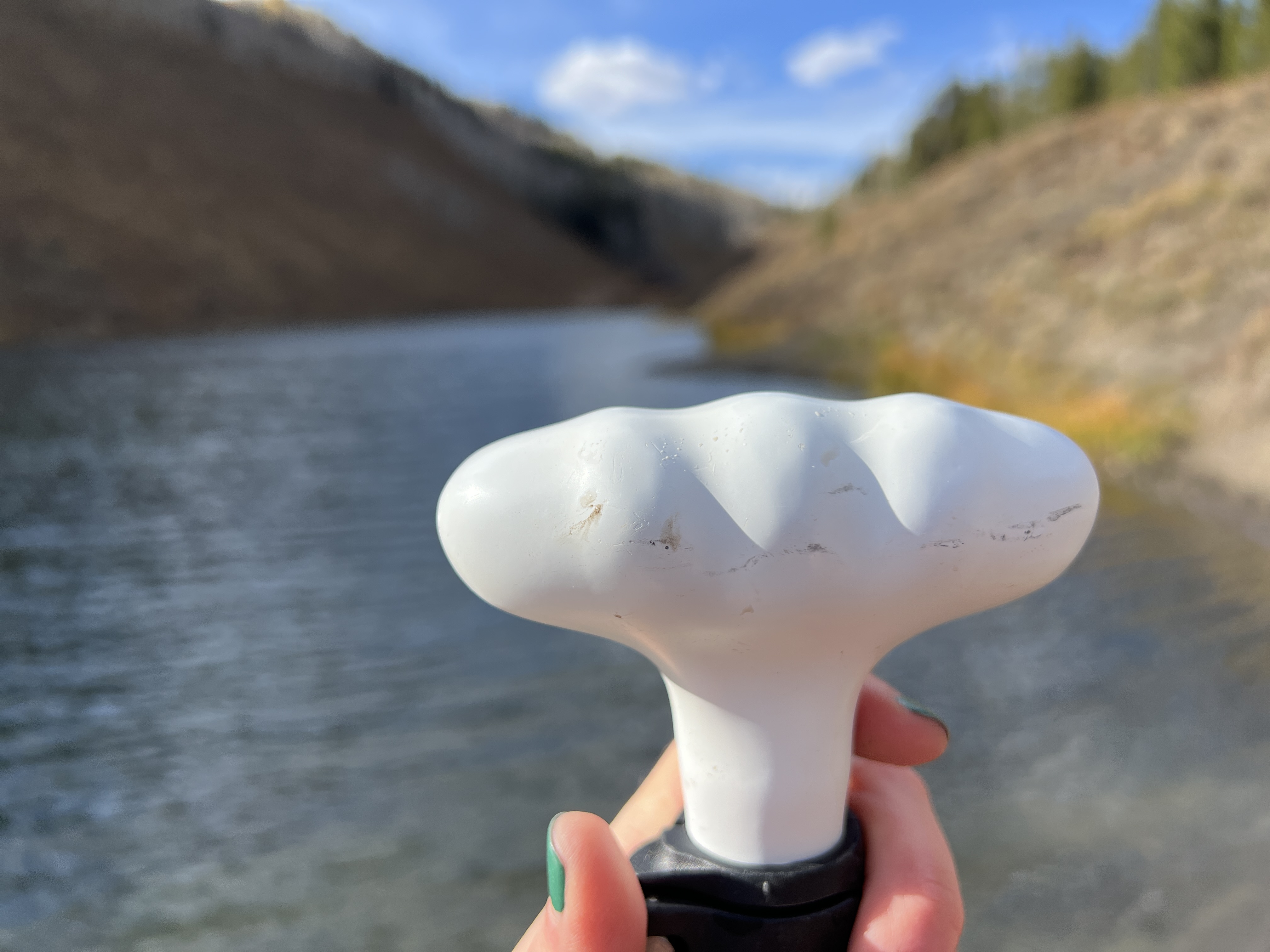

Leash
A leash is helpful if you fall off your board and don’t want it to float away, especially if it’s breezy or wavy or if you pushed the board away as you toppled over. A leash is also a tool used by flatwater racers, given their speed. Many SUPs are made with a leash attachment point like a D-ring.
Some SUP packages include a coiled leash that attaches to the board. The other side of the leash is padded and attaches with Velcro around the paddler’s ankle, such as the one made by BOTE ($44).
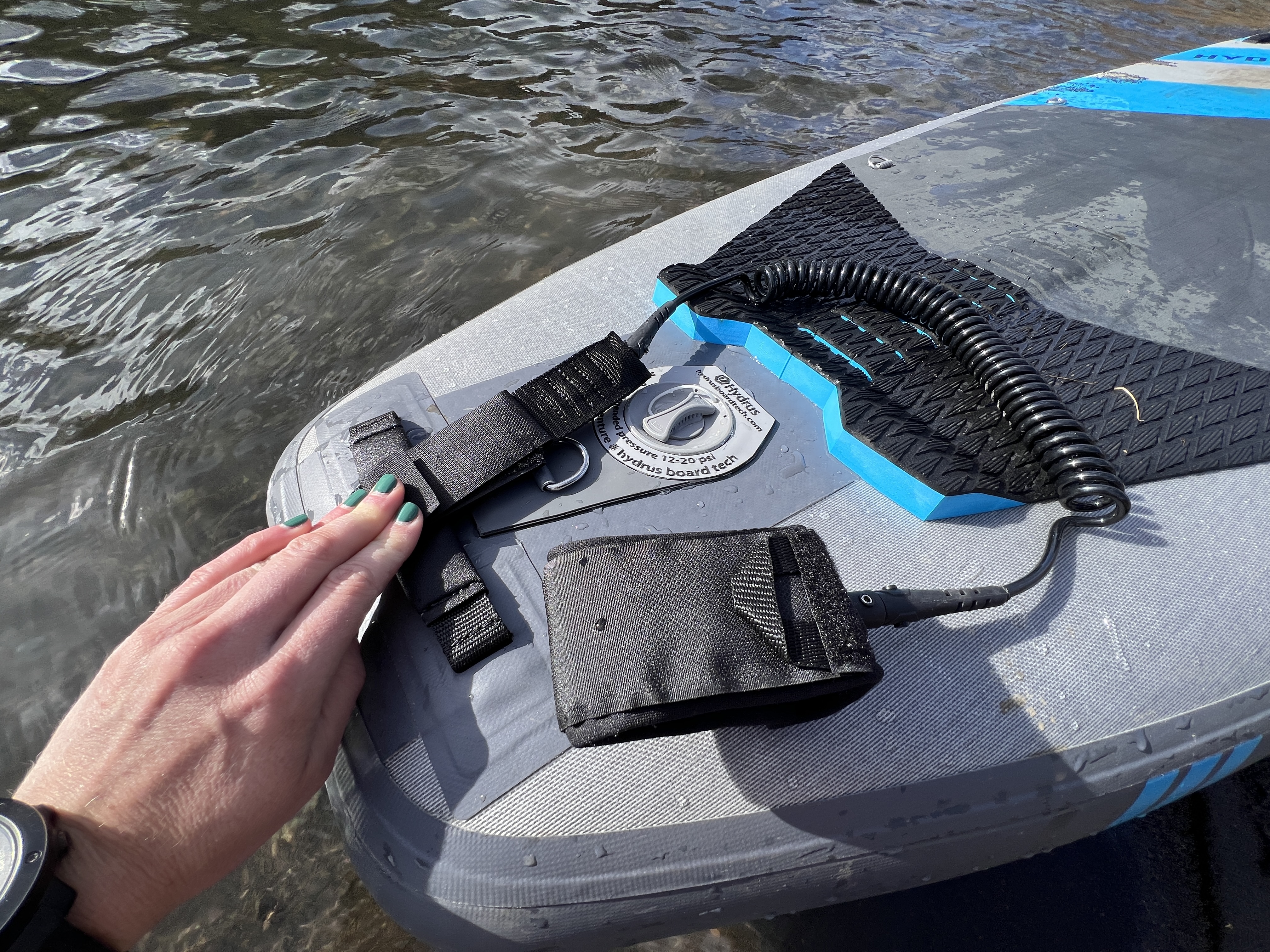
However, there is major contention nationwide regarding the safety of using a leash on a SUP (and on a river surfboard), especially in turbulent, quick-shifting, debris-laden water. The industry lacks universal standards regarding this piece of gear. Fatalities have occurred due to leashes getting lodged in underwater debris when a SUPer falls off in fast-moving river water.
To help increase a paddler’s ability to disconnect themselves from their setup, multiple brands have designed quick-release leashes such as NRS ($64), Hala ($80), and Level Six ($50). If you purchase a quick-release leash, be sure to practice and confidently know how to effectively and efficiently use it in the water. And no, a leash doesn’t replace the buoyancy and safety of a PFD (personal flotation device). Be sure to follow the PFD, or life jacket, regulations where you plan to SUP.

Travel Bags & Straps
Travel bags are usually included in the package for an inflatable SUP, and they often have a backpack design with padded shoulder straps, a hip belt, and a chest strap. Other travel bags even have durable wheels so they can be rolled. Typically, the bags have zippered, Velcro, or sleeve pockets on the exterior or interior. Bags are a great way to keep all of the accessories in one place, including the fins, hand pump, and patch kit.
The most unique travel bag design we’ve seen is the one made by Red Paddle Co., which comes with the MSL 10’6″ Ride SUP. Great for minimal approach hikes, the SUP offers the option to fully isolate the shoulder harness from the rest of the roller backpack, leaving behind a simple system of straps that attach horizontally and vertically around the SUP. For a streamlined paddle day, this arrangement is great.
One alternative to a travel bag is an adjustable carry strap, called Travelink (sold separately), that attaches to the rail of certain BOTE SUPs for easier transport.
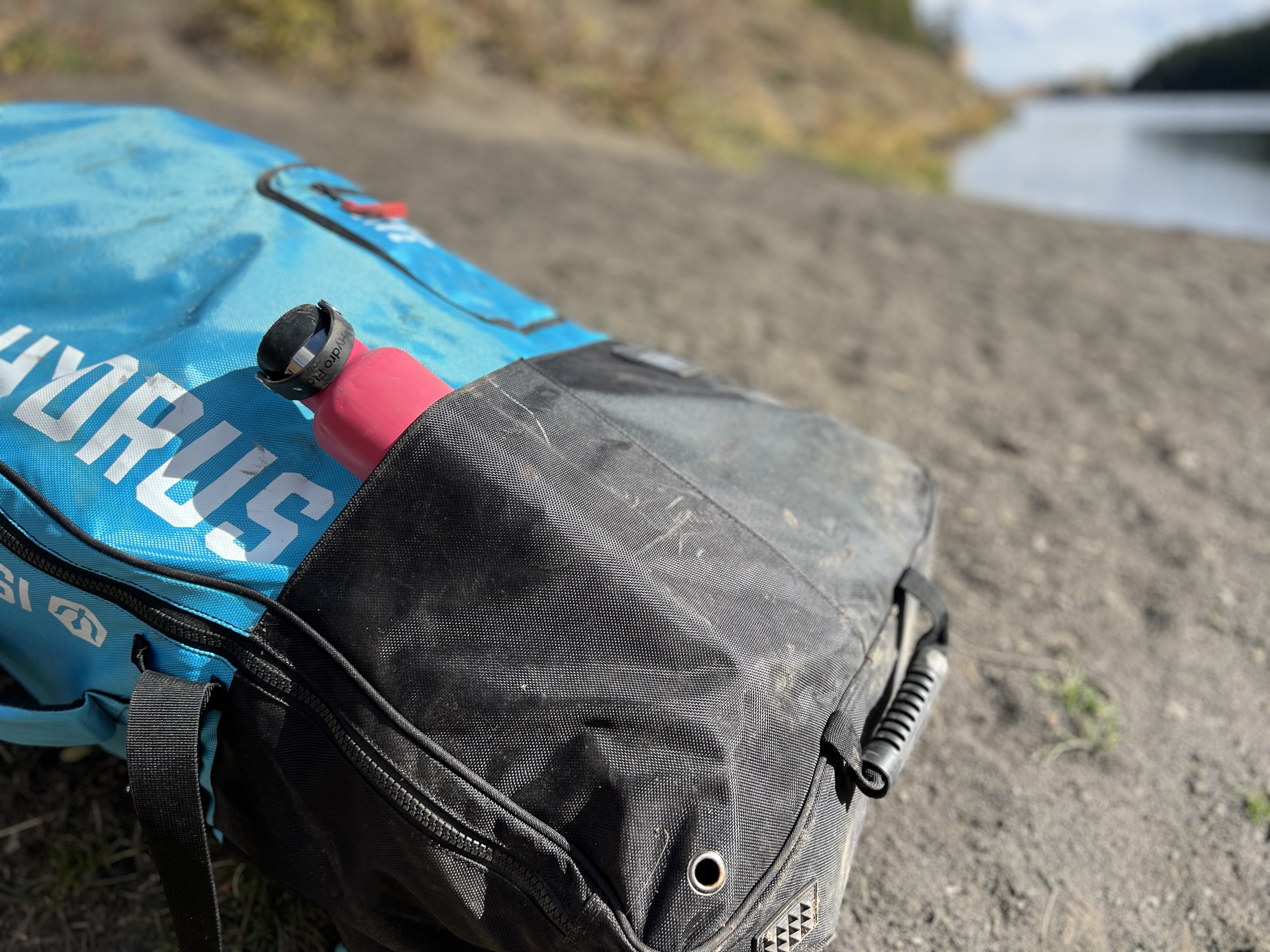
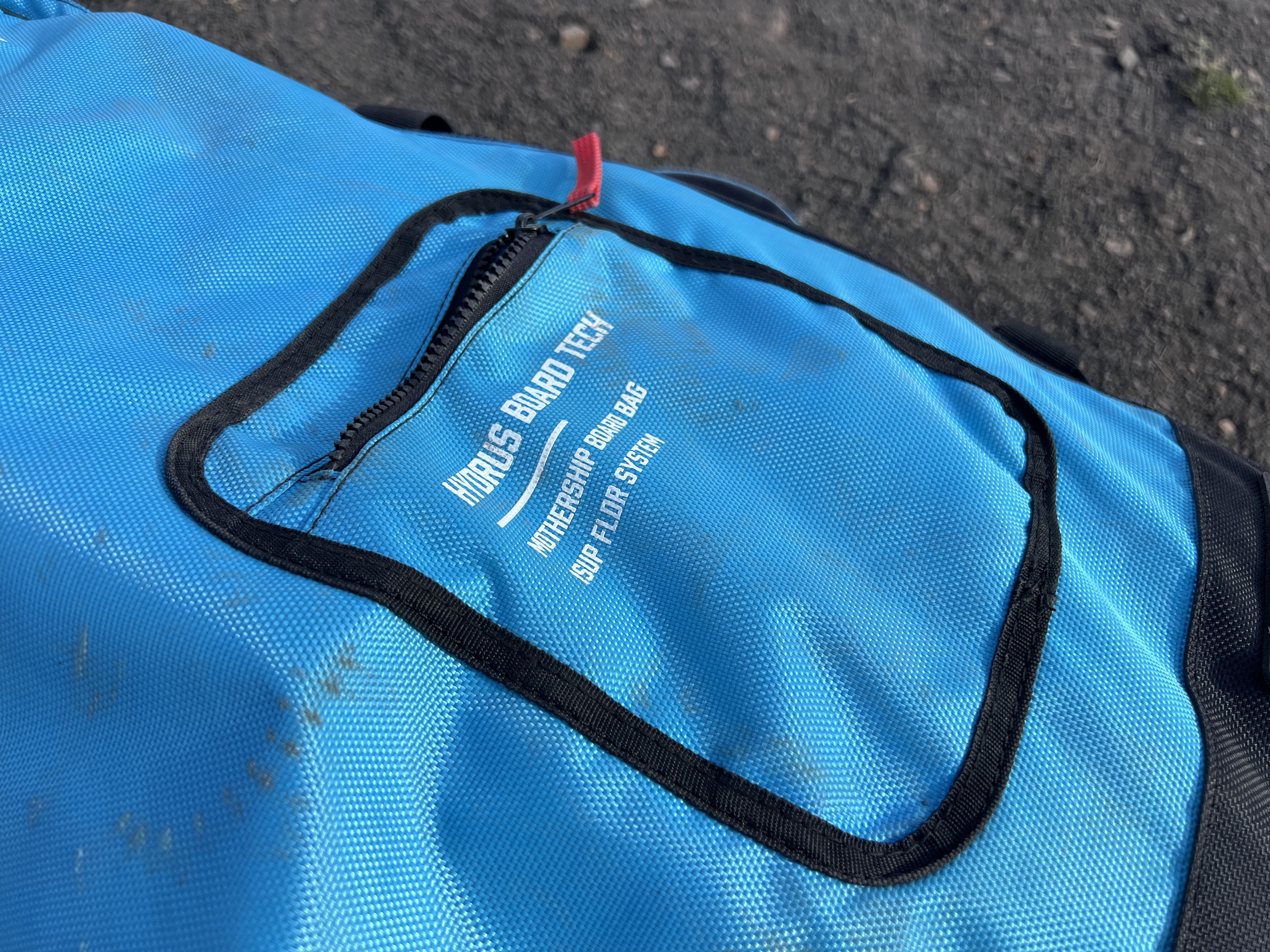
Repair Kits: What’s Included
It’s not every day that you have an opportunity to watch a 7-year-old bomber SUP finally bust at the rails from general wear and tear. But it can happen — and happened to us — so be prepared. Always carry at least one repair kit on a trip, and know if the supplies are an adequate quantity to fix your SUP, plus the other boards, if there’s a gear emergency.
Many SUP bundles include a repair kit. Prepacked repair kits from manufacturers typically include:
- A brightly colored, solid waterproof case
- PVC glue (polyvinyl chloride, a type of plastic)
- PVC patches (circular — you can cut down with a pocket knife but be sure its large enough to keep the hole closed)
- Valve tool that can tighten or loosen the valve point on your SUP
In our experience, a single fix in the field can require nearly all of the kit’s supplies. So, if you’re doing a longer multiday trip, consider adding extra supplies to your kit or carrying more than one. Also, be sure to not touch PVC glue with your bare skin.

How to Use: Repair Kit Supplies
If air is leaking out of the valve, use the valve tool to tighten it by giving a small clockwise twist. The majority of the time there is a leak, it’s coming from the valve, where dirt can get lodged. A valve tool can also loosen the valve enough to pull it up so you can clean out any debris.
Not all valve tools are interchangeable across valves — so carry the one that came with your board! Some PVC patches are rectangular, and others are circular. Either way, make sure you have a generous amount on hand. If you need to fix even a small hole along the rail, the patch will likely need to extend several inches on either side of the hole in order to fully secure the leak.

Inspect Your SUP
If you see signs of air bubbles around the edge of the SUP, don’t take ‘em lightly — they could burst. It’s especially important to inspect your board after a low-tide day with rocks, following a multiday outing, and after you’ve done a repair in the field.
Before you take off, inspect the valve in addition to the board’s seams.
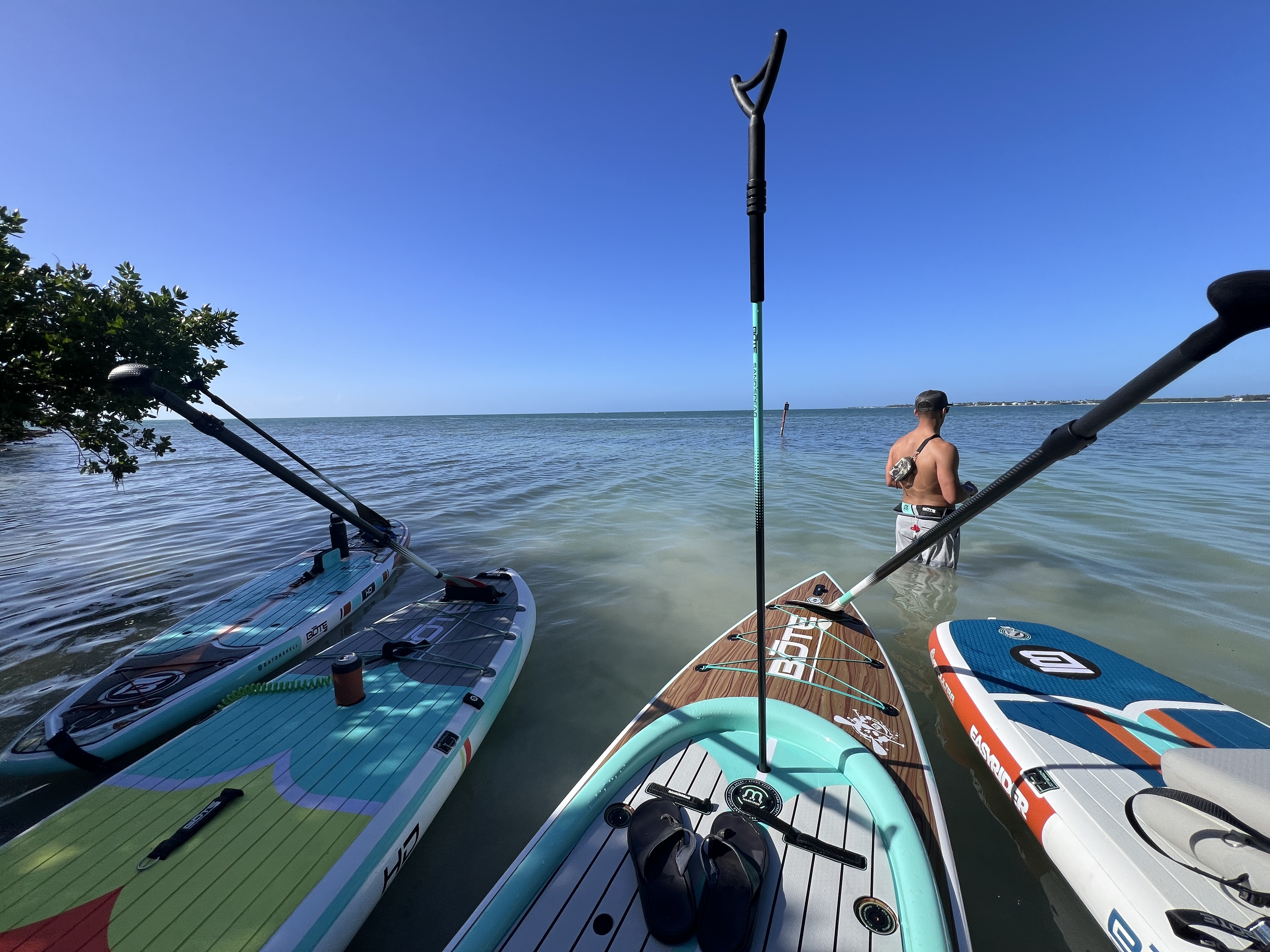
In the Field: Beware of Heat
First things first: Heed that warning label. Do not leave your inflated SUP in direct sunlight, regardless of the board’s age. On one multiday trip after the sun rose and baked our boards on the beach, this caused a seam to leak. Leaving your board sitting out in the sun can also degrade the strength of the material over time, delaminating the board. Not to mention, UV rays could cause the surface and colors of your board to fade.
This is less of a concern if your SUP is parked in the water while sunshine beams down.
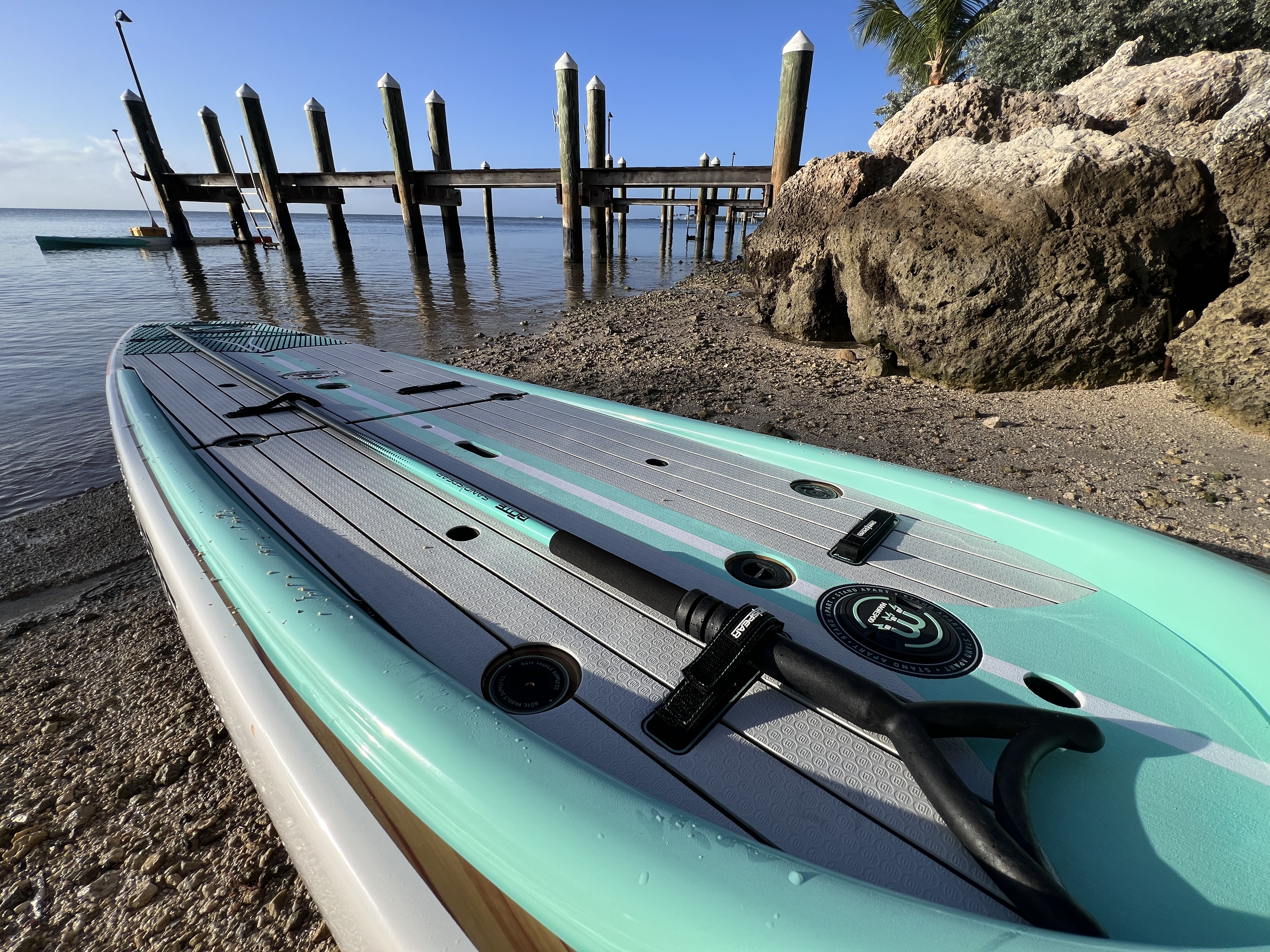
Store in a Cool Place
That goes for storage, too: Beware of heat. A popular option can be to keep your SUP inflated and hang it between outings, but make sure the rack or pulley system allows the board to rest in the shade.
Overall, stashing the plastic at a cooler temperature and out of unnecessary UV rays can help extend its lifespan.
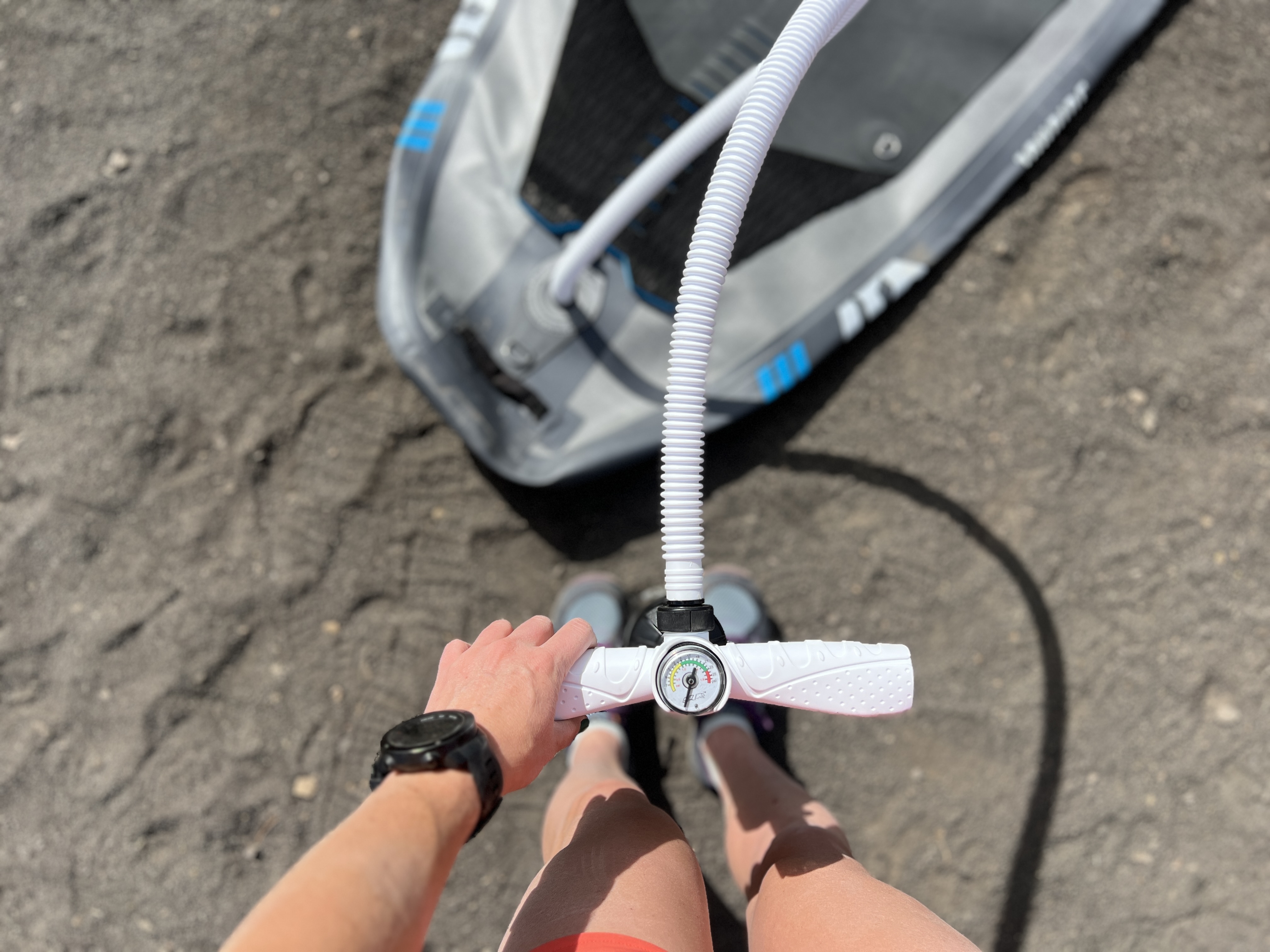
E-Assist Motors & Fins
A handful of SUP companies offer aftermarket e-assist motors that can be added to particular SUP models. In 2024, ISLE launched a custom motor mount — which installs in the fin box — and steering system for electric propulsion (reaching up to 3 horsepower).
The motor was co-developed with Bixpy. At full charge (up to a 5-hour process), the smaller waterproof, rechargeable battery can operate for 70 minutes at full speed: 5 mph. Larger SUPs can carry a larger battery or two batteries on a dual fin box. ISLE makes a power bank, so you can recharge a battery on-the-go, too.
E-assist is helpful if you need to cover more miles to explore new places, if you want safety backup (say, if you’re dealing with a headwind on the return paddle), and anglers often enjoy fully transitioning their SUP into an electrified boat with a linked-up chair and other accessories.
Several other brands offer SUP designs with battery-powered motors like Sipaboards and TAHE, but they both manufacture an integrated motor directly into the SUP itself, which drives up the base price.
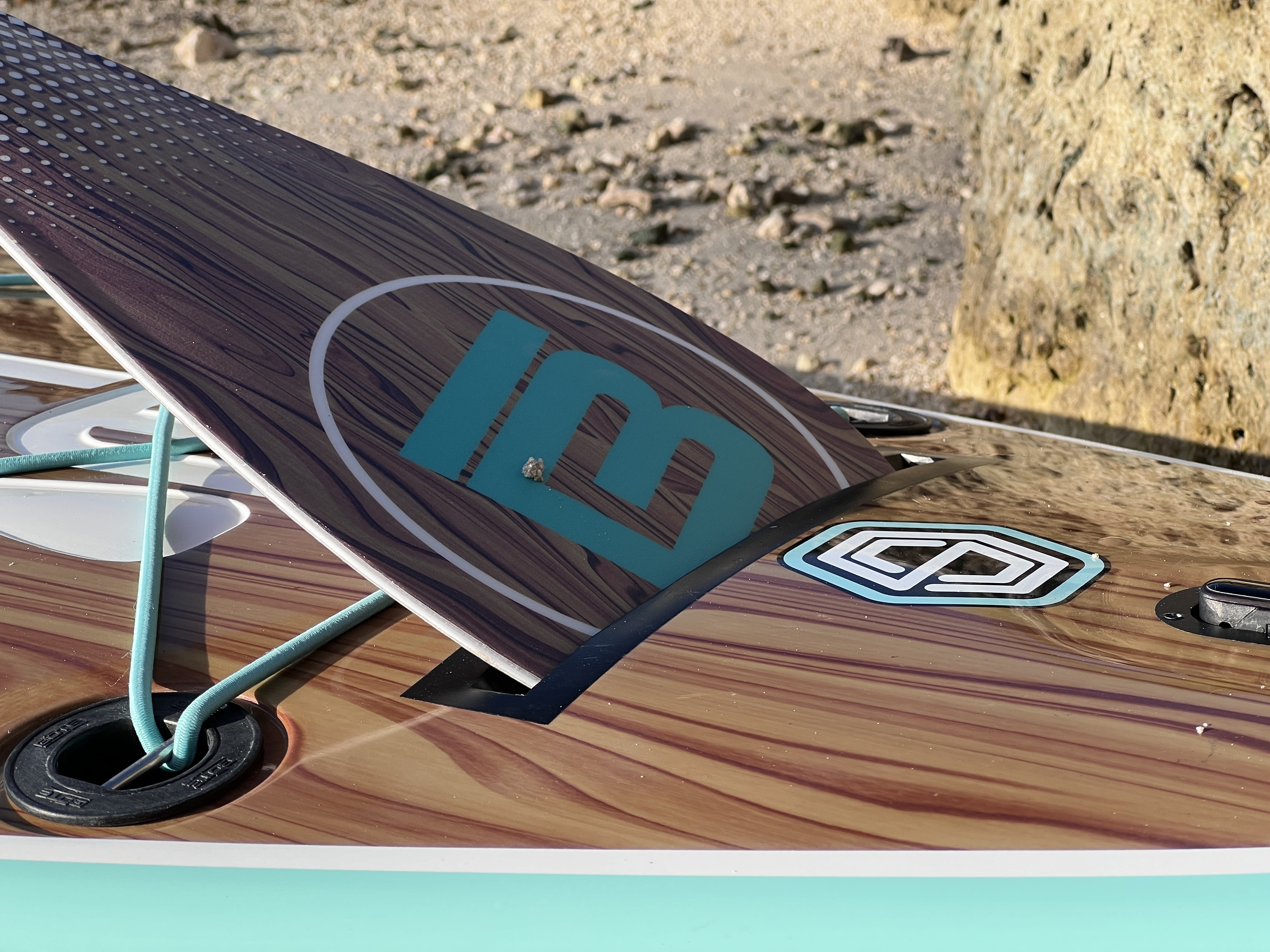

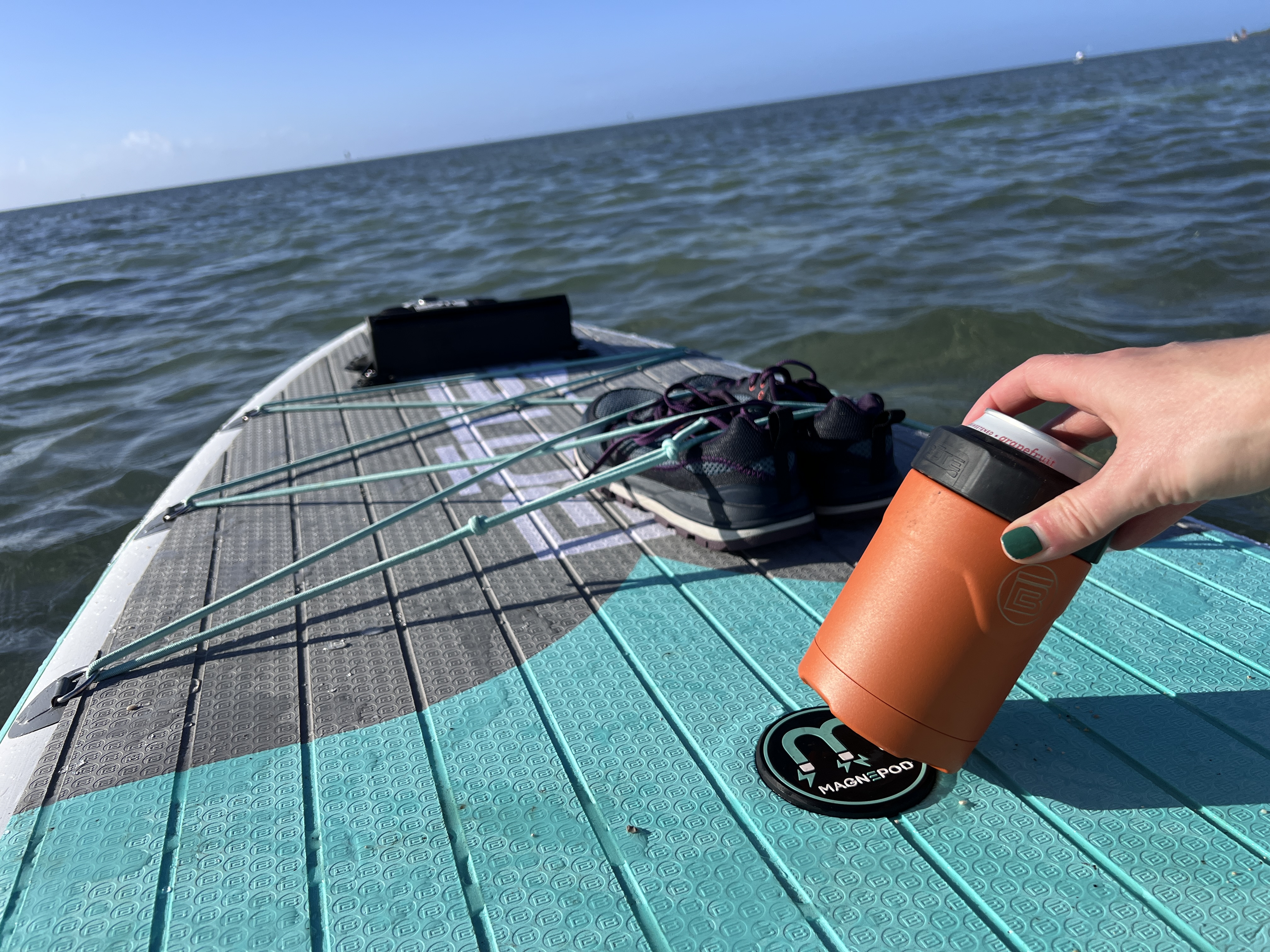
Attachment Systems
Various brands have designed in-house attachment systems to connect or hold branded gear — like water bottles or paddling seats — in addition to the front and back bungees or D-rings that you typically see.
In one approach, BOTE developed a patent-pending magnetic system, called MAGNEPOD. Selected boards have an integrated, flush neodymium magnet which can be used to hold compatible magnetized accessories like a compact waterproof speaker, water bottle, or a can cooler to hold your bubbly water or beer.
The magnet is super powerful and we had no issue with our bottle flying off while paddling choppy ocean currents. We had to make sure to swing our paddle high enough — so as to not karate chop the bottle — and tried to not splash water into our open canned beverage. But the magnetic system worked great.
A separate system, called Travelink, allows paddlers to attach a shoulder strap to the edge of their BOTE board for easier carry.
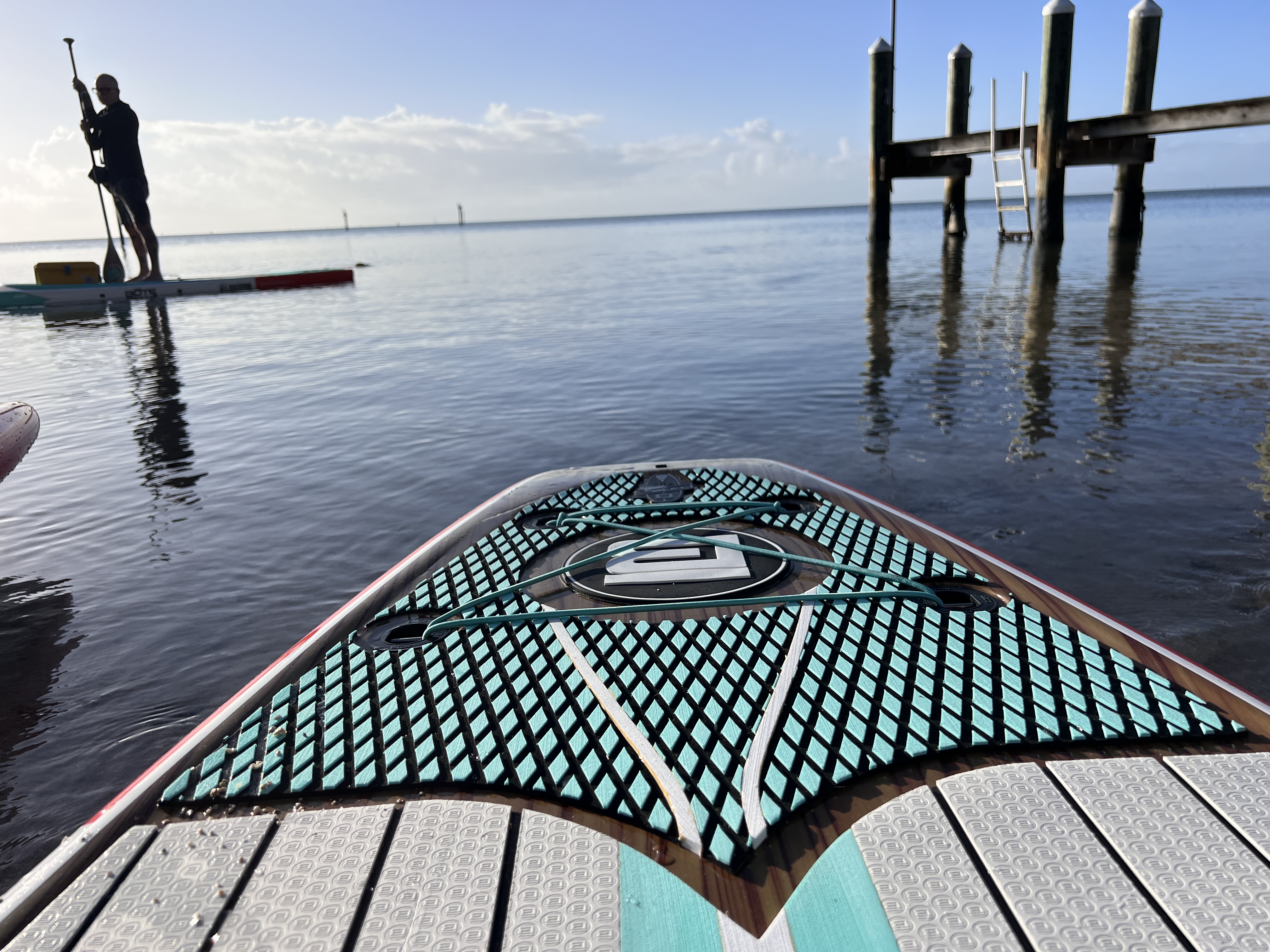
Pau Hana developed SeaMount, which are flush, threaded anchor points where you can attach accessories like D-Rings, a base plate — to then attach RAM balls, a pole mount — a cup holder, fishing rod holder and more.
ISLE has a patent-pending design called the ISLE-LINK system: custom G-hook and loops, which are extremely durable, run the entire length of the board — a whopping 40 links. The loops are compatible with the brand’s inflatable kayak seat and footrest, fishing crate, deck bag, and the versa strap — a shoulder strap you can use for hand-free carry — and other in-house aftermarket gear.
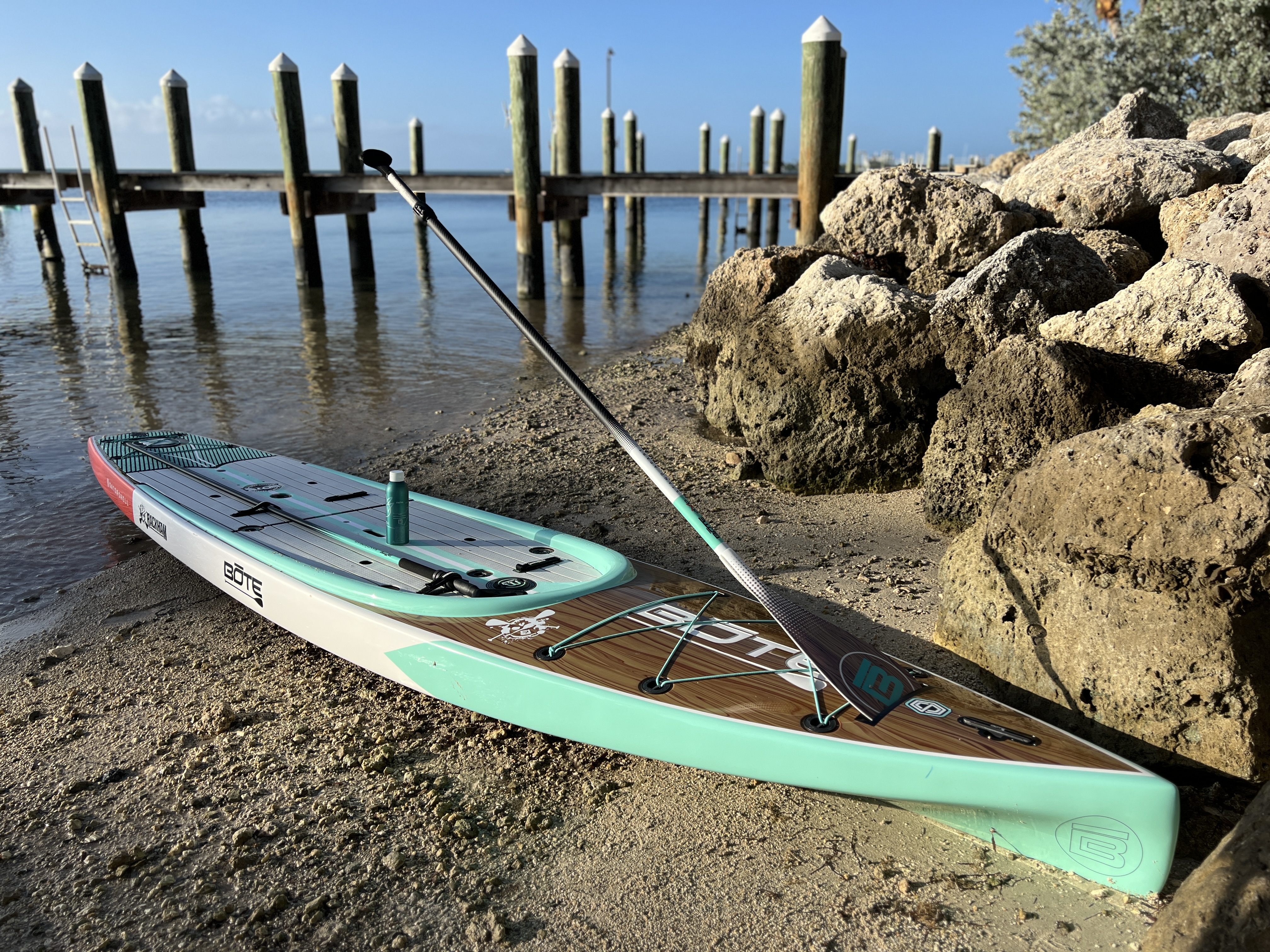
Warranty Plan & Recycling Your SUP
Check your SUP’s warranty plan. We’ve experienced incidents outside of our warranty, including retired boards that had a 5-year warranty. Some brands, including Hala Gear, will take back retired SUPs and reuse the materials to keep waste out of landfills — like repurposing the deck pads as floor mats. Or using the interior drop stitch for educational videos and displays.

Product Lifespan
Based on our experience, you could generally expect the lifespan of a premium whitewater SUP to reach around 7 years. That’s if the board is built with double-glued, mechanically welded seams — and it’s not been hammered by pup feet or dragged across asphalt.
According to Hala Gear, the standard minimum life expectancy on all of the boards they produce is the same timespan. That said, the final blowout we’ve experienced (after 7 years) was a reinforcement of the red flags of wear-and-tear, general maintenance, as well as prevention.

Price & Value
Our favorite SUPs range from $499 to $1,399 on the high end. Typically, SUPs cost around $1,000.
You’ll also want to consider if any accessories are included in a bundle. Two of the most useful additions in a package are a paddle and a storage bag. Paddles can cost hundreds of dollars.
Budget
The lowest-priced SUPs are still quite durable, but their seams, rails, and plastic will generally not be as durable and reinforced as a premium build. These models are great for entry-level paddlers or folks who keep their day trips mellow on flat water.
Options include the Boardworks SHUBU Riptide ($500) or BOTE WULF Aero 10′ 4“ ($499). All of those SUPs come with a travel bag, fins, a pump, and a paddle.
You’ll also notice that these boards have fewer attachment points for strapping down gear (they can’t handle as much weight, anyway) and fewer or leaner grab handles.

Mid-Tier
In this zone — still under $1,000 — you’ll see an uptick in attachment points, weight capacity, higher-end construction, and grab handles. These SUPs are great all-rounders and sturdy enough for whitewater. Some have a higher weight capacity and are great for long tours and speeding across water, like the iRCOKER Blackfin CX ($949), which includes a bag, paddle, pump, and fins in its base price tag.
Others incorporate more technical materials for rigidity, like the Isle Pioneer Pro ($995), which includes a pack and fin but not a paddle or pump. The benefit is that paddlers can customize the paddle and pump they’d prefer to own in the long run.
Premium
The most premium models cashing out above $1,000 are the most well-constructed boards. These are the whips you want to use on whitewater adventures, fishing trips, or multiday camping trips. These designs have welded seams, multiple layers of composite material creating the outer shell, many soft and ergonomic grab handles, lash points in every direction, metal D-rings, and adaptable, high-end fins. In this arena, you’ll find the Hydrus JoyRide ($1,165) with a pump, fins, and bag (and the paddle is sold separately). Other premium boards like the Pau Hana Endurance Air ($1,249) with 23 D-rings. A pump, fin, paddle, and bag are included in that price, too.

Frequently Asked Questions
There is no “best” brand. However, some SUP brands have been around long enough that we’d consider them at the top of the market. The list is short: NRS, Blackfin, Starboard, BOTE, and Hala Gear. More top brands are emerging, including ISLE (founded in 2008), Glide, and Atoll (both founded in 2014).
Also, there is a range of product quality based on the materials that are used to make each SUP. For instance, metal d-rings are more durable and typically cost more than alternative cloth designs or eliminating the tie-down point from the board.
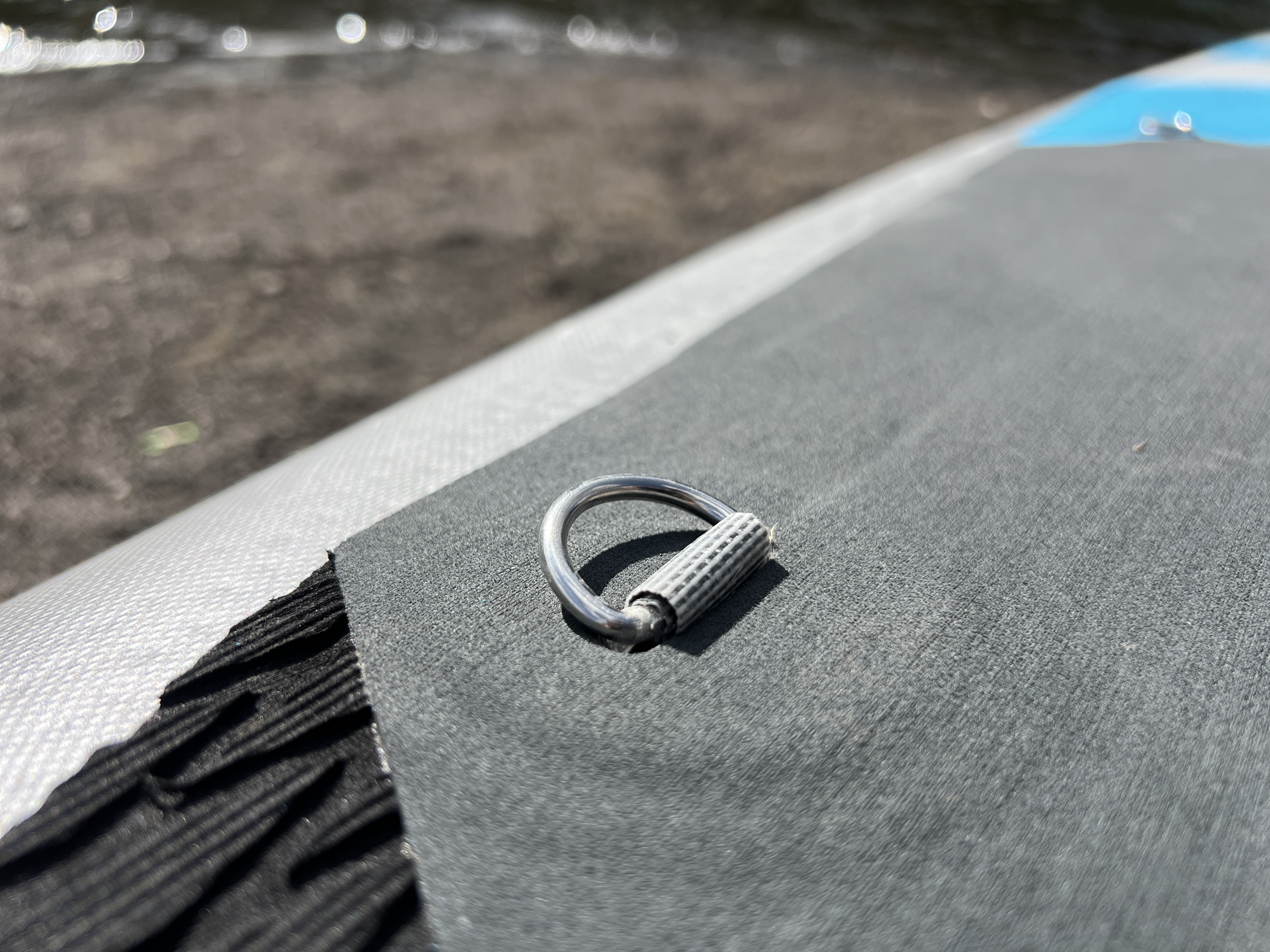
As noted in the intro, the inflatable SUP market has skyrocketed over the past 6 or so years. Why? Inflatable boards are fantastic. You don’t need a special roof rack, garage, or special straps to carry a 12-foot, 40-pound piece of gear around.
All you need is an oversized backpack and some space in your trunk. Inflatable boards, by nature, deflate and pack down small. They’re easy to travel with, are fairly easy to care for and maintain, and come in at a great price.
Even better, almost all inflatables (all the ones we’ve listed) come in a package: SUP, paddle, backpack, fin, and pump. There’s no need to buy any SUP gear separately. That being said, the quality of inflatables does vary widely based on materials, construction, and design. The stability and feel of the board are a little different.
If you know you want to invest in the sport or are going to be paddling in extremes (cold or whitewater), you’ll want to spend extra time researching a board’s construction (welded seams, thicker PVC) and performance in your intended environment.
Width, length, sidewall depth, as well as overall shape are all factors that contribute to a board’s stability.
All of the standup paddleboards we’ve included here are relatively stable, but we’d mark the 11’6″ BOTE HD Aero as a very stable choice. This is due to its width, sidewalls, weight capacity, and overall construction. This is a middle-of-the-pack, not-too-heavy, and well-balanced board that measures a full 34 inches across.
It has an optional kayak seat if you are looking to feel extra grounded and stable on your board. And the HD Aeros also clocks in at a great price point for its size.
If stability is a priority, boards that are made for fishing expeditions, yoga SUPs, and touring are commonly a bit wider across. Any board that is 34-36 inches across is generally a good choice.

The best SUP for beginners is the one that fits you best. For most people, that’s a board that is larger so it has a higher weight capacity and provides more stability to accommodate riders of different weights (say, if you’re sharing a board with your partner). We frequently recommend an inflatable model as a first board due to its durability and ease of storage.
Contrary to newbie beliefs, inflatable boards are very durable, can pack down small, are convenient and easy to use and store, and are usually more budget-friendly. Even better, if you learn on an inflatable SUP, you’ll have great balance for when you decide to tackle ocean or whitewater paddling or upgrade to a rigid board.
Also look for a board with a softer hull and less aggressive shape, which will help with maneuverability versus speed.
Our recommendation would be to look for an inflatable board at least 10’6″ or 11′ in length, with a weight capacity of at least 230 pounds.
Always inflate to the recommended psi. You want to keep the maximum weight in mind if you have two riders, whether two adults or an adult, and cargo (dog or kid). If you are a heavier rider and want more stability, feel free to inflate to the maximum recommended psi when starting out.
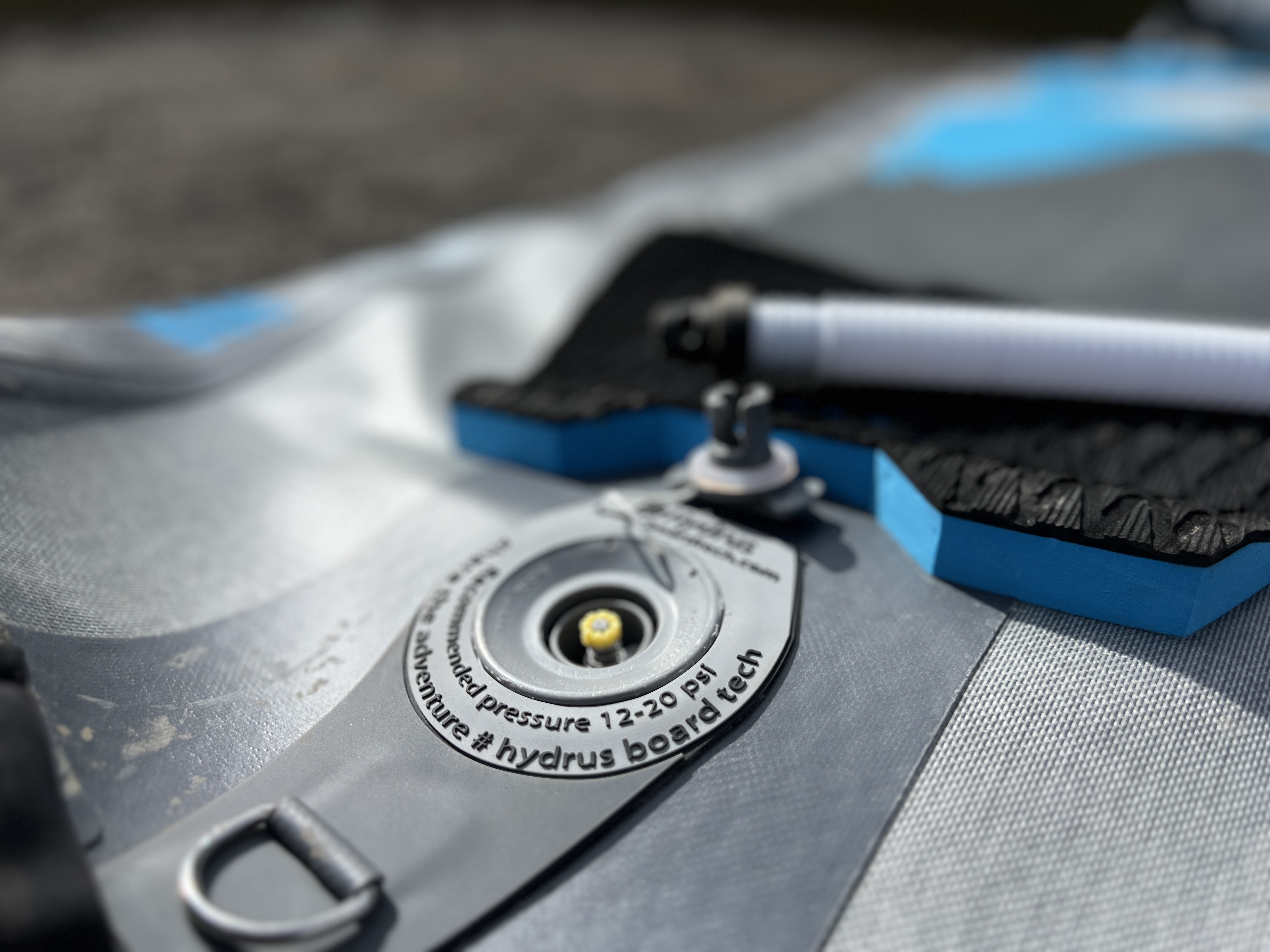
Invest in some boat cleaner for your SUP. An inflatable boat cleaner is designed to remove any dirt, oxidation, and marks from a SUP or kayak (works on PVC or urethane materials). Alternatively, you can wipe down your board after use with a damp cloth. This is crucial if you are paddling frequently in saltwater.
We always carry a soft microfiber towel in the trunk. If we’re hiking in, we carry a lightweight towel and brush the dirt off the board as we roll it up for the hike out.
Inflatable SUPs can be deflated, rolled up, and easily stashed inside a truck bed or inside your rig.
If you plan to transport a SUP on the outside of your vehicle, be sure the board is completely locked down and secured. For instance, Thule makes a SUP roof rack and Viking Solutions makes a truck bed rack.
SUPs that are sketchily or incorrectly fixed to vehicles can fly off and into the windshields of rigs behind them. Be sure your board is correctly affixed.
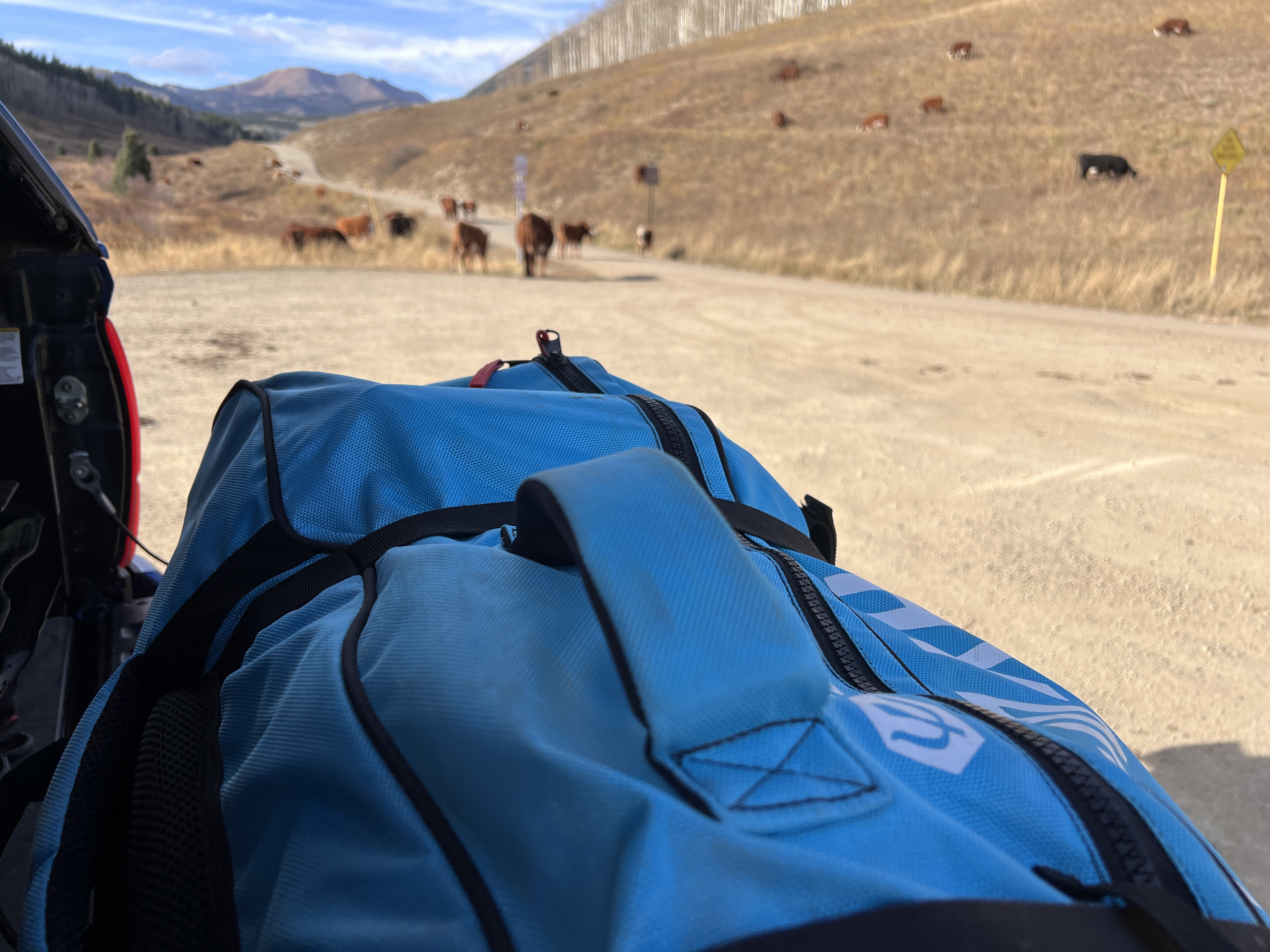
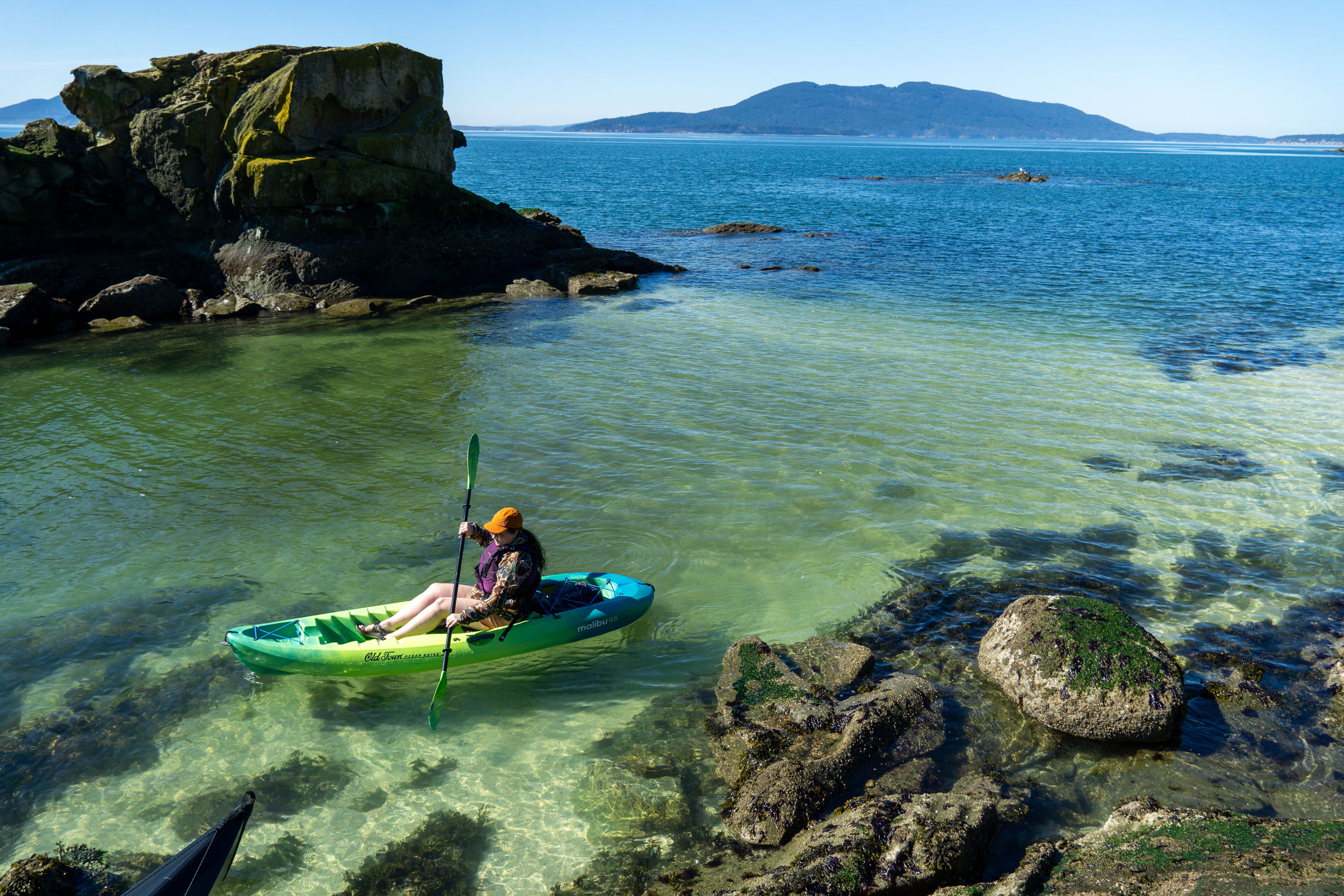
The Best Kayaks for Beginners of 2026
The sport of recreational kayaking has been rapidly growing over the past several years, and there are hundreds of kayak options on the market. Here are the best kayaks and the gear you need to get started.

The Best Dry Bags of 2025
Need to keep your gear safe and dry? We tested and reviewed the best dry bags including top picks from YETI, SealLine, NRS, and more.
